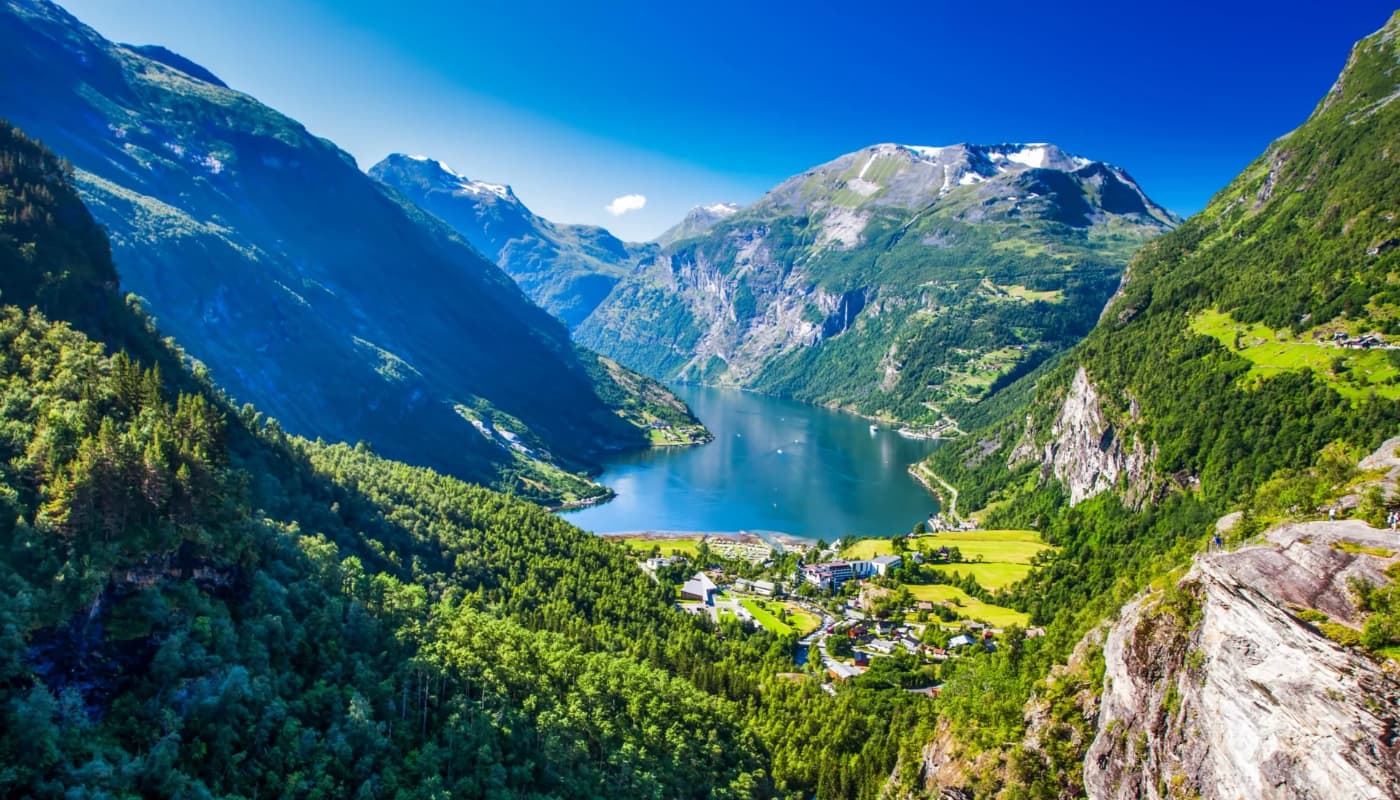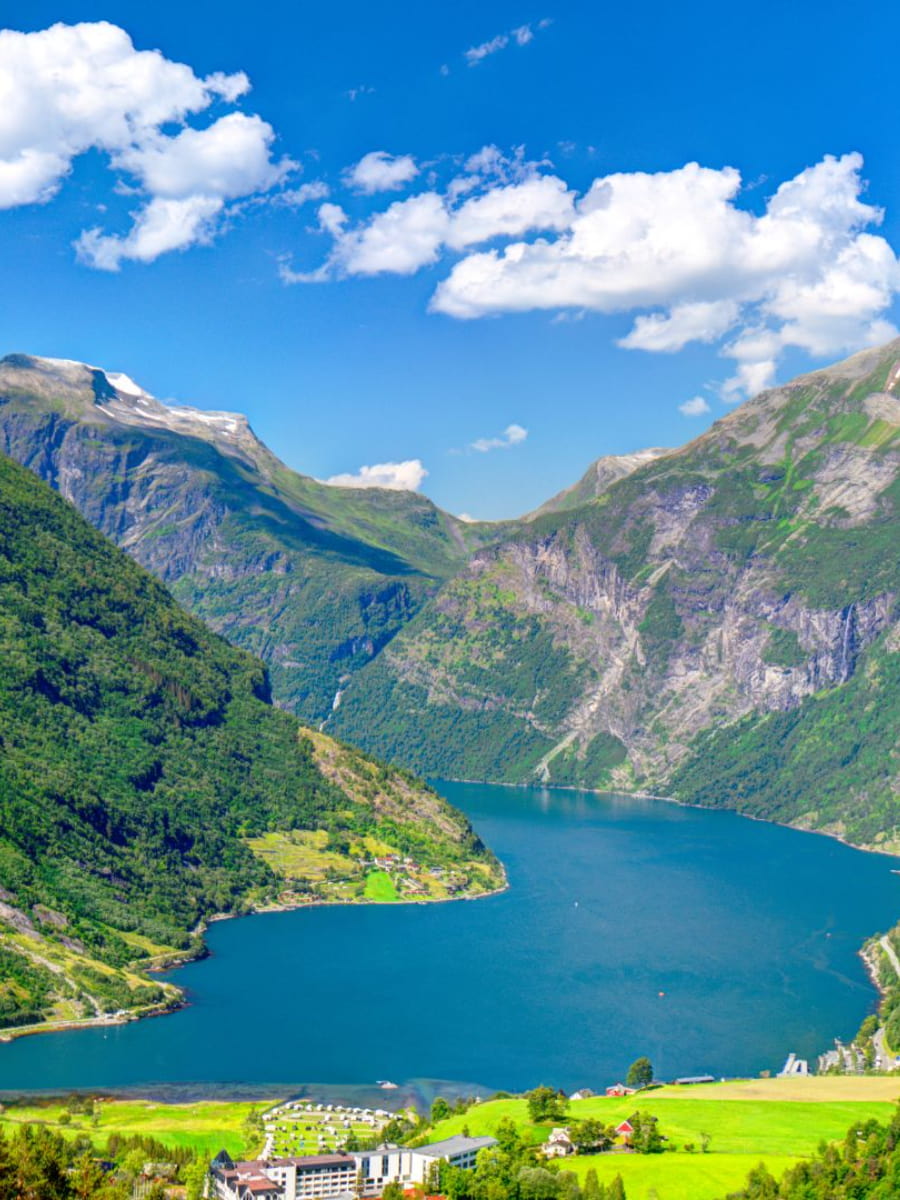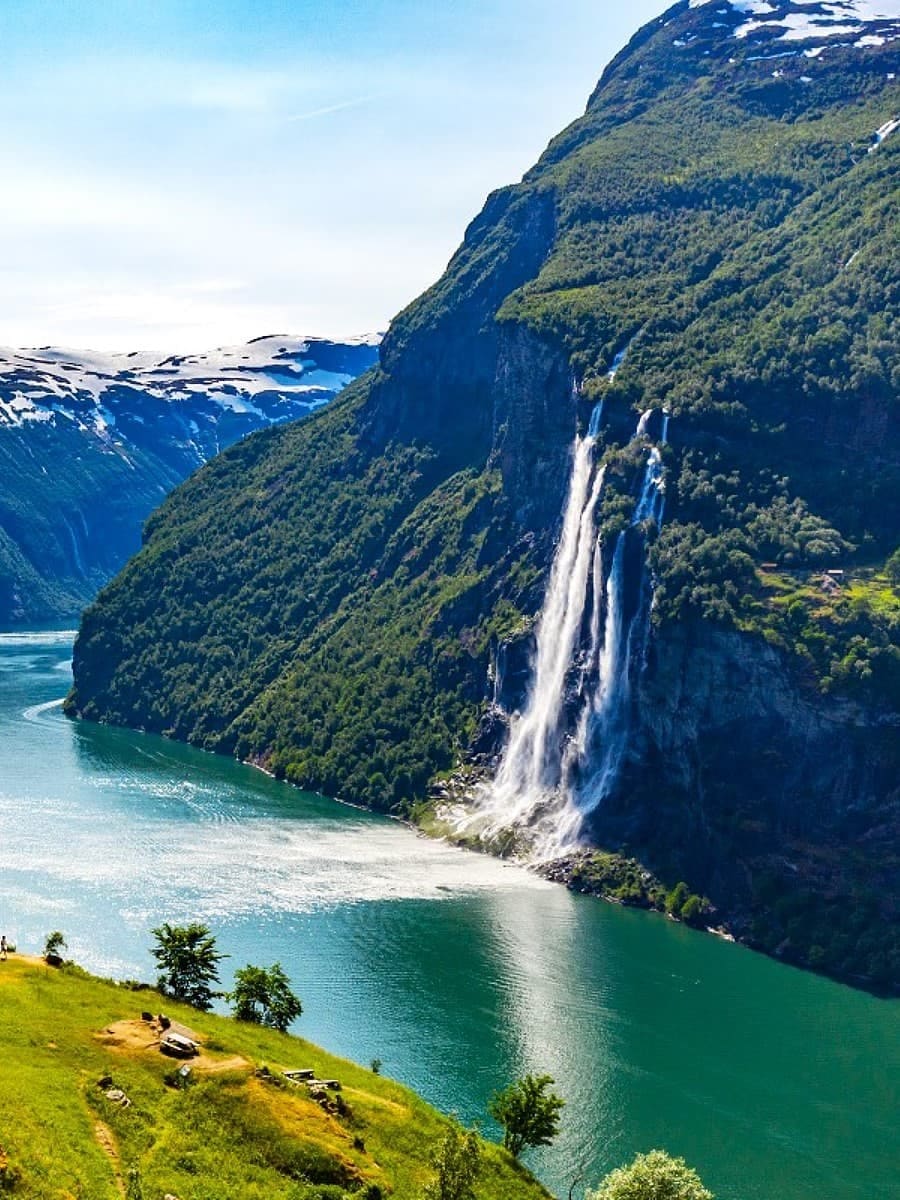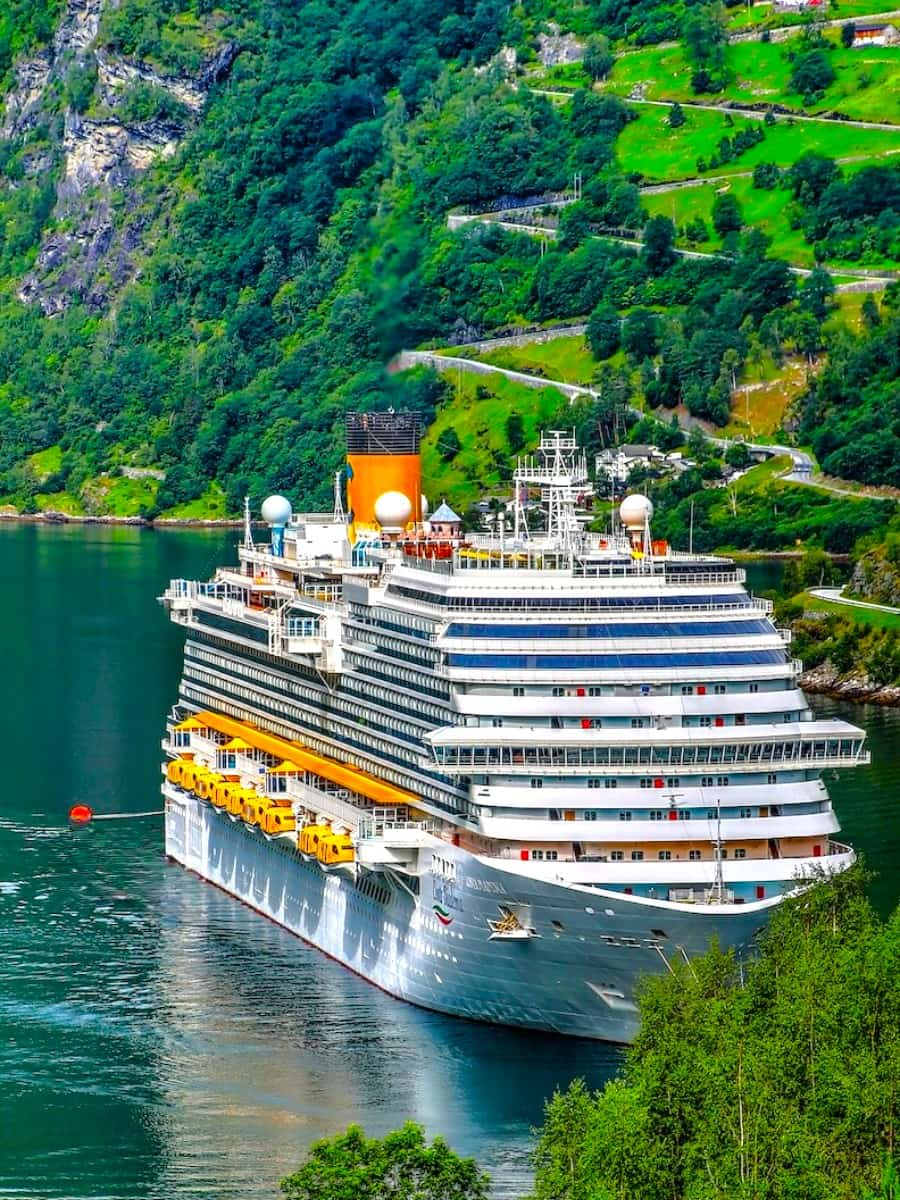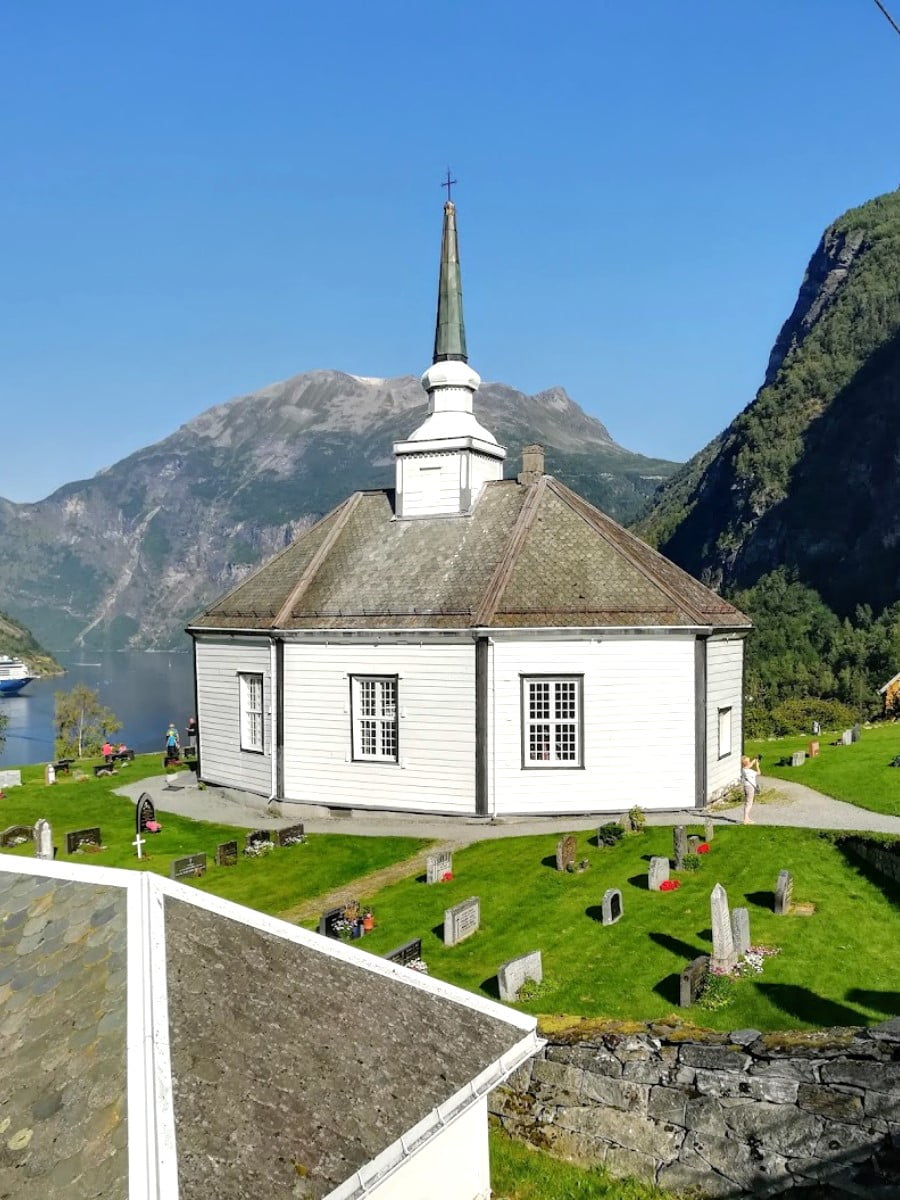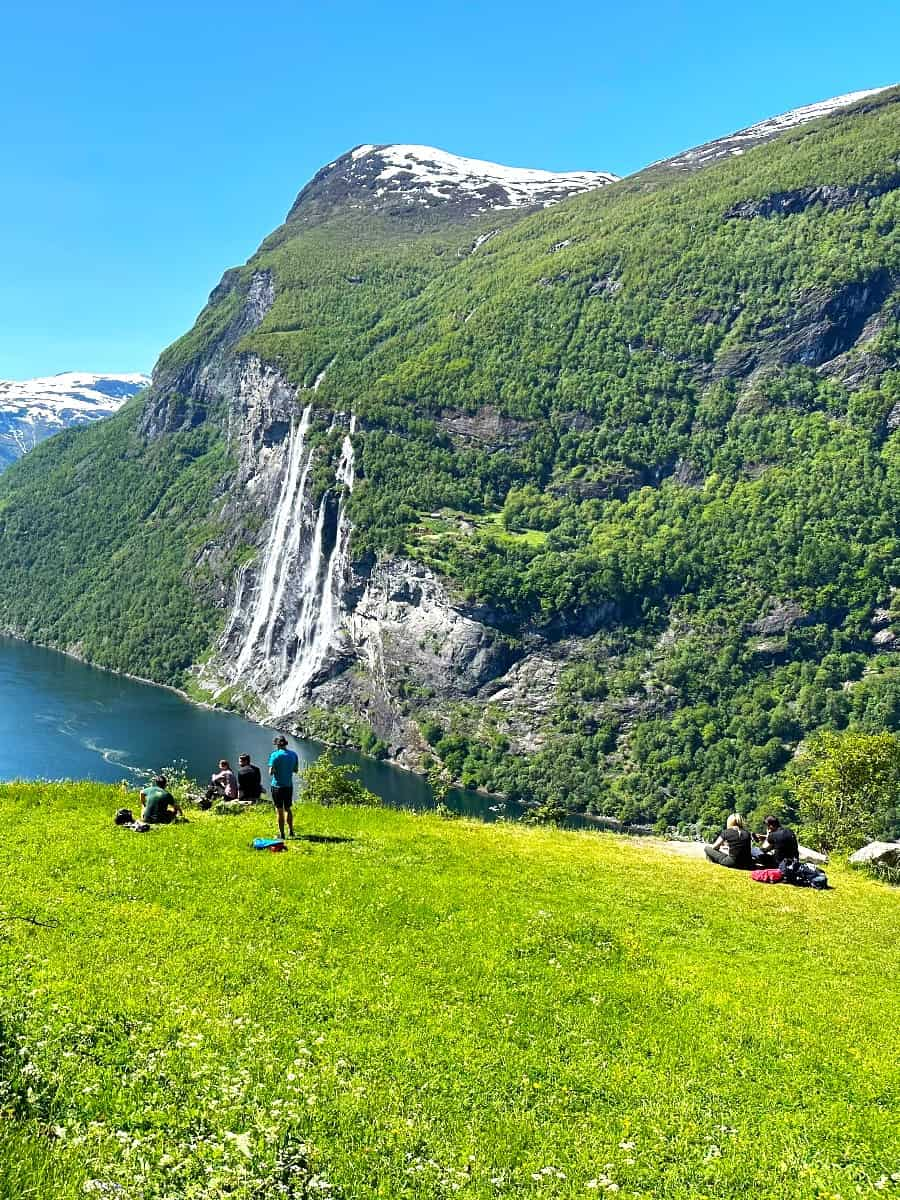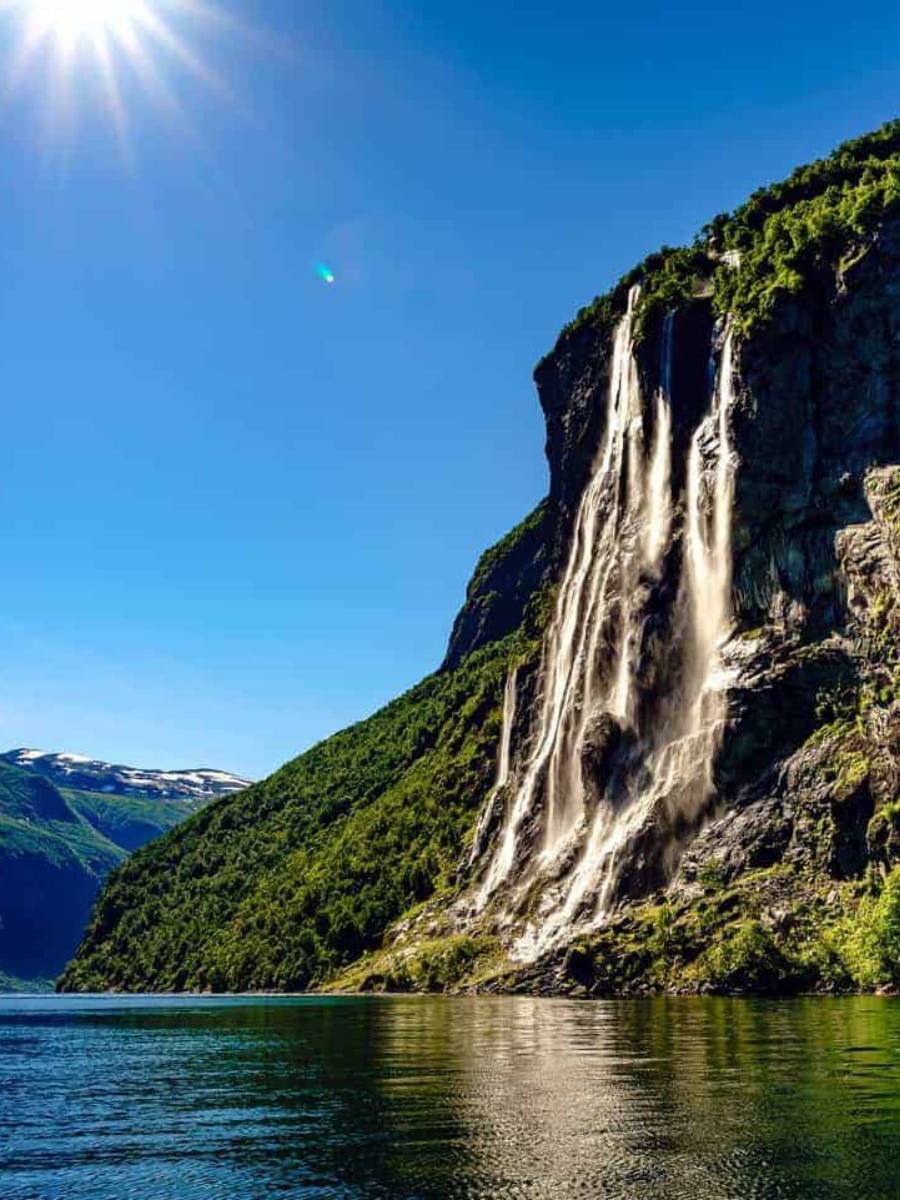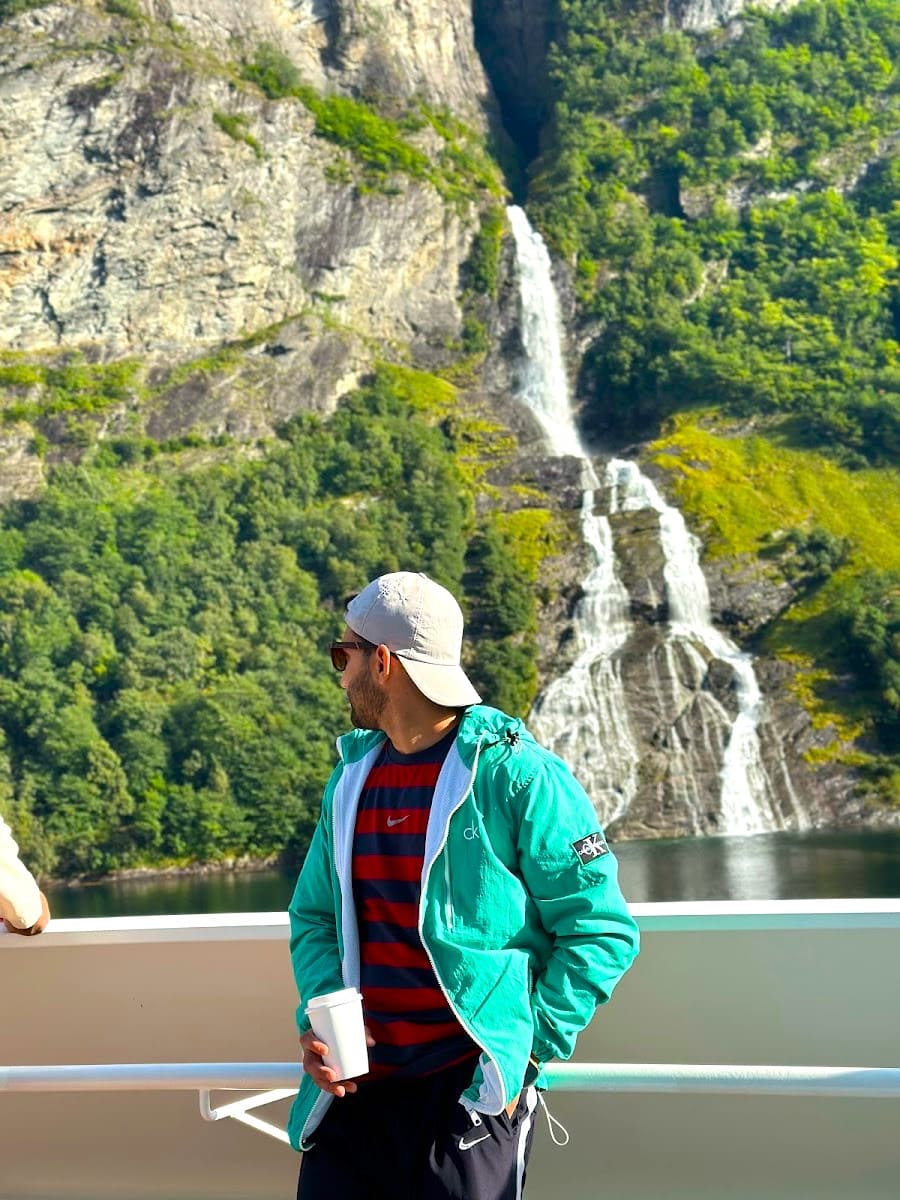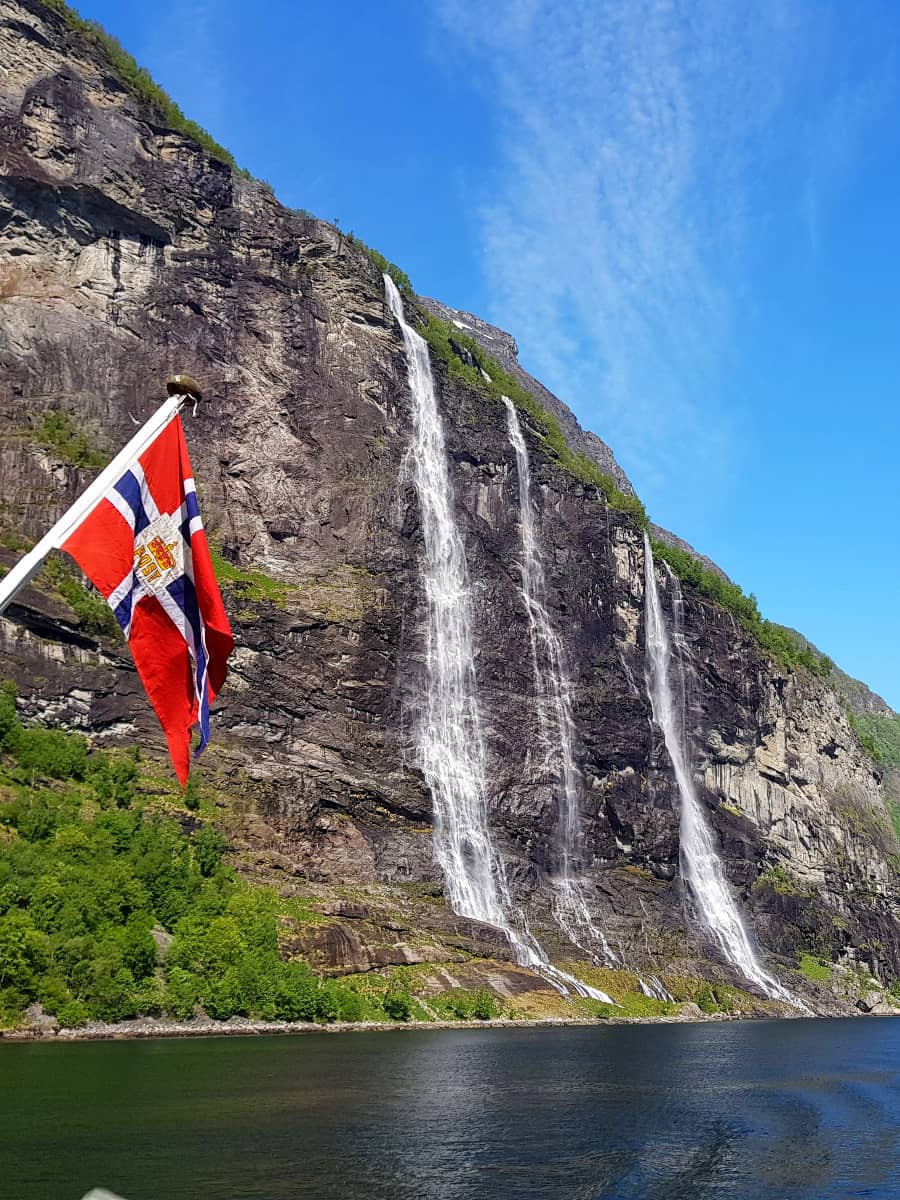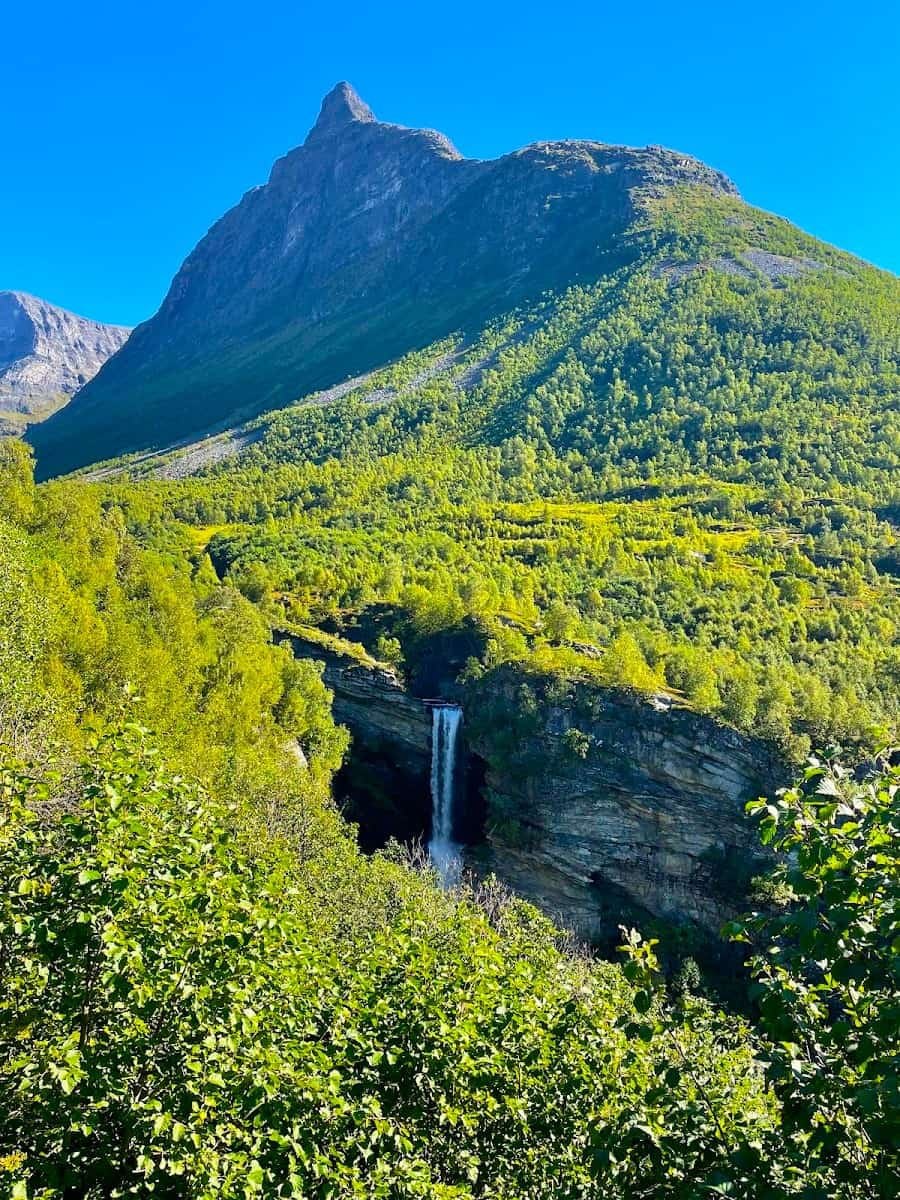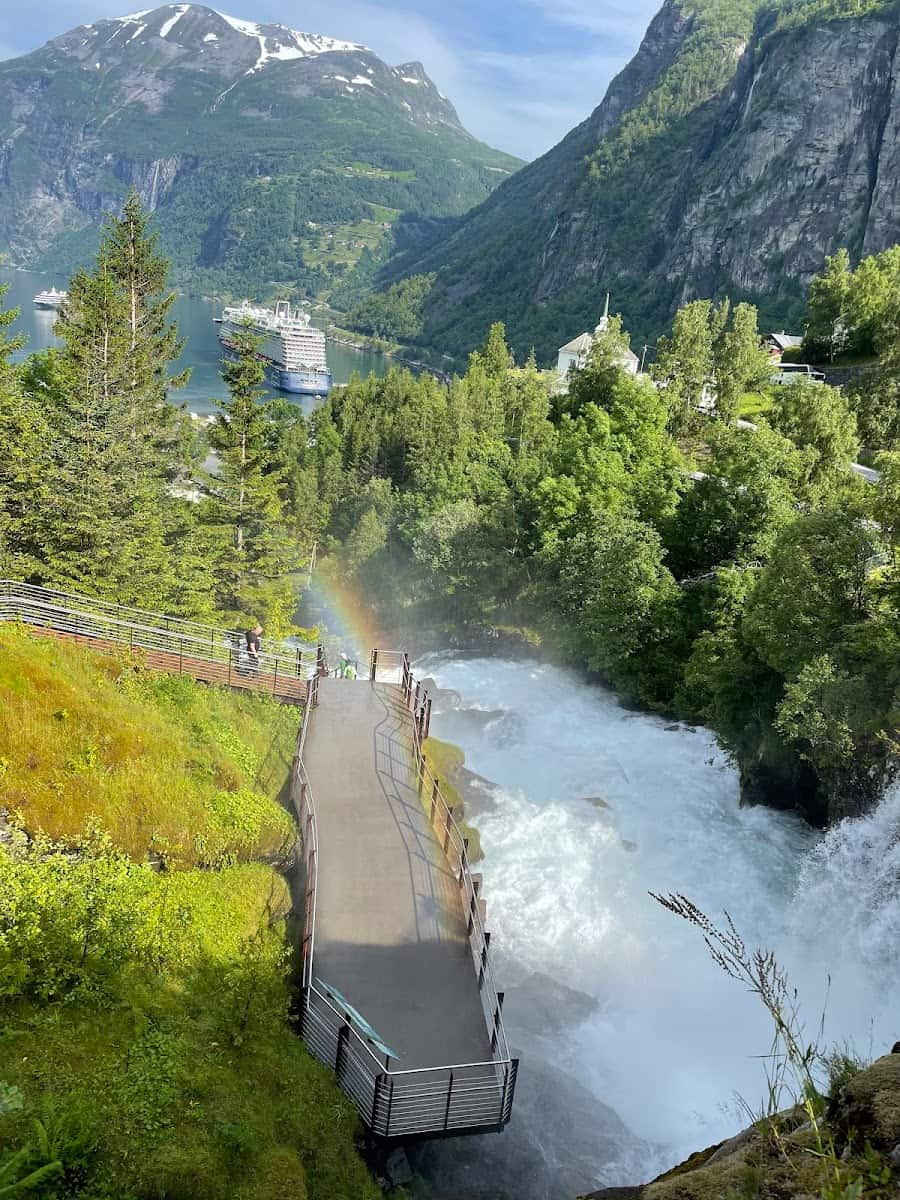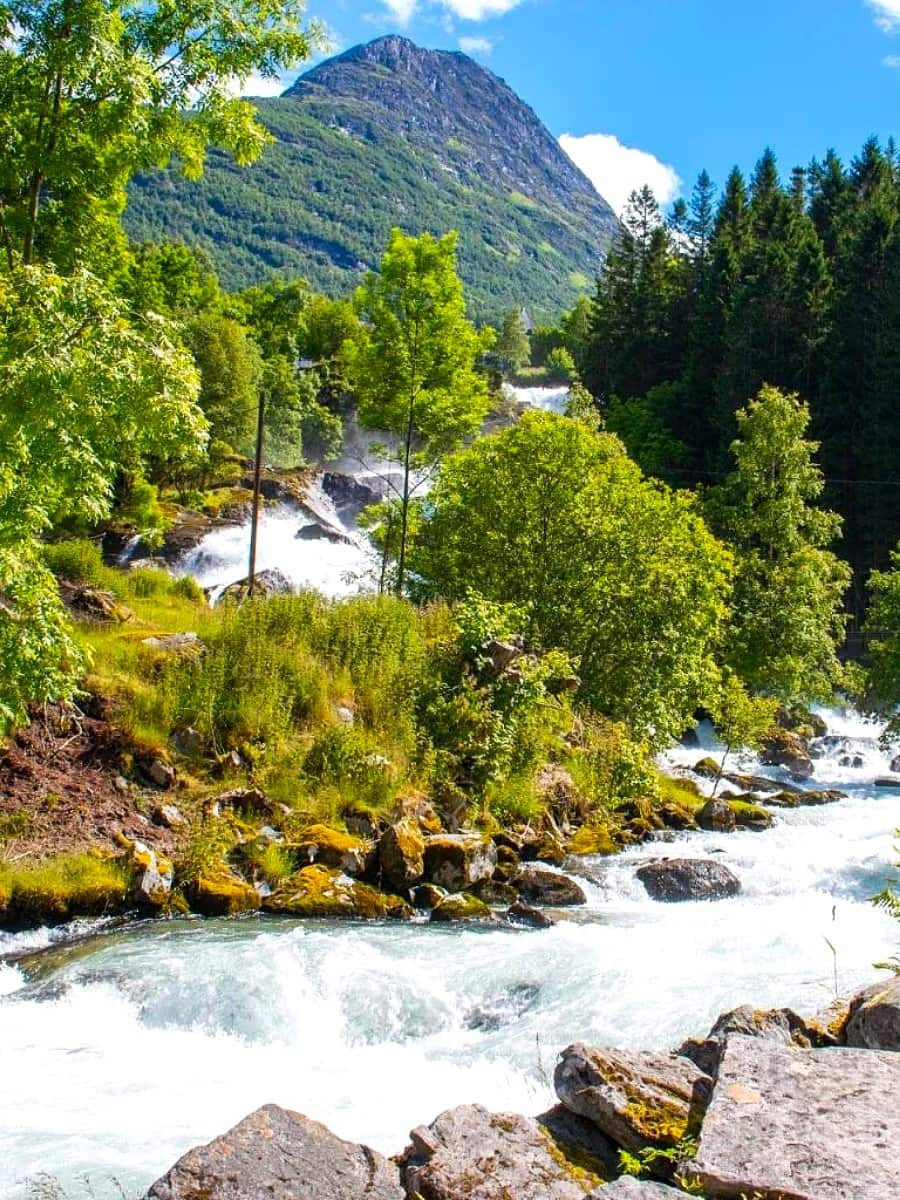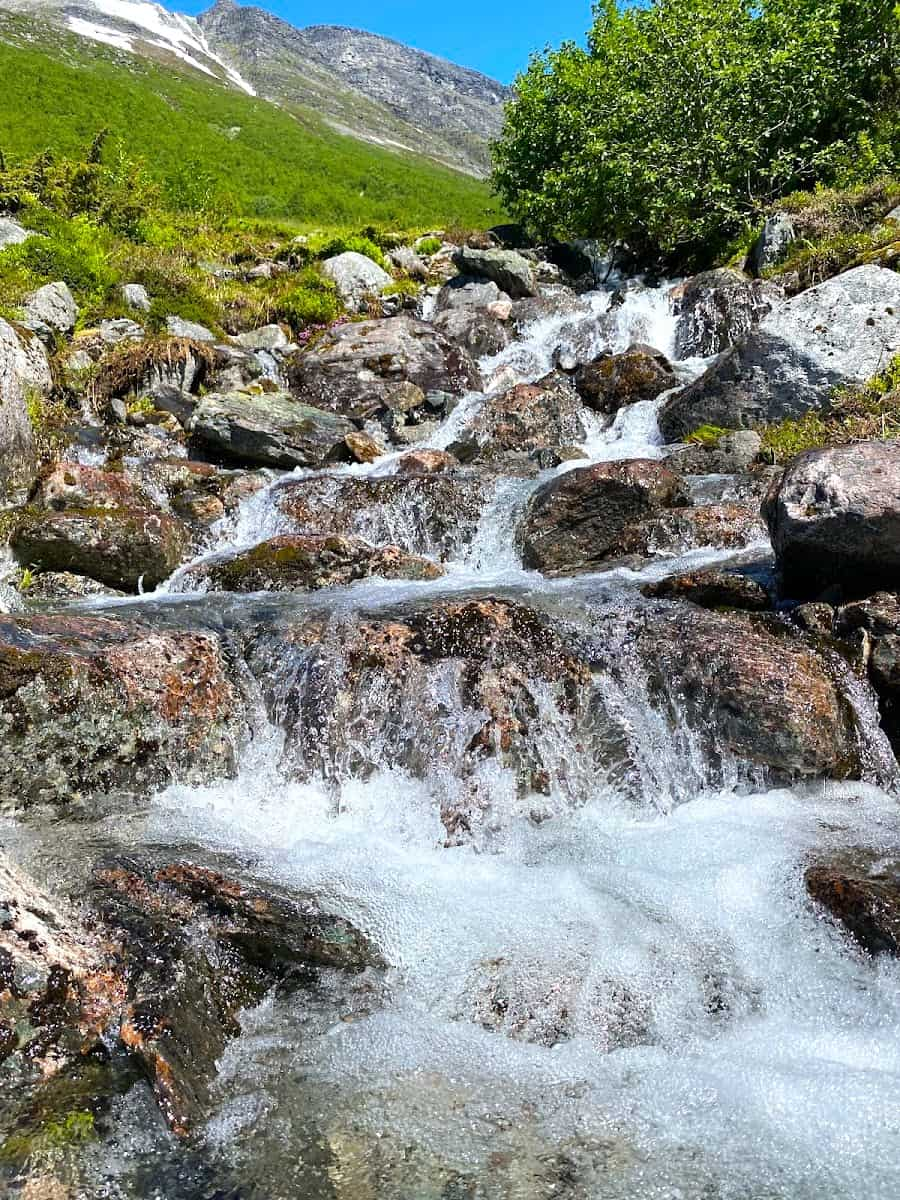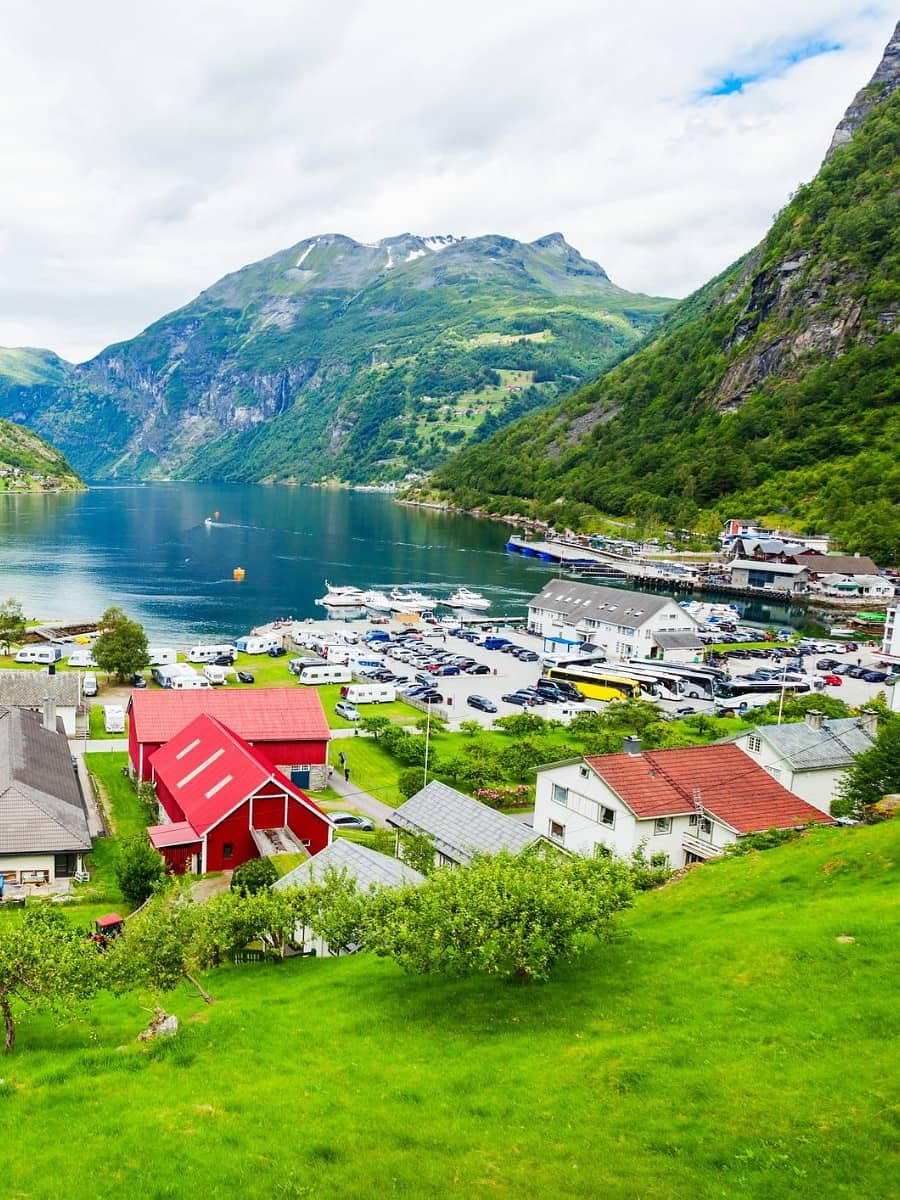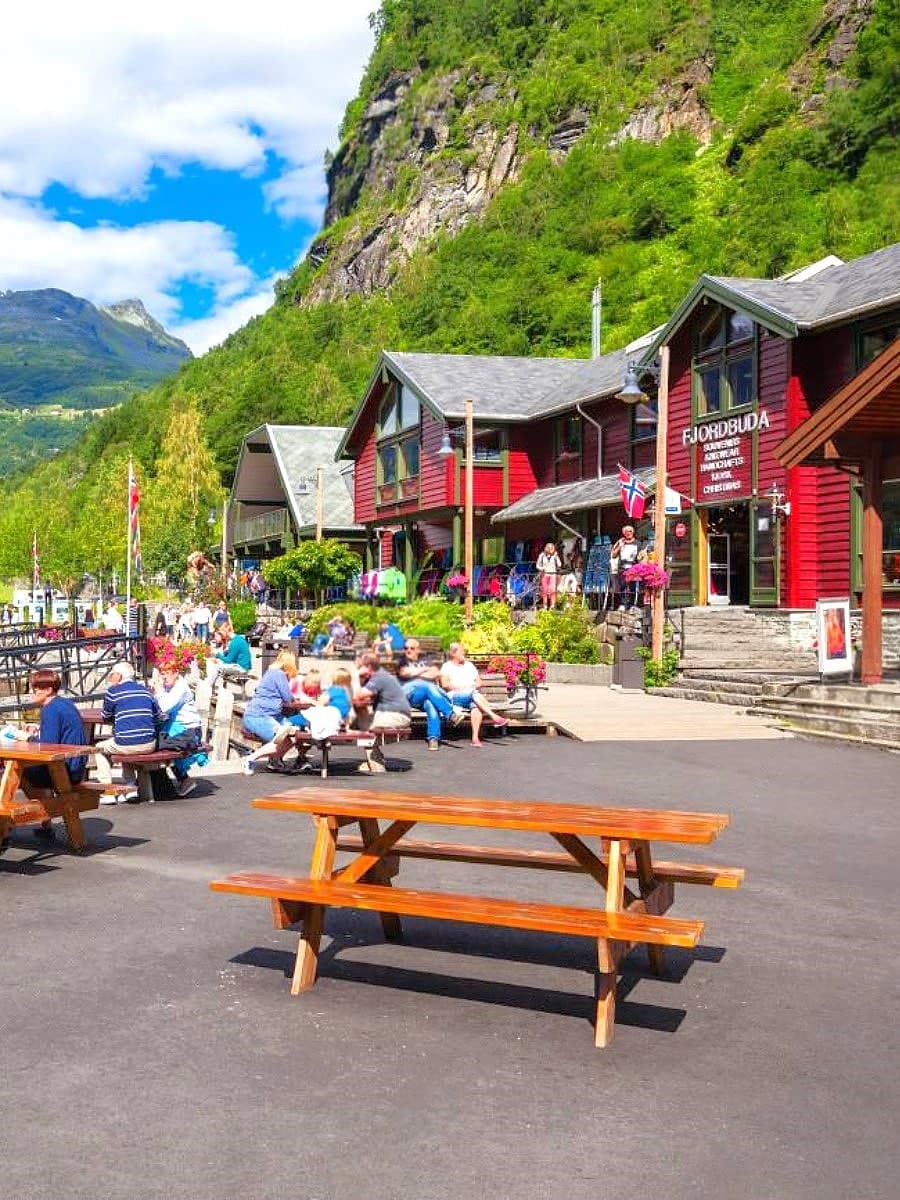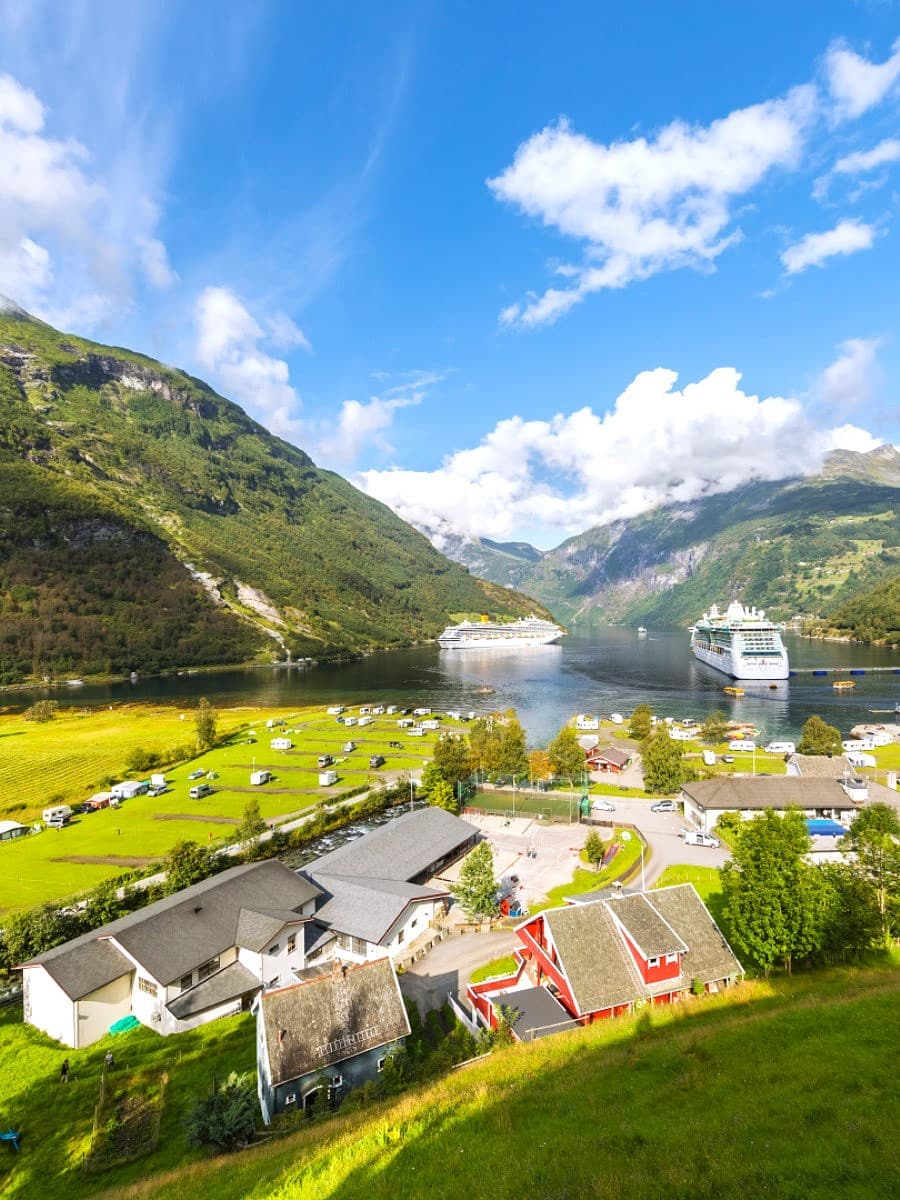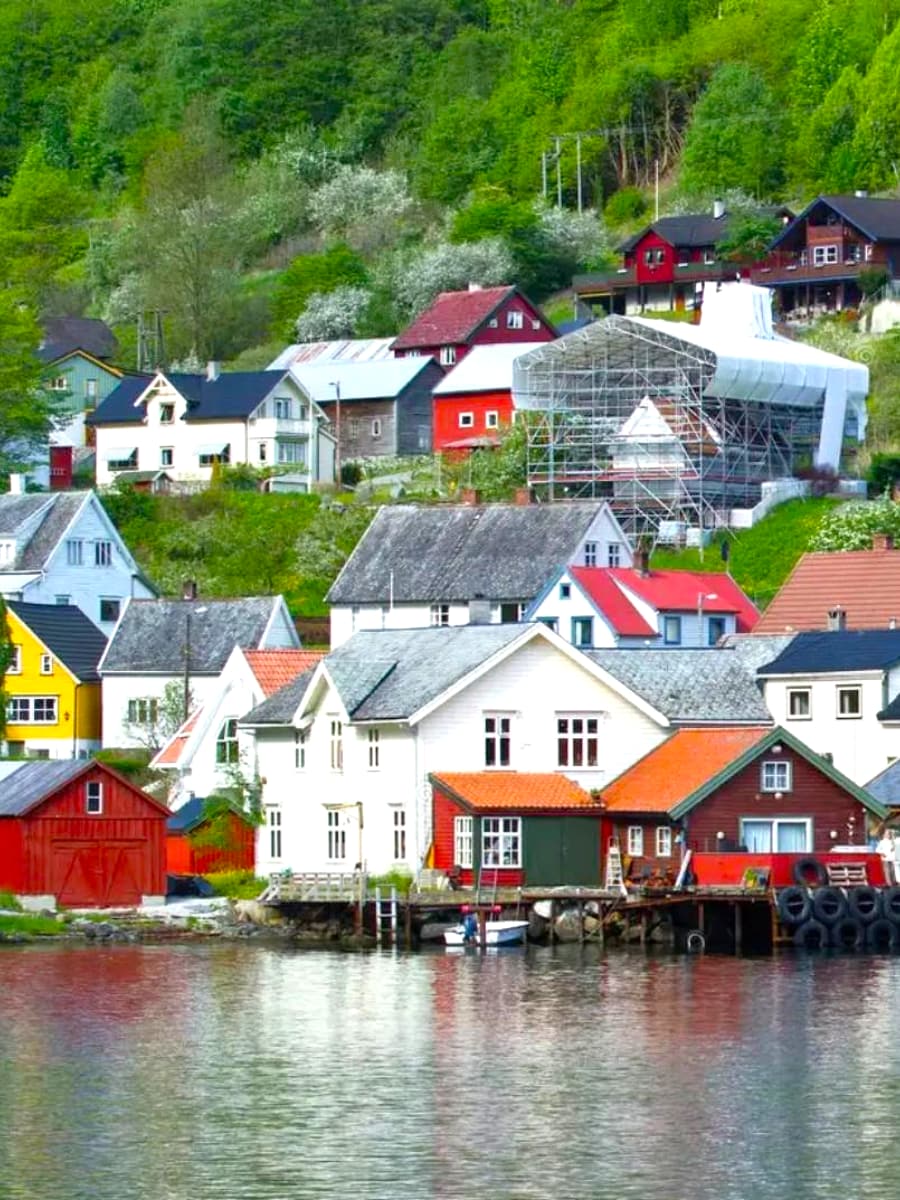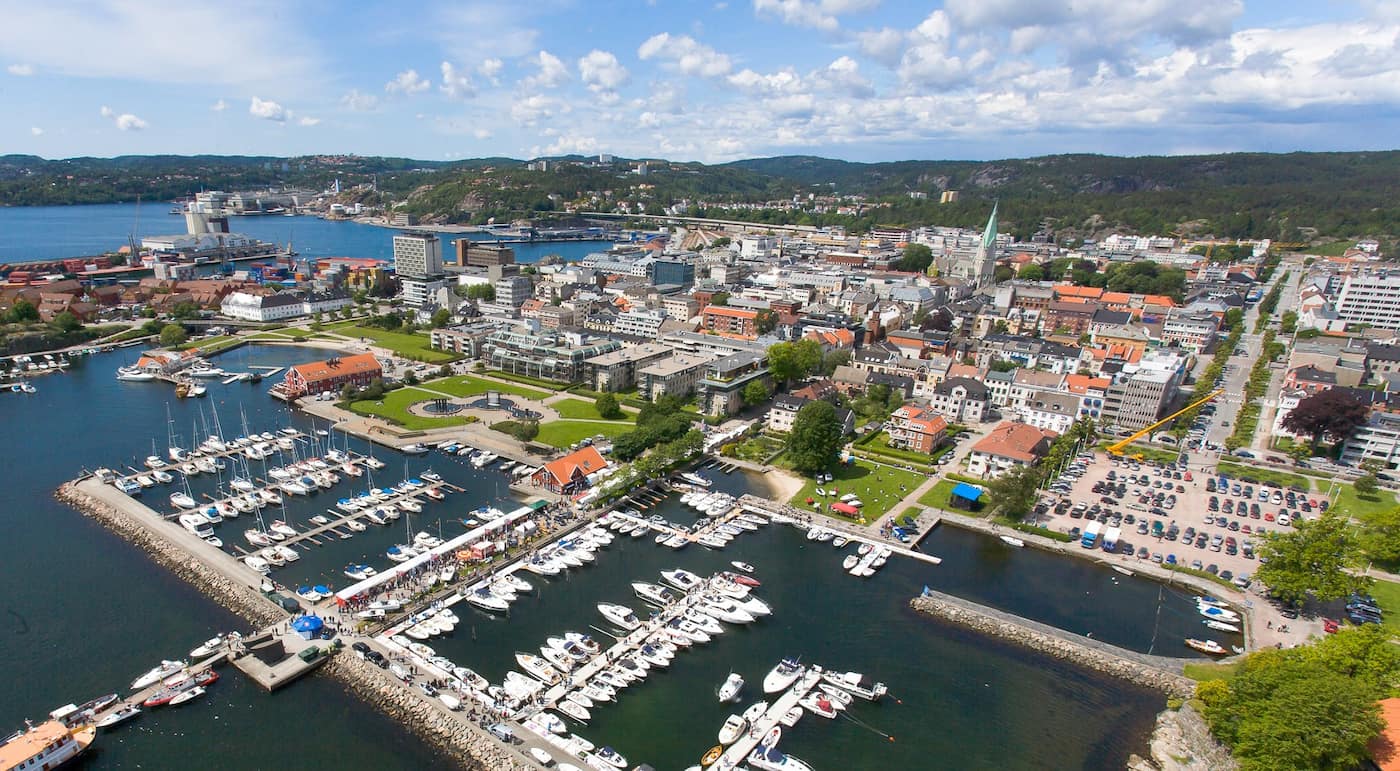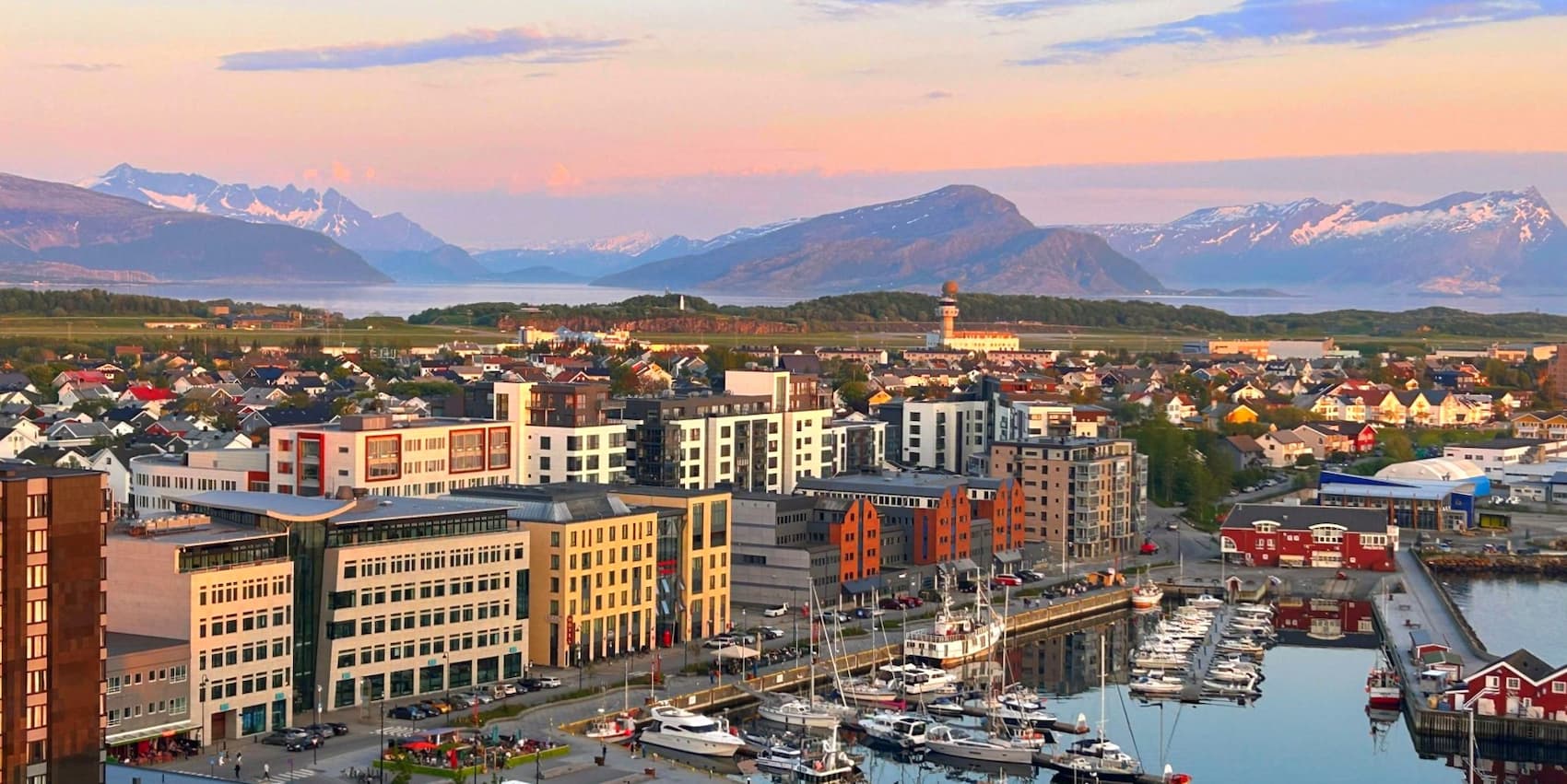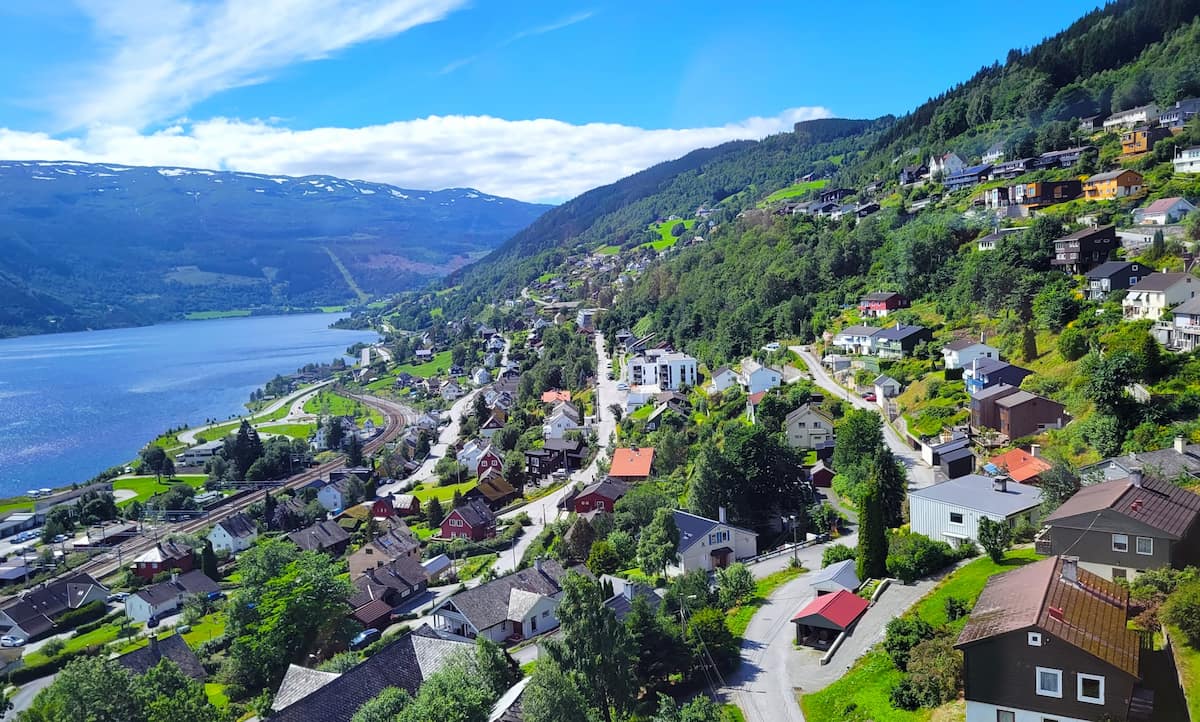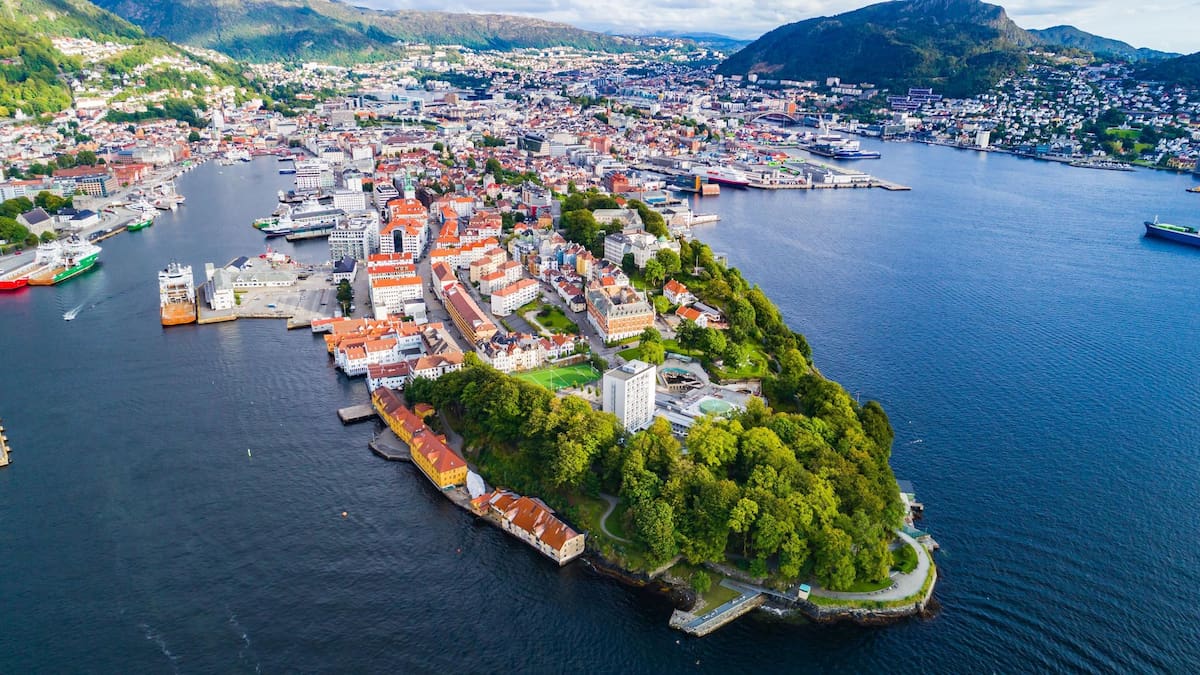Nestled in the heart of Norway’s fjord region, Geiranger offers some of the most breathtaking natural scenery you’ll ever encounter. The small village sits at the head of the UNESCO-protected Geirangerfjord, where dramatic waterfalls cascade down steep mountain sides and crystal-clear waters reflect the surrounding peaks.
I’ve explored this magical place several times and discovered activities for every type of traveler, from adventure seekers to families with young children. Whether you’re planning a day trip or a longer stay, this guide covers everything you need to know about making the most of your time in this Norwegian paradise.
🏠 Where to Stay in Geiranger
- 💎 Luxury Hotel: Hotel Union Geiranger Bad & Spa, Geiranger
- 🏨 4-Star: Grande Fjord Hotel, Geiranger
- 🛏️ 3-Star: Havila Hotel Geiranger, Geiranger
- 🏢 Apartment: Geirangerbooking, Geiranger
- 👨👩👧👦 For Families: Lunheim in Geiranger, Geiranger
- 🏩 For Couples: Hotel Utsikten - by Classic Norway Hotels
💁 Best Guided Tours
- Geirangerfjord and Waterfalls, Small-Group RIB Safari from € 85 (⭐4.8/5)
- Geiranger Shore Excursion: Mt. Dalsnibba and Eagle Road from € 75 (⭐4.9/5)
- Geiranger Sightseeing Tour: Dalsnibba Skywalk & Eagle Road from € 79 (⭐4.7/5)
- Geirangerfjord Tour from € 65 (⭐4.8/5)
Best Things to Do in Geiranger, Norway
1. Geirangerfjord Cruise
Spectacular views. Taking a fjord cruise on the UNESCO-protected Geirangerfjord was honestly the highlight of my Norwegian adventure. I boarded at the harbor in Geiranger, where several operators offer different cruise options ranging from 90-minute sightseeing tours to longer expeditions.
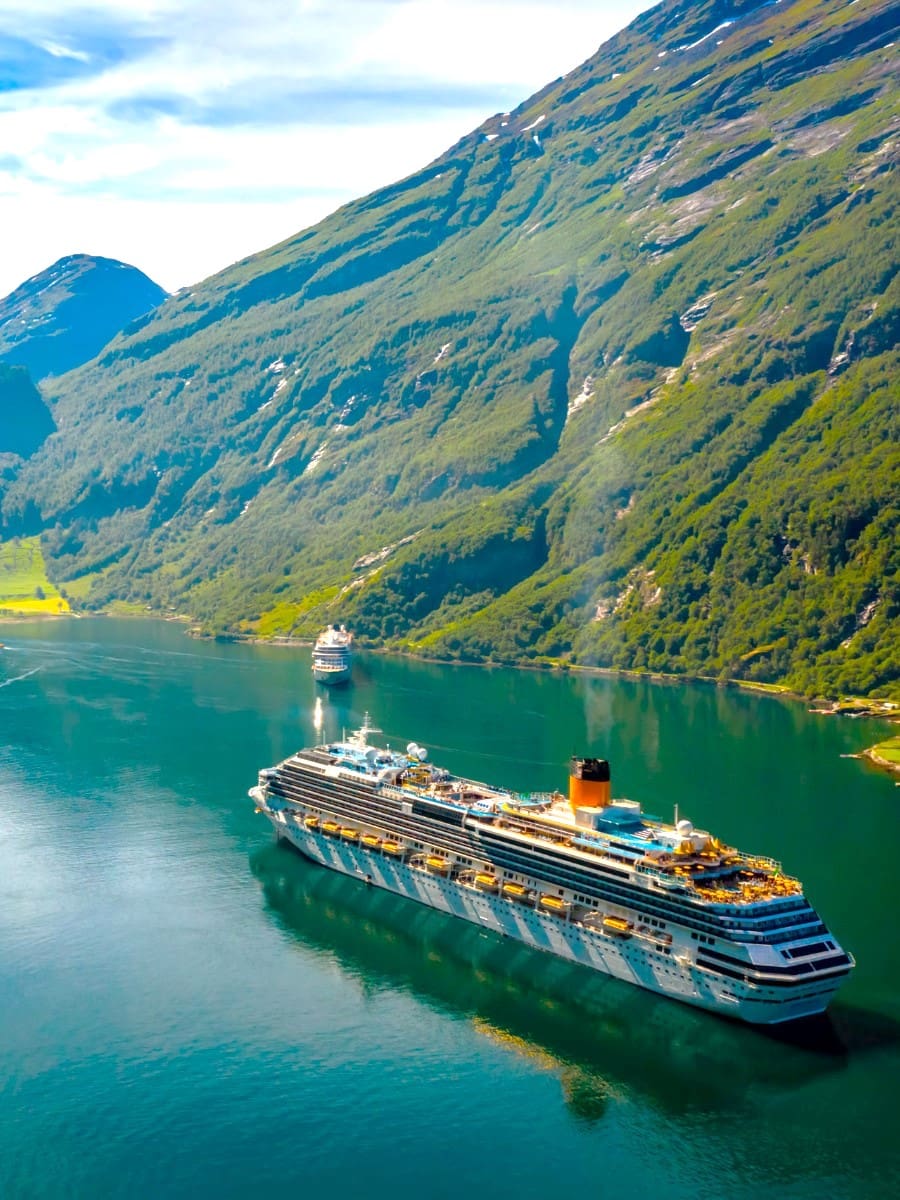
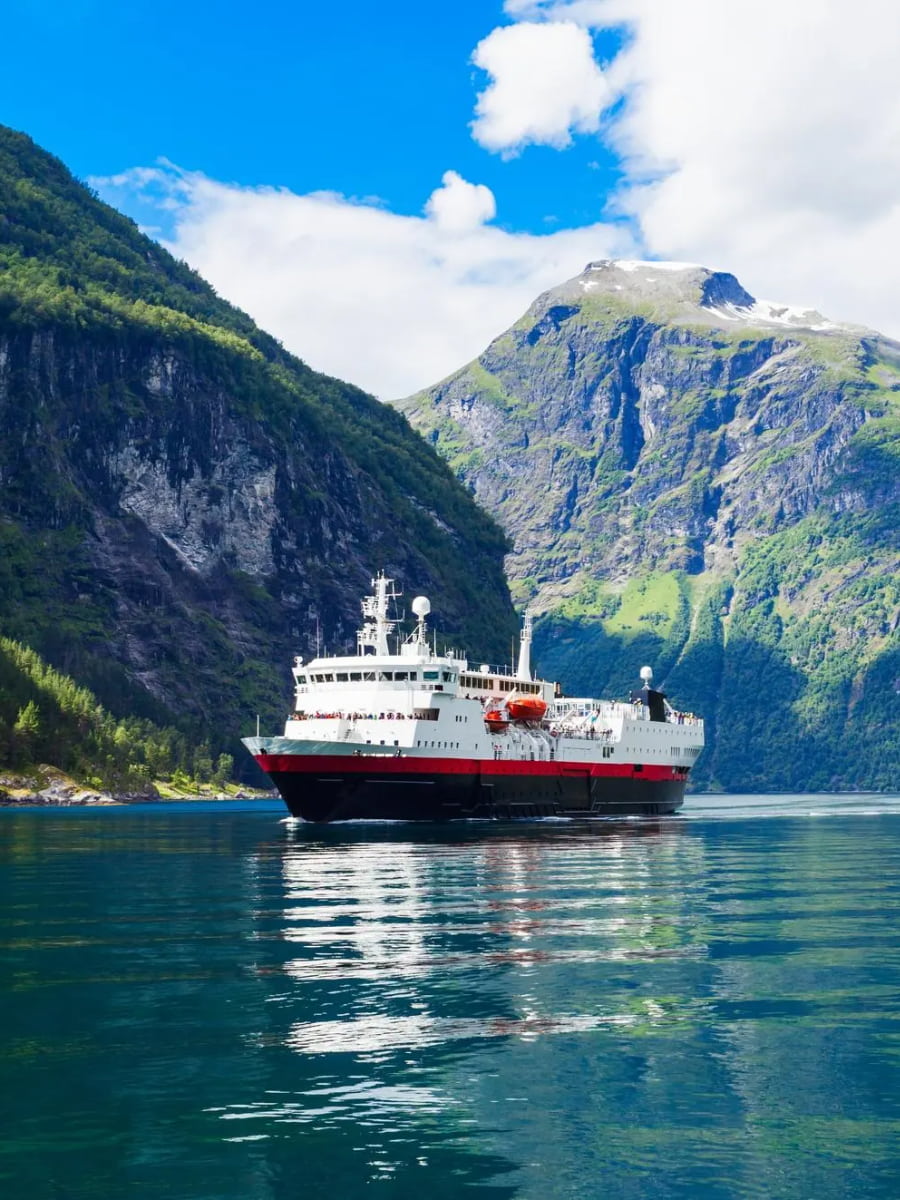
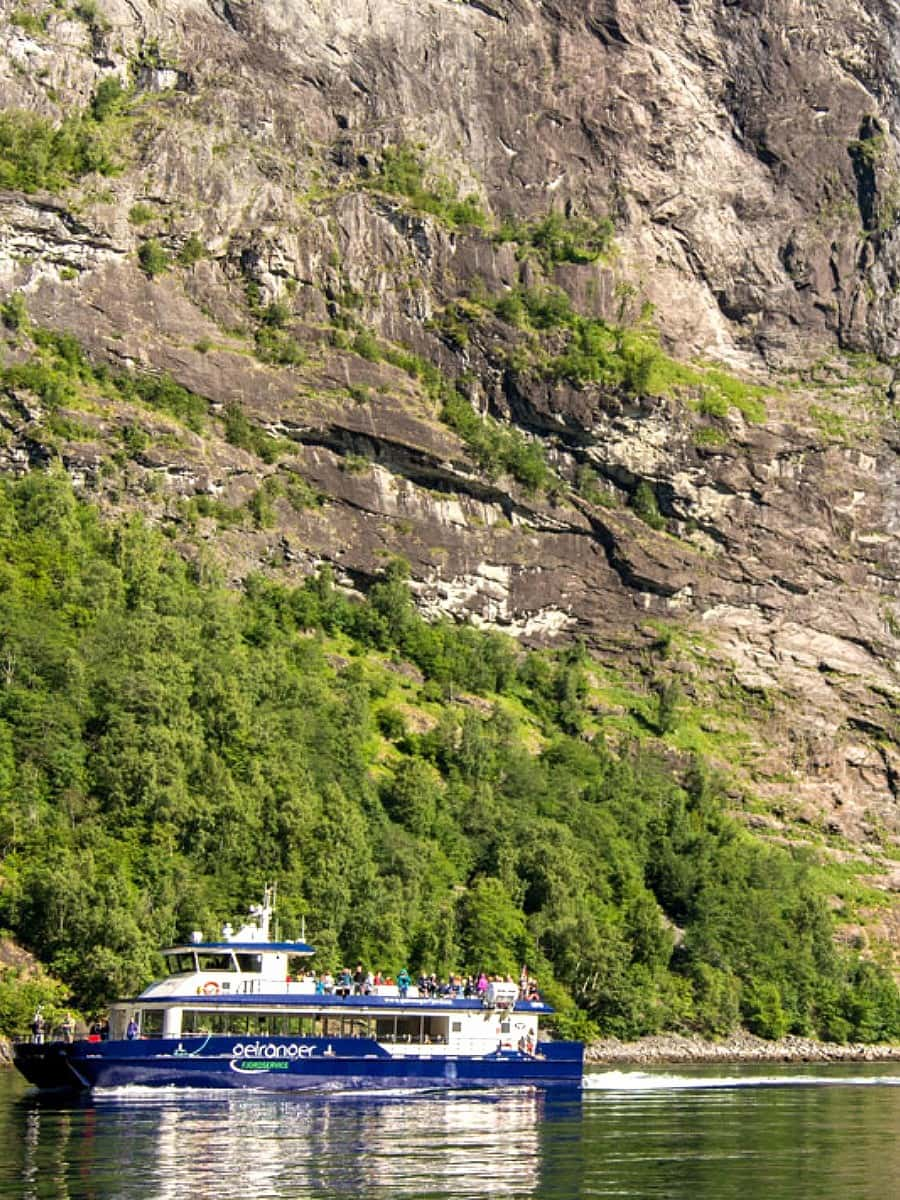
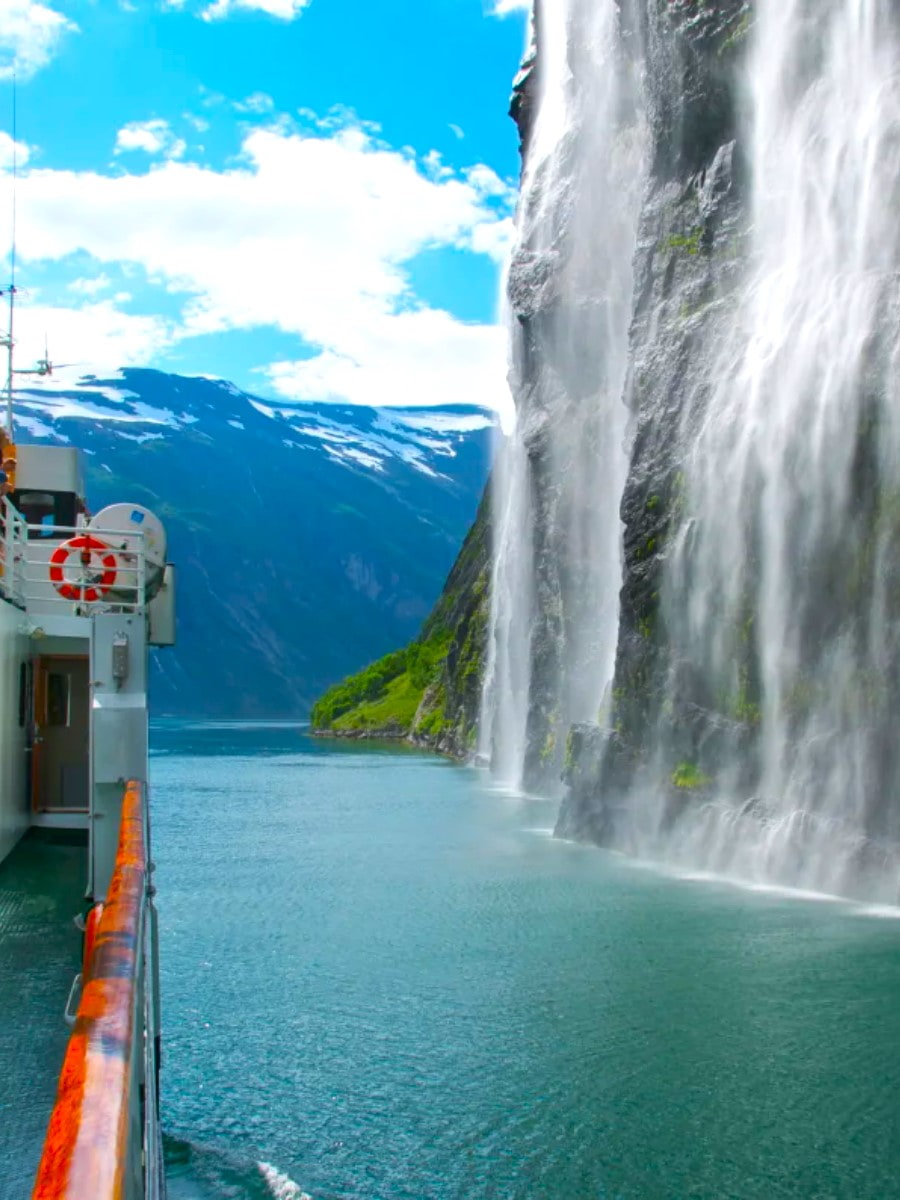
Wildlife encounters. During my cruise, I was lucky enough to spot porpoises playing in the water – a classic Geirangerfjord experience! The captain slowed down so we could watch these graceful creatures, and I even caught glimpses of eagles soaring above the cliffs.
Mountain farms. One of the most fascinating aspects was seeing the abandoned fjord farms clinging precariously to the steep cliffs. Our audio guide shared stories about the families who once lived in these remote locations, accessible only by steep paths or ladders. It’s hard to imagine the challenging lives they led in such isolated but breathtaking surroundings.
Practical tips. Most cruises include audio guides in multiple languages, and some serve Norwegian waffles and coffee on board. I recommend bringing layers as it gets chilly on the water, even in summer, and don’t forget your camera!
| Cruise Type | Duration | Price (NOK) | Price (USD) | Season |
|---|---|---|---|---|
| Standard Sightseeing | 90 min | 600 | ~$57 | May 1 – Oct 15 |
| Three UNESCO Fjords | 5 hours | 930 | ~$88 | May – September |
| Ålesund to Geiranger | 3 hours | 930 | ~$88 | June – August |
Best Spots on the Boat:
- Upper deck for panoramic photography
- Starboard side when returning (for Suitor waterfall views)
⭐ Best Activities
- Guided Boat Tour in Geiranger – Experience the stunning Geirangerfjord on this guided RIB boat tour, meeting at the Center of Geiranger next to the marina.
2. Geiranger Skywalk – Dalsnibba
Breathtaking heights. Driving up to the skywalk was an adventure in itself, with hairpin turns and increasingly spectacular views. At 1,500 meters above sea level, this glass platform offers what I consider the ultimate panoramic view of Geirangerfjord and the surrounding mountains.
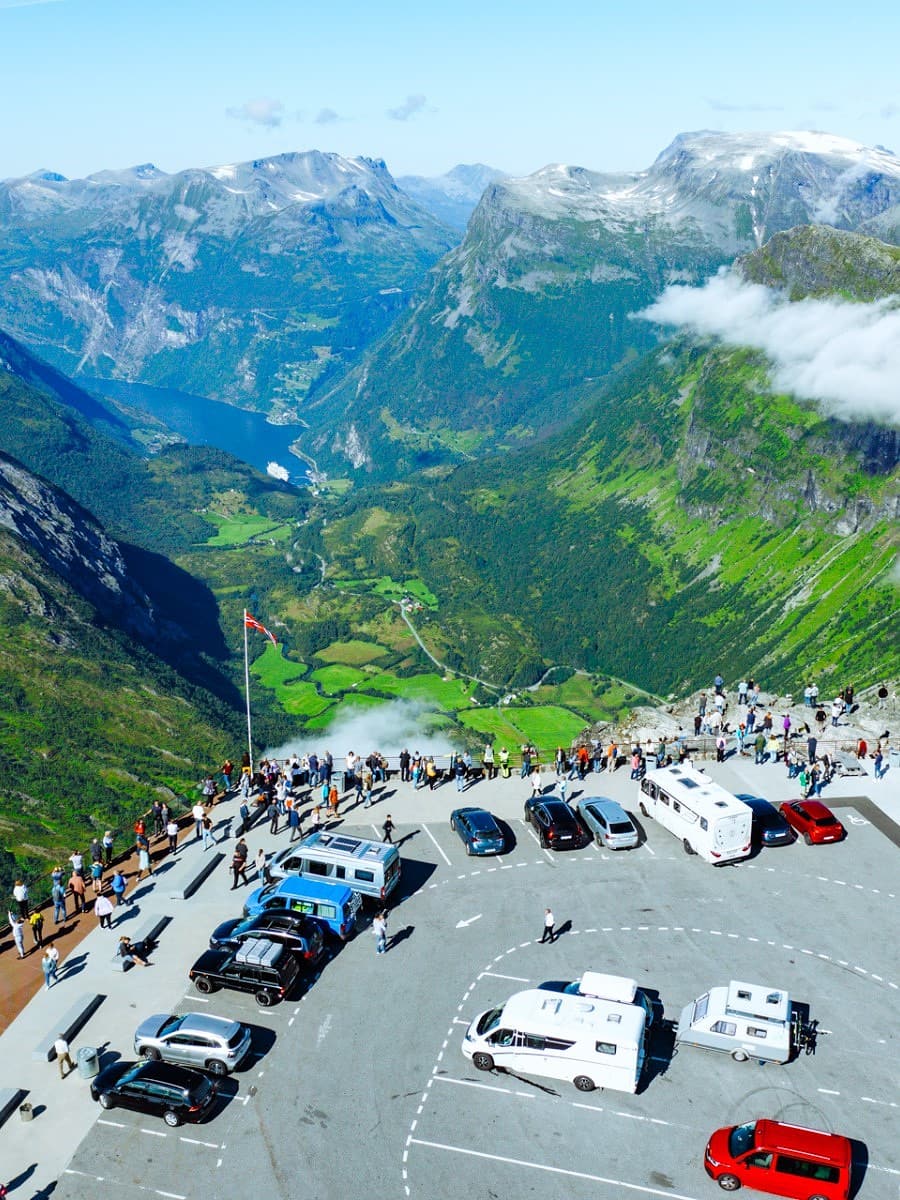
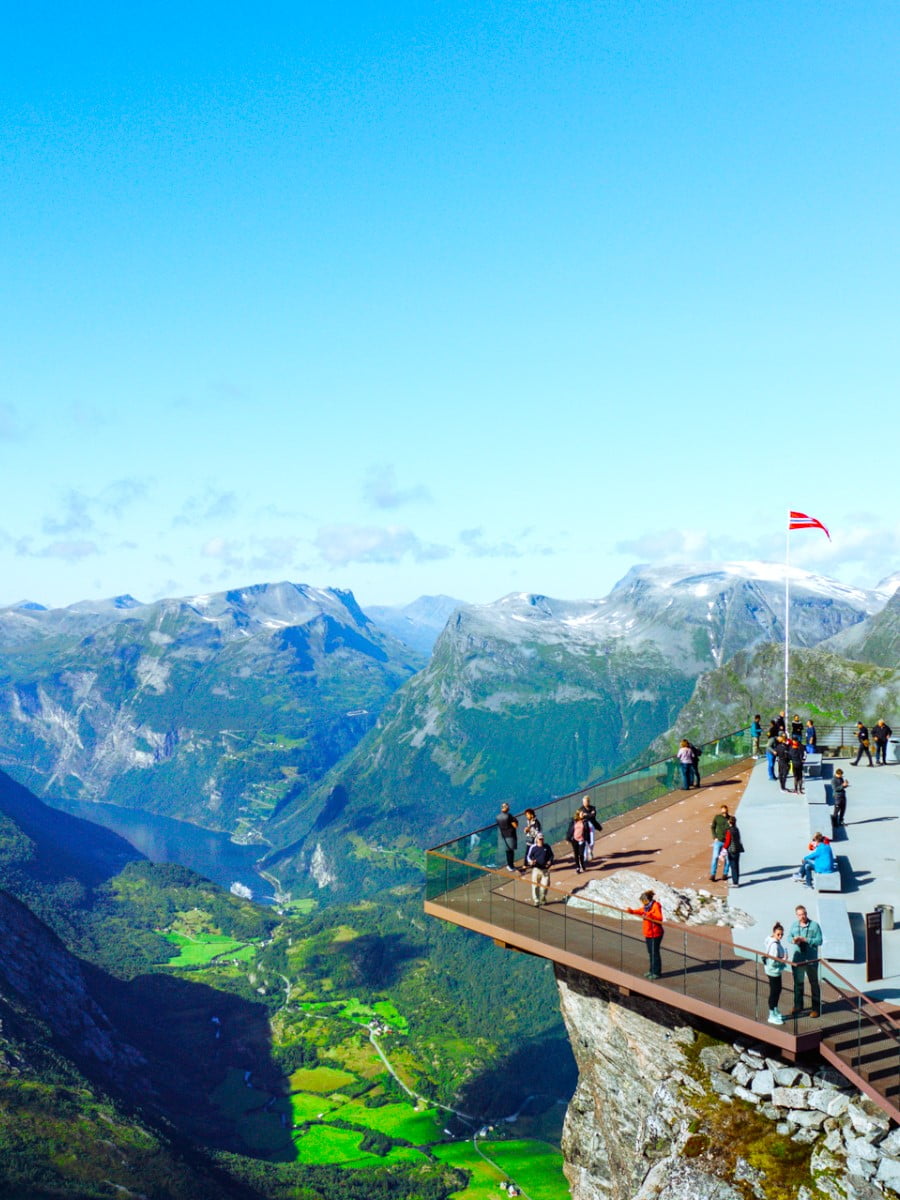
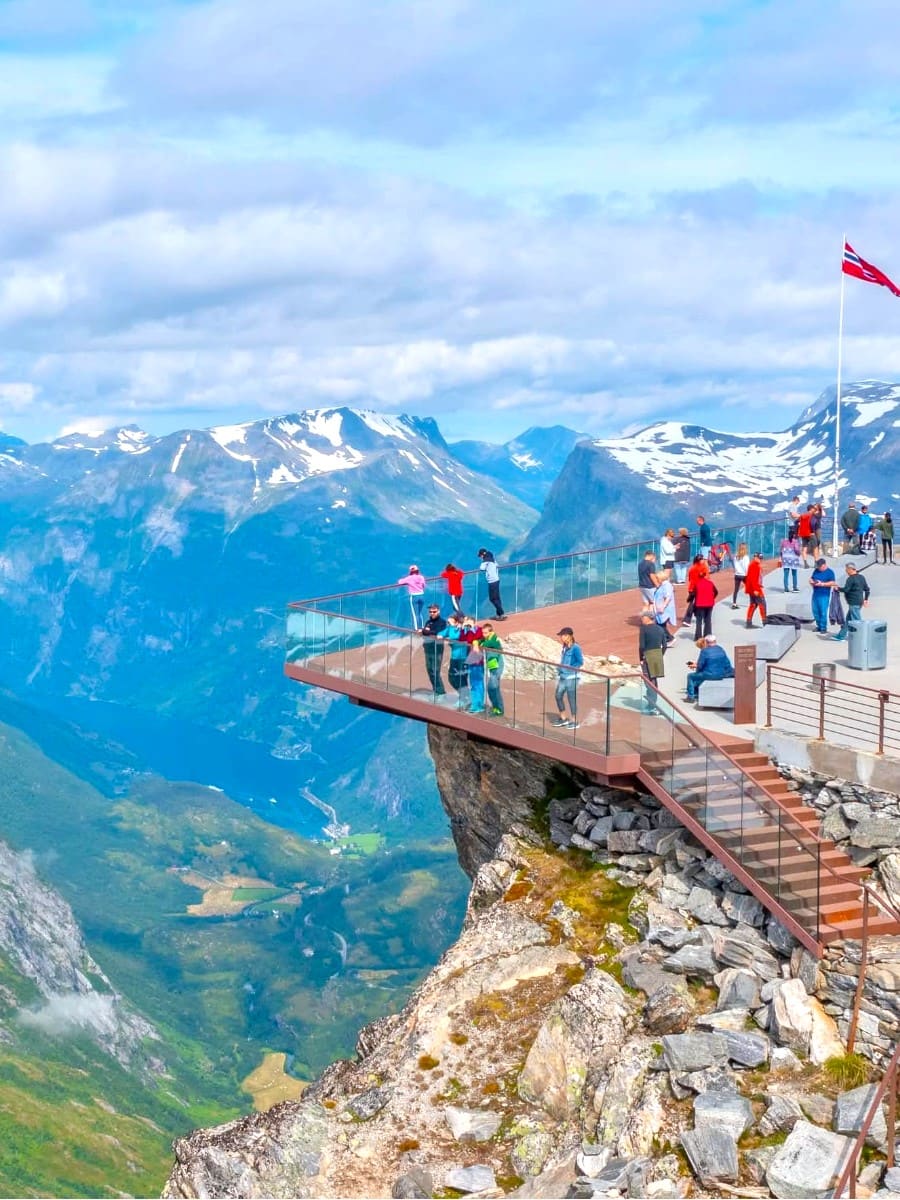
Weather drama. I arrived to find misty clouds swirling around the platform, but patience paid off! Within 20 minutes, the clouds parted to reveal the entire fjord stretching out below me. The constantly changing weather creates a dynamic experience that’s different for every visitor.
Photography paradise. The Skywalk’s glass barriers are perfect for unobstructed photos of the fjord. I spent nearly an hour capturing different angles and watching how the light played on the water far below.
What to Bring:
- Warm jacket (even in summer)
- Camera with wide-angle lens
- Binoculars for spotting distant details
- Small coins for the viewfinders
- Water and snacks (limited facilities)
Practical advice. I recommend visiting early morning or late afternoon to avoid tour bus crowds. The entrance fee was 150 NOK (~$14) per vehicle, which I found reasonable for such an exceptional experience.
Visitor Information:
| Detail | Information |
|---|---|
| Opening Hours | 8:00 AM – 8:00 PM (May-October) |
| Vehicle Fee | 150 NOK (~$14) |
| Elevation | 1,500 meters |
| Facilities | Small café, restrooms, souvenir shop |
| Accessibility | Wheelchair accessible platform |
⭐ Best Activities
- Geiranger Shore Excursion: Mt. Dalsnibba and Eagle Road – Explore the highlights of Geiranger including Flydalsjuvet, Geiranger Skywalk – Dalsnibba, and the famous Eagle Road viewpoint on this guided excursion.
3. Seven Sisters Waterfall (by boat or kayak)
Natural wonder. Getting up close to the legendary waterfall was a truly magical experience. These seven parallel streams cascade down the steep mountainside, dropping about 250 meters into the fjord. The name comes from their appearance – like seven long-haired sisters dancing down the cliff.
Seasonal variations. I visited in June when the waterfall was at its most powerful due to snowmelt. By August, some of the “sisters” may be less visible during dry periods, though the formation remains impressive year-round.
Mythology encounter. According to local folklore, the waterfall across the fjord called “The Suitor” is trying to court the sisters. Our guide pointed out how the waterfall resembles a bottle, supposedly because the suitor is taking a drink to build courage to approach the sisters!
Facts:
| Feature | Detail |
|---|---|
| Height | 250 meters |
| Number of streams | 7 (varies with water flow) |
| Best viewing | May-June (peak flow) |
| Named in | 1880s by tourists |
| Local name | “De Syv Søstrene” |
Photography tip. The falls face west, so afternoon light creates beautiful rainbows in the mist. I captured stunning photos around 3-4 PM when the sunlight hit the water spray perfectly, creating magical rainbow effects across the falls.
Best Ways to See the Waterfall:
- Guided kayak tour (from 750 NOK)
- RIB boat adventure (from 850 NOK)
- Helicopter tour (from 2,500 NOK)
⭐ Best Tours
- Fjordsafari Geiranger – Discover the UNESCO-protected Geirangerfjord on this exciting safari boat tour, taking in the magnificent scenery and waterfalls.
- Kayak Tour with Waterfall Views in Geiranger – Paddle through the spectacular Geirangerfjord and get up close to stunning waterfalls on this guided adventure.
4. Skageflå Mountain Farm Hike
Historical adventure. The hike to Skageflå mountain farm was easily the most rewarding trek I experienced in Geiranger. This abandoned farm clings to a mountain ledge 250 meters above the fjord, offering a glimpse into Norway’s fascinating rural past and jaw-dropping views of the Geirangerfjord.
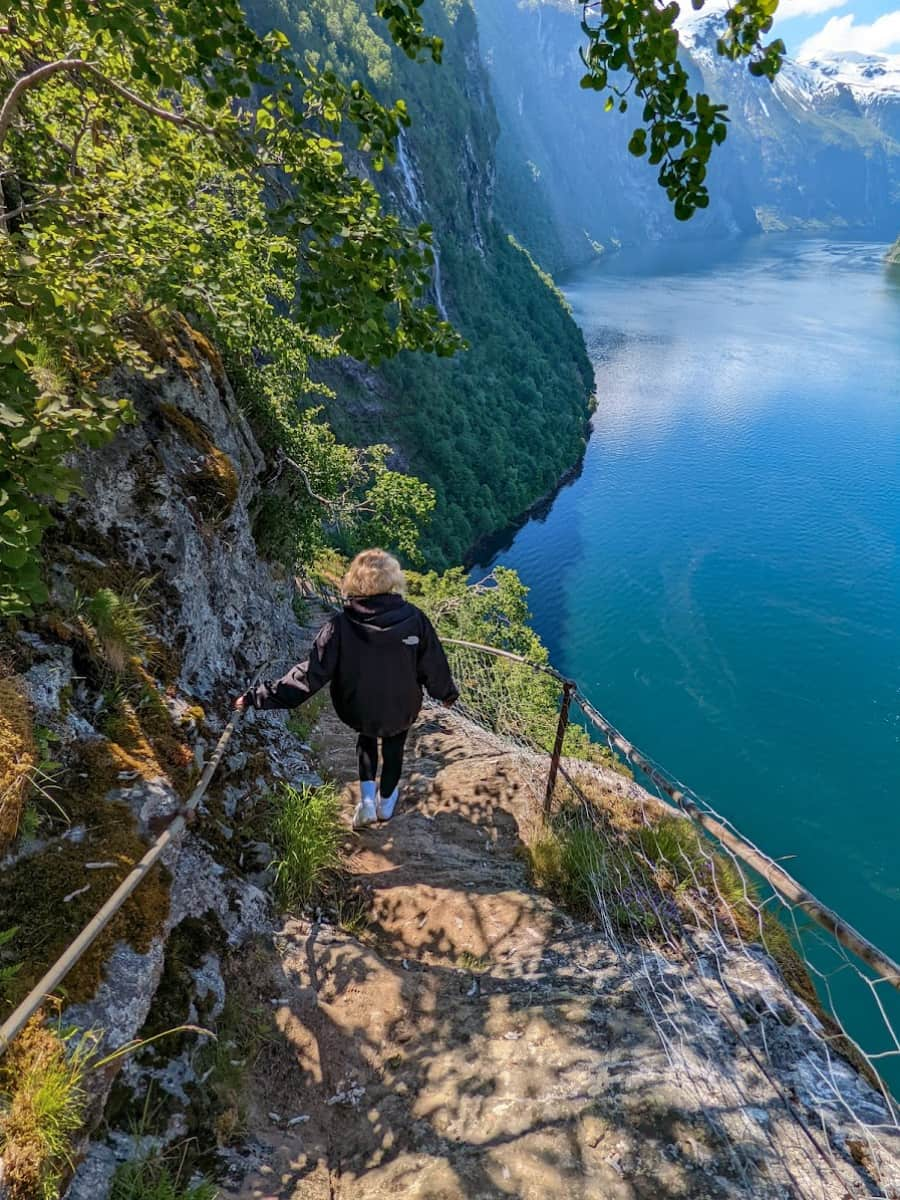
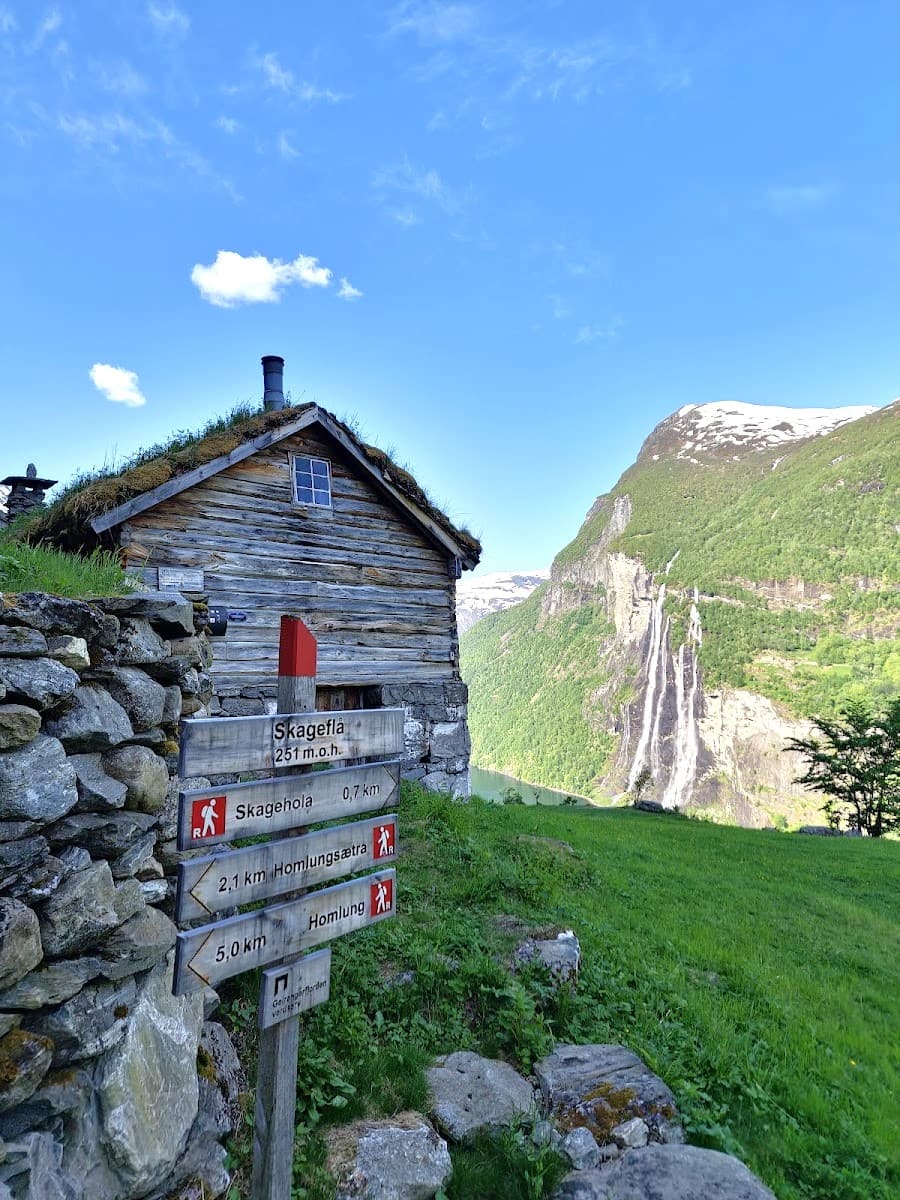
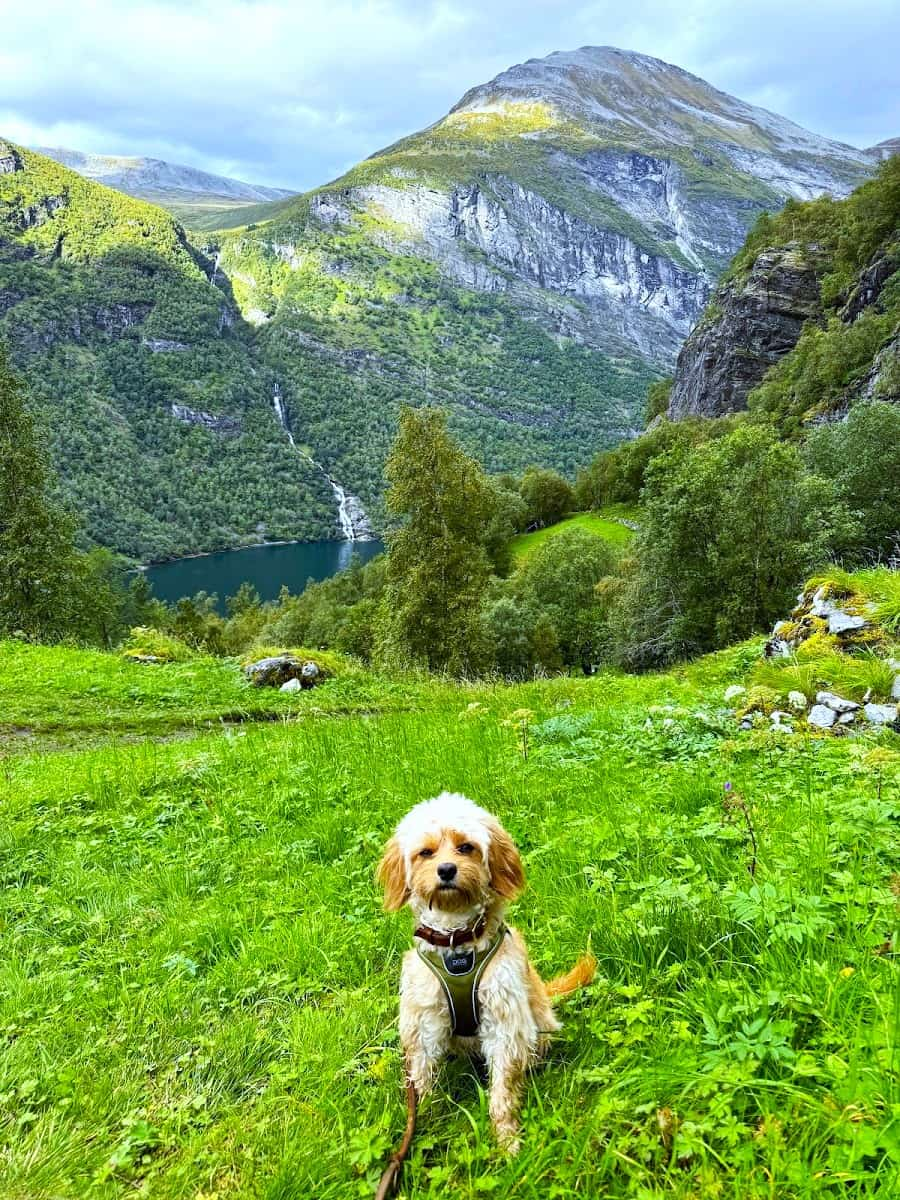
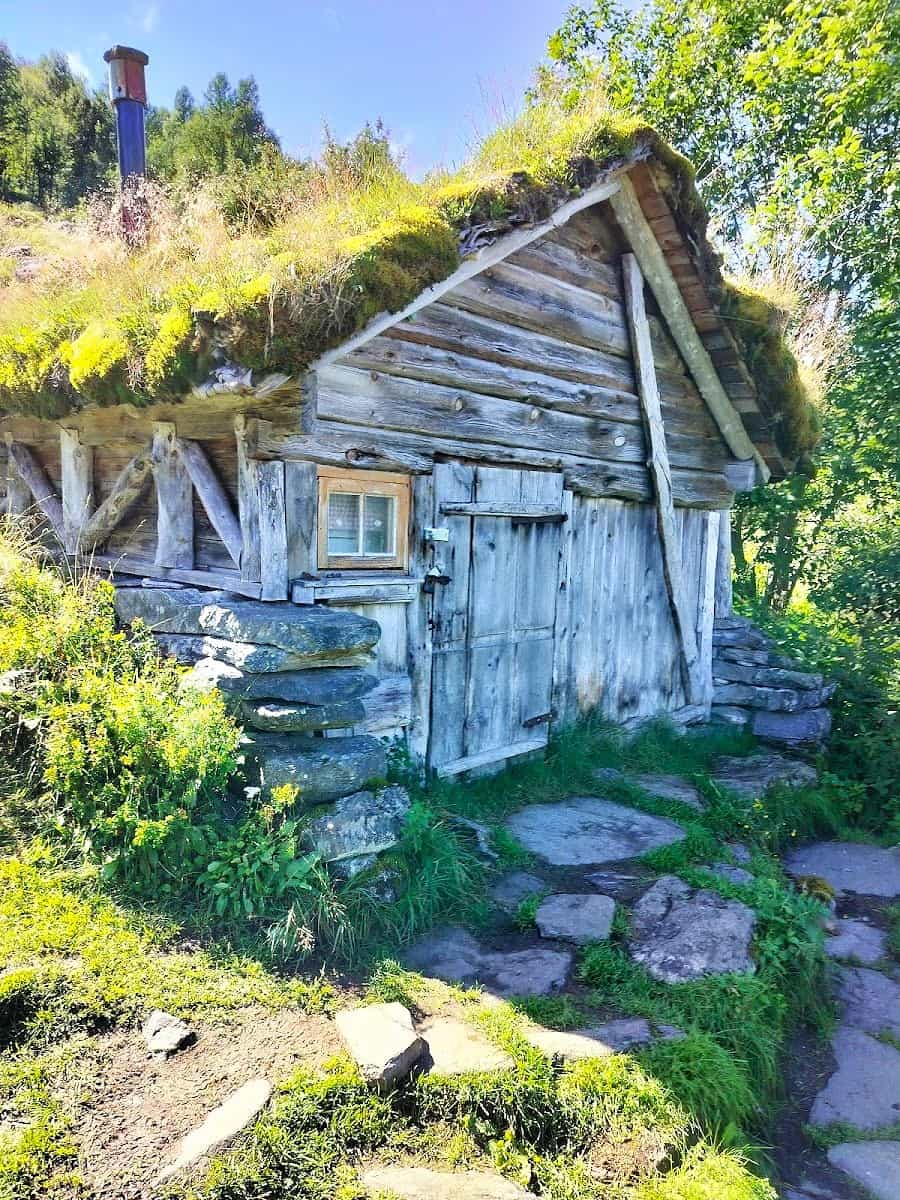
Cultural immersion. Standing among the preserved farm buildings, I tried to imagine life here before the farm was abandoned in 1918. Families lived in remarkable isolation, raising livestock on tiny patches of land and navigating dangerous cliff paths to reach the outside world.
Skageflå Options:
| Route | Distance | Difficulty | Time (one way) | Starting Point |
|---|---|---|---|---|
| Fjord route | 1.8 km | Moderate-Hard | 1.5 hours | Boat dock |
| Homlongsætra | 5.5 km | Moderate | 2.5 hours | Geiranger |
| Combined | 7.3 km | Moderate-Hard | 4 hours | Circular route |
Safety first. The trail can be slippery after rain, so proper hiking boots are essential. I carried plenty of water, snacks, and layers for changing weather conditions. The hike is best attempted between June and September when the paths are clear of snow.
What to Pack for Skageflå Hike:
- Water (minimum 1.5 liters)
- High-energy snacks
- Rain jacket
- Camera
- Sunscreen and hat
⭐ Best Activities
- Fjordsightseeing by Boat Geirangerfjord – Enjoy a relaxing boat tour through the majestic Geirangerfjord, taking in the Seven Sisters waterfall and other natural wonders.
5. Storseterfossen Waterfall Hike
Hidden gem. The hike to Storseterfossen waterfall offered me a truly unique experience – walking behind a powerful cascade of water! This lesser-known trail starts near Westerås Farm and leads to a waterfall where you can actually walk on a path that runs behind the curtain of water.
Moderate challenge. The trail took me about 40 minutes each way, climbing steadily through beautiful forest and meadows. While not technically difficult, the path has some steep sections and can be slippery near the waterfall, so proper footwear is essential.
Sensory overload. Standing behind the waterfall was an assault on the senses – the thundering roar of water, the cool mist on my skin, and the unique perspective of looking out at the world through a curtain of falling water. It’s a perspective few waterfalls in Norway offer.
Storseterfossen Trail Information:
| Detail | Information |
|---|---|
| Trail Length | 2.5 km round trip |
| Elevation Gain | 270 meters |
| Difficulty | Moderate |
| Time Required | 1.5-2 hours total |
| Season | Late May to September |
Local insight. I learned from a local guide that the name “Storseterfossen” refers to the “big mountain farm waterfall,” as it’s located near traditional summer farming areas. The trail passes through what was once grazing land for local farmers’ livestock.
Practical tips. I recommend wearing a waterproof jacket for the section behind the falls – you will get wet from the spray! The trail is free to access, though there’s a small parking fee of 50 NOK (~$5) if you drive to the trailhead at Westerås Farm.
What to Expect at Different Sections:
- First 20 minutes: Forest path with moderate incline
- Middle section: Open meadows with fjord views
- Final approach: Steeper rocky section with handrails
- Behind waterfall: Wet, narrow path with safety chain
- Return: Same route with downhill sections requiring care
6. Norwegian Fjord Centre
Cultural immersion. The Norwegian Fjord Centre (Norsk Fjordsenter) provided me with fascinating insights into how the spectacular Geirangerfjord was formed and the unique culture that developed around it. Located in the heart of Geiranger, this modern museum tells the story of life in the fjords through interactive exhibits.
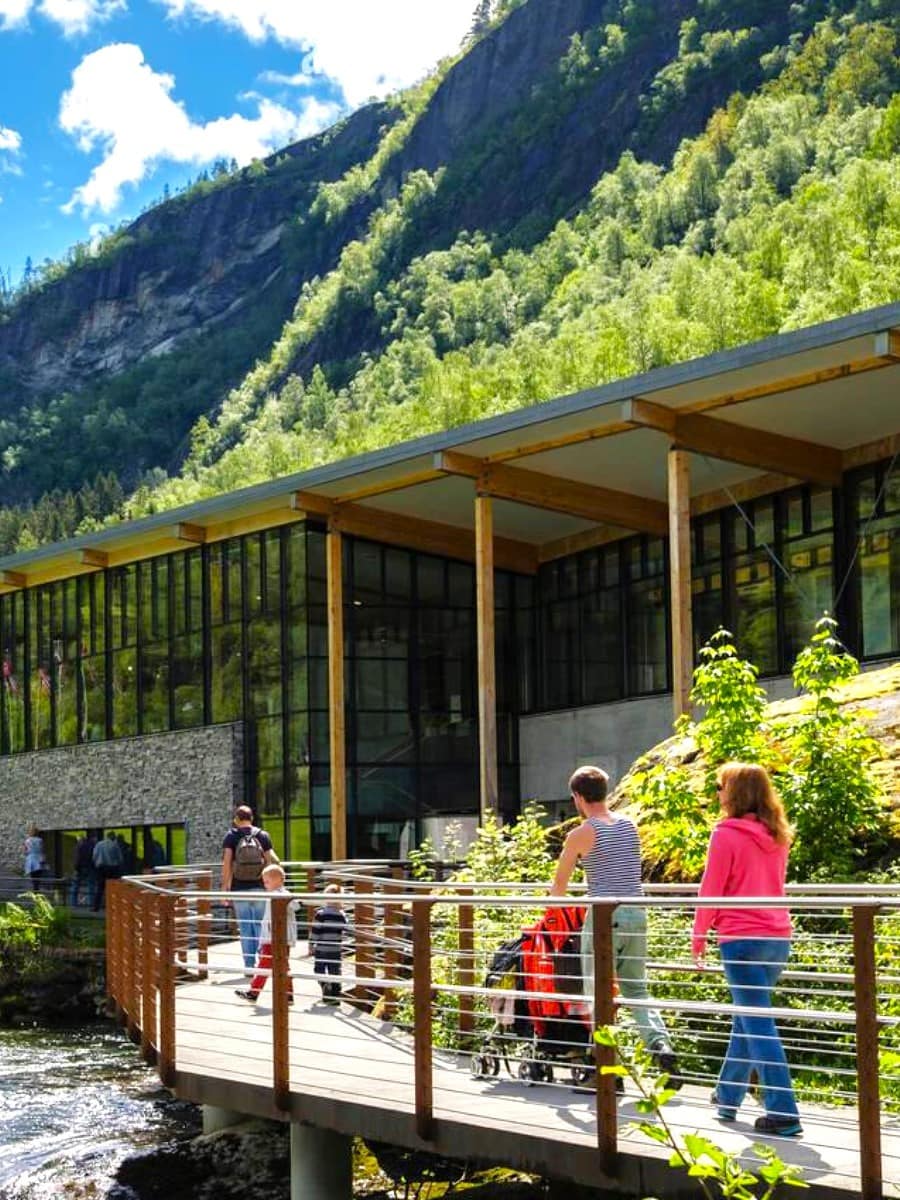
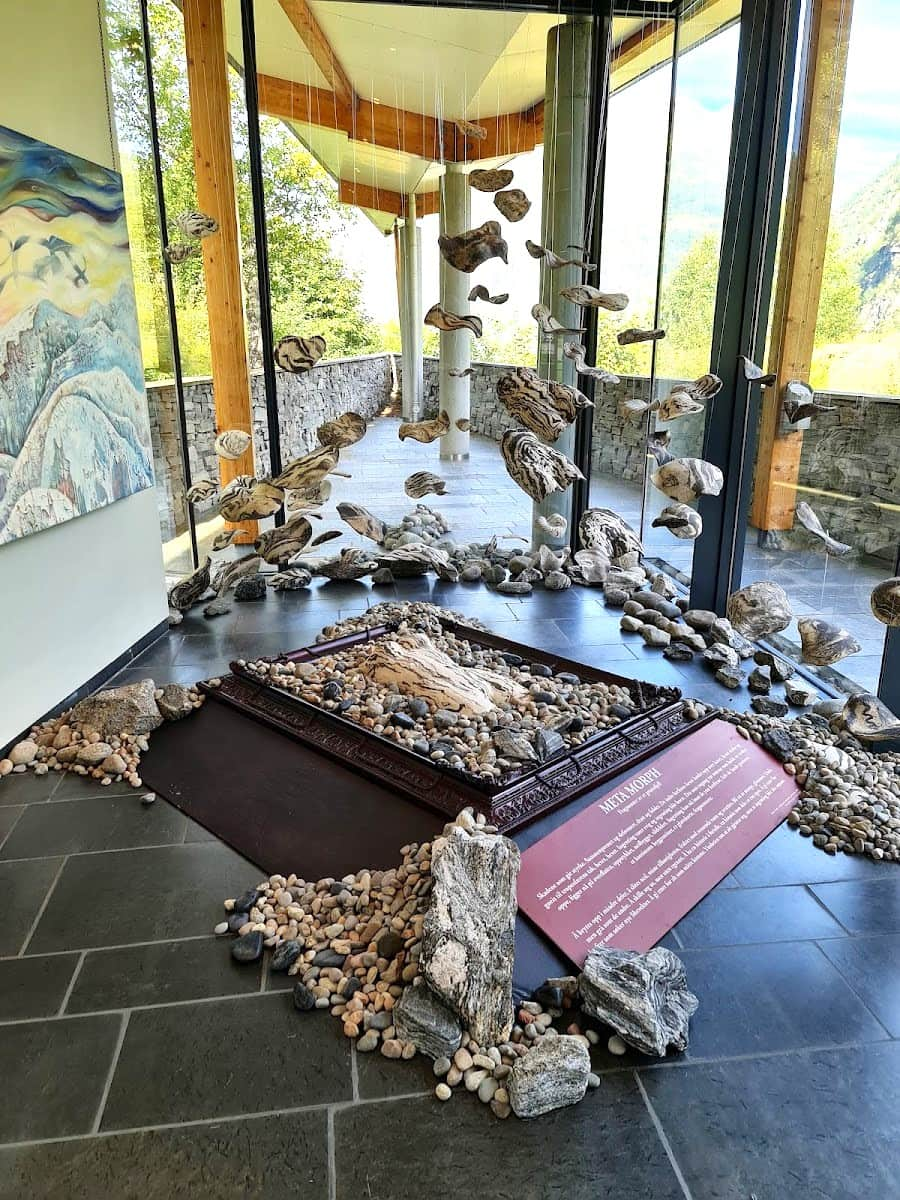
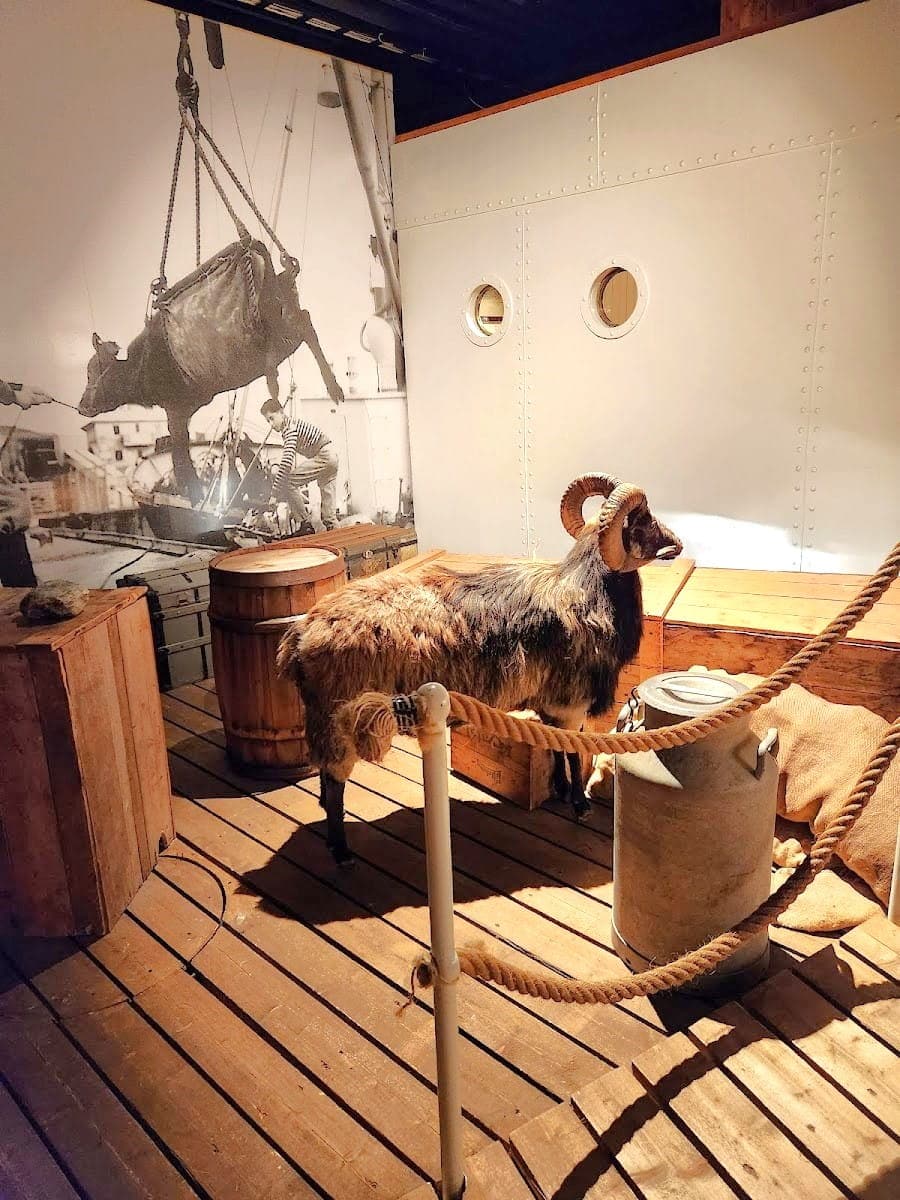
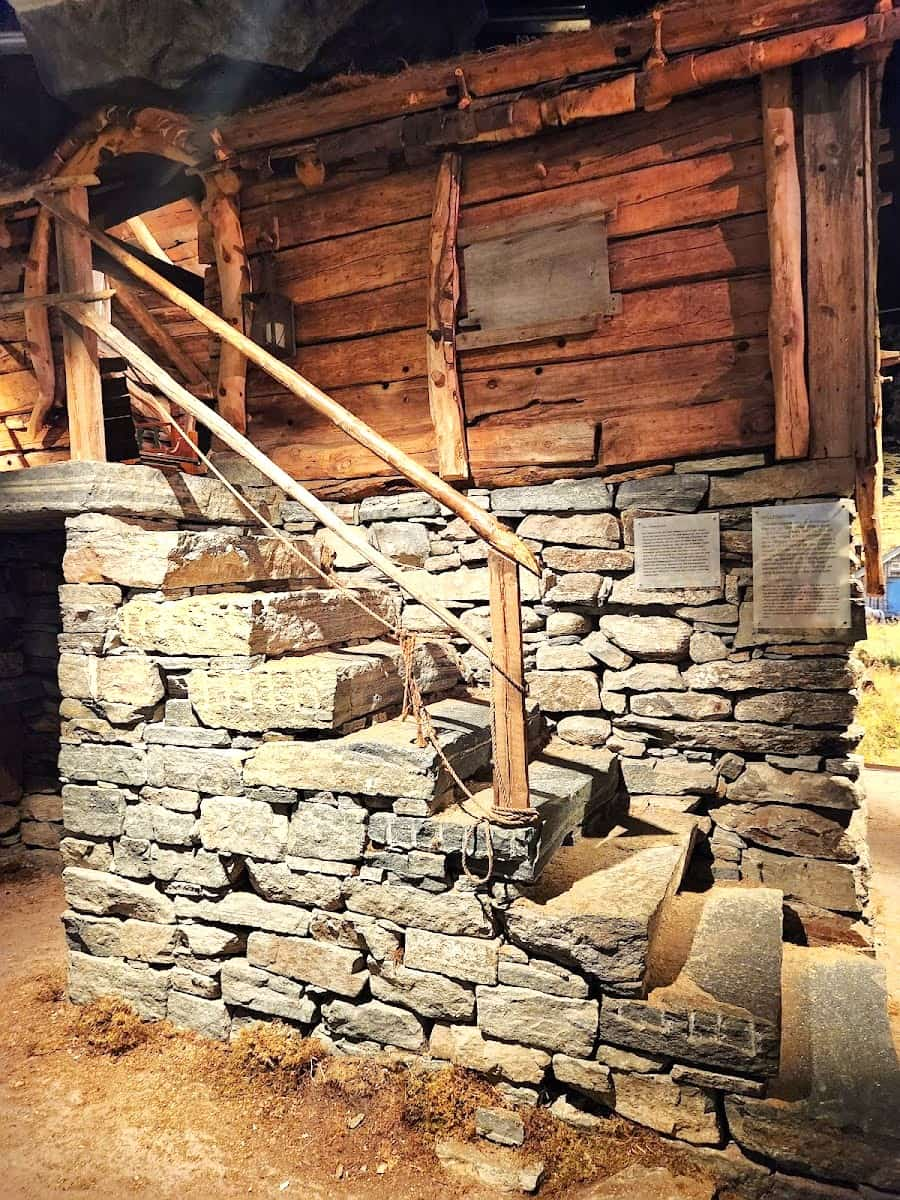
Geological journey. I was particularly impressed by the displays explaining how glaciers carved these massive valleys over millions of years. The 3D models and video presentations made complex geological processes easy to understand, even for someone like me with limited scientific knowledge.
Human stories. The exhibits about the fjord farmers who built homes on nearly vertical mountainsides were incredibly moving. Their ingenious adaptations to this challenging environment – including pulley systems for transporting goods and children being tethered while playing outdoors – painted a vivid picture of their remarkable lives.
Norwegian Fjord Centre Highlights:
- Interactive geological exhibits
- Traditional farm building reconstructions
- Film about UNESCO World Heritage status
- Children’s activity area
- Temporary art exhibitions
- Local craft demonstrations (seasonal)
Practical value. Beyond the fascinating exhibits, I found the centre extremely helpful for planning my stay in Geiranger. The staff provided excellent hiking recommendations based on my experience level and current trail conditions, potentially saving me from a dangerous situation.
Worth the price. Admission was 150 NOK (~$14) for adults, with discounts for students and seniors. I spent about 2 hours exploring the exhibits, making it good value compared to other Norwegian attractions. The gift shop offered unique, locally-made souvenirs at reasonable prices.
Norwegian Fjord Centre Information:
| Detail | Information |
|---|---|
| Opening Hours | 9:00 AM – 6:00 PM (May-Sept) |
| Adult Admission | 150 NOK (~$14) |
| Child Admission | 75 NOK (~$7) |
| Languages | Exhibits in Norwegian, English, German |
| Facilities | Café, gift shop, restrooms, free WiFi |
⭐ Best Activities
- City Sightseeing Geiranger Hop-On Hop-Off Tour – Explore Geiranger at your own pace with this convenient hop-on hop-off bus tour, stopping at the area’s most popular attractions.
7. Kayaking on Geirangerfjord
Water-level perspective. Kayaking on Geirangerfjord gave me a completely different experience than viewing it from above or from a cruise boat. Paddling the calm, emerald waters brought me closer to the sheer scale of the surrounding cliffs and waterfalls in a way that felt both humbling and exhilarating.
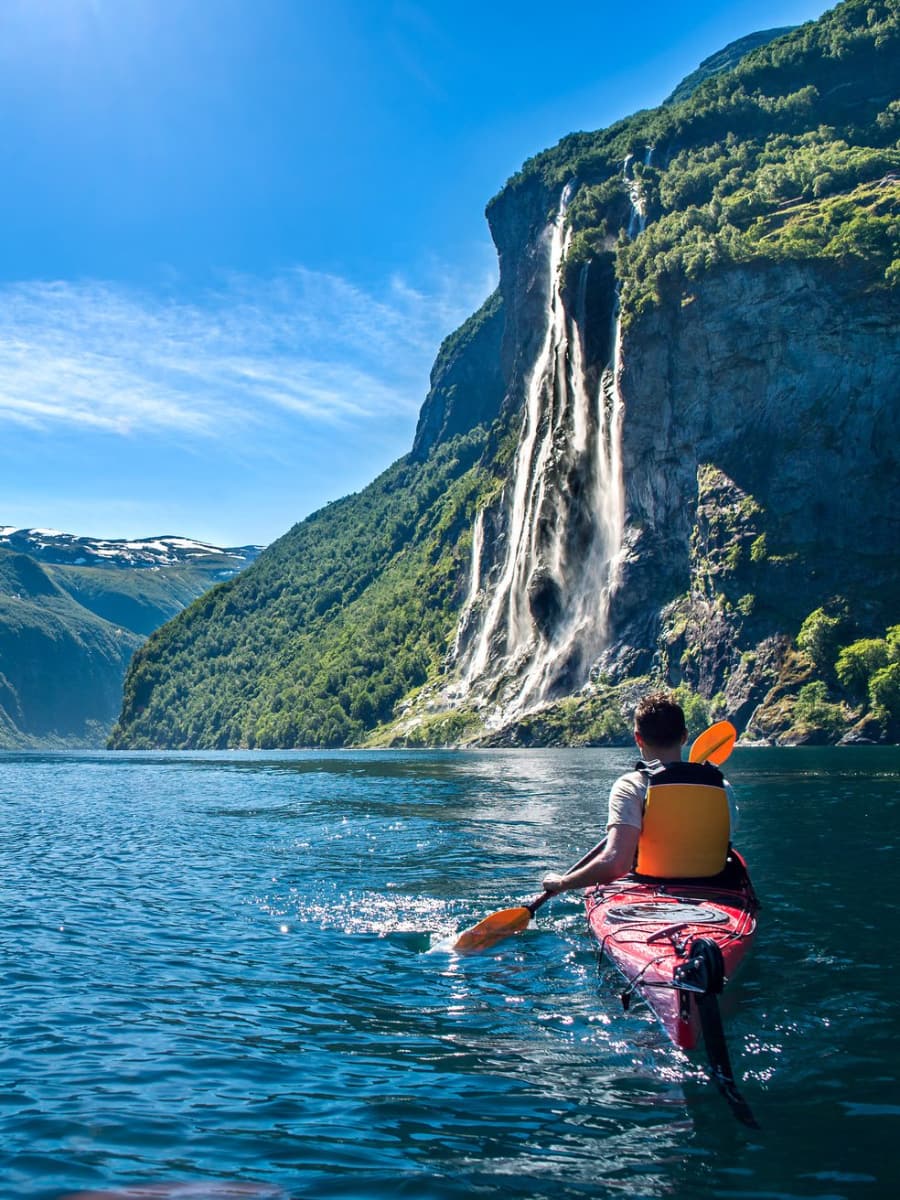
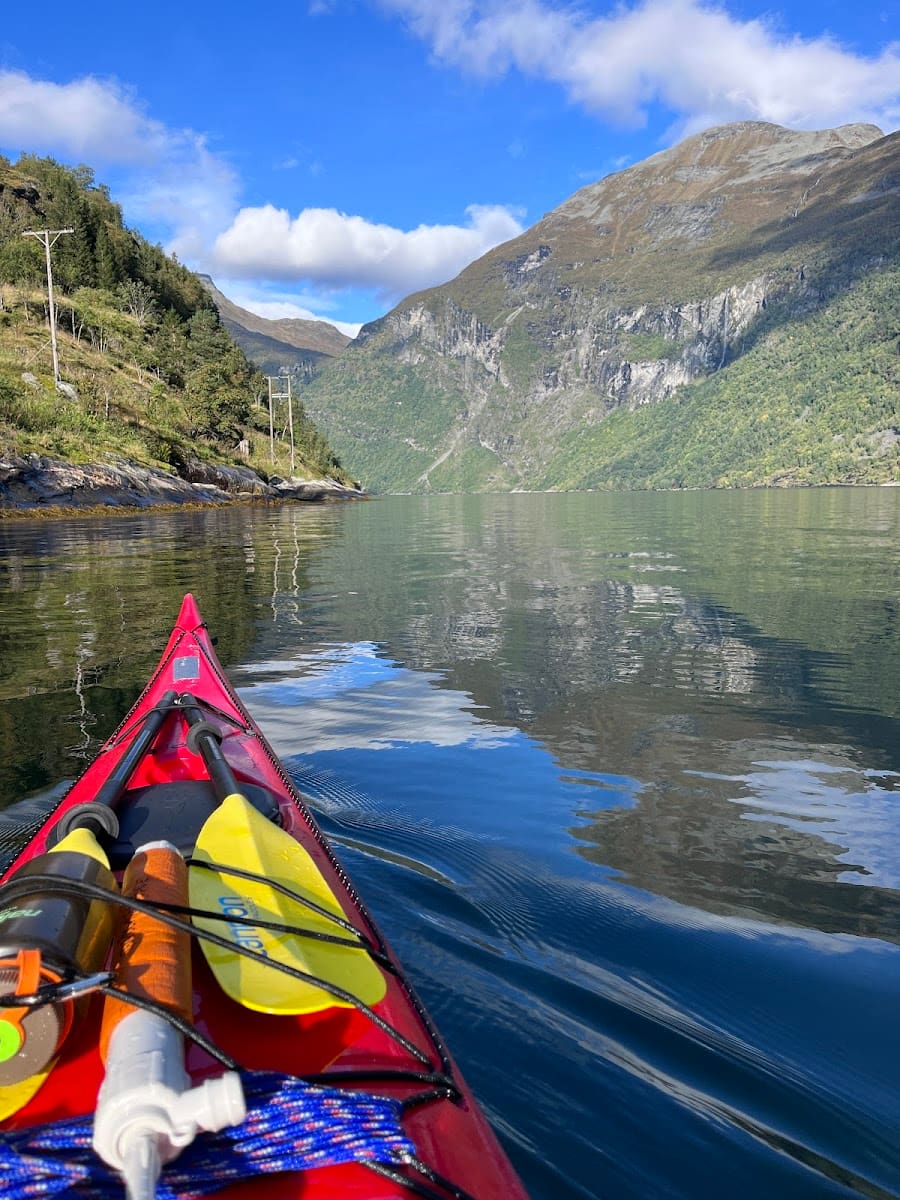
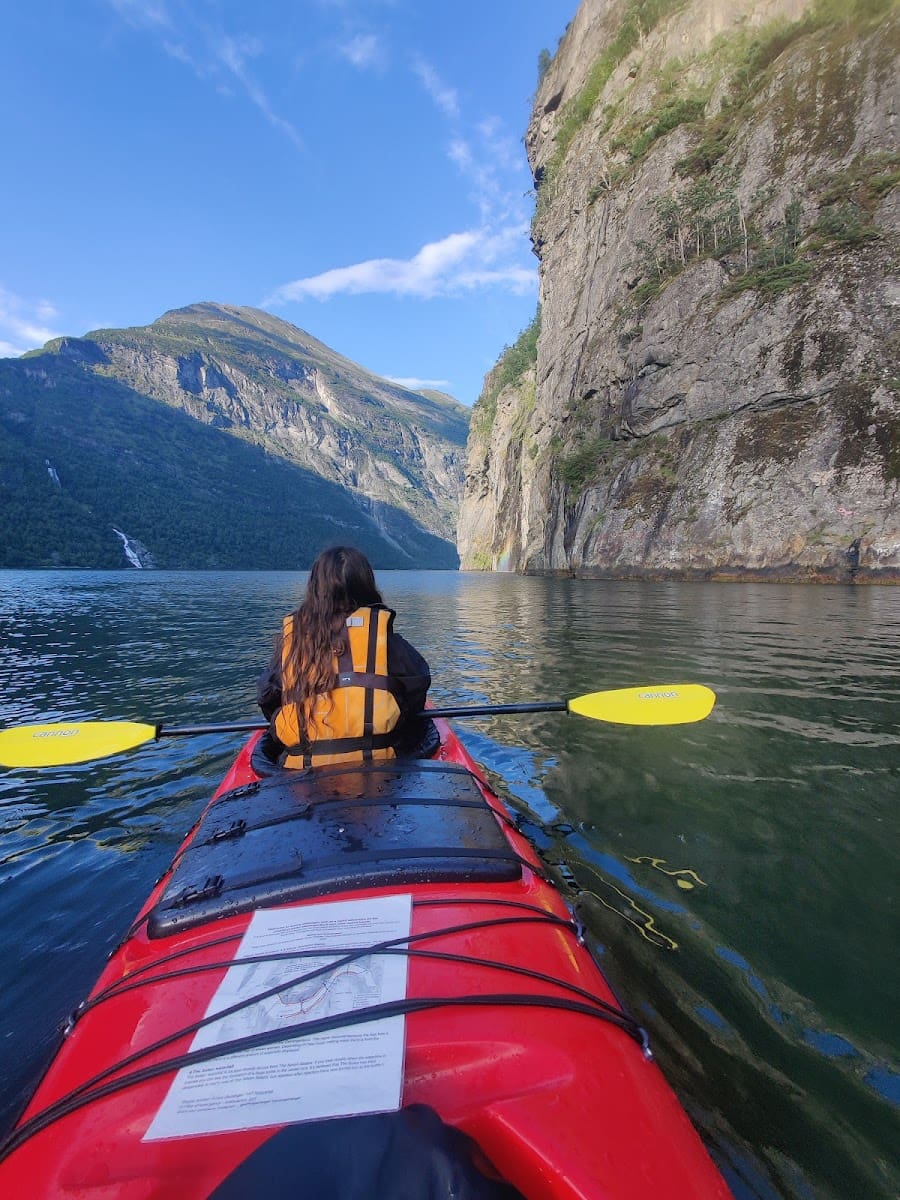
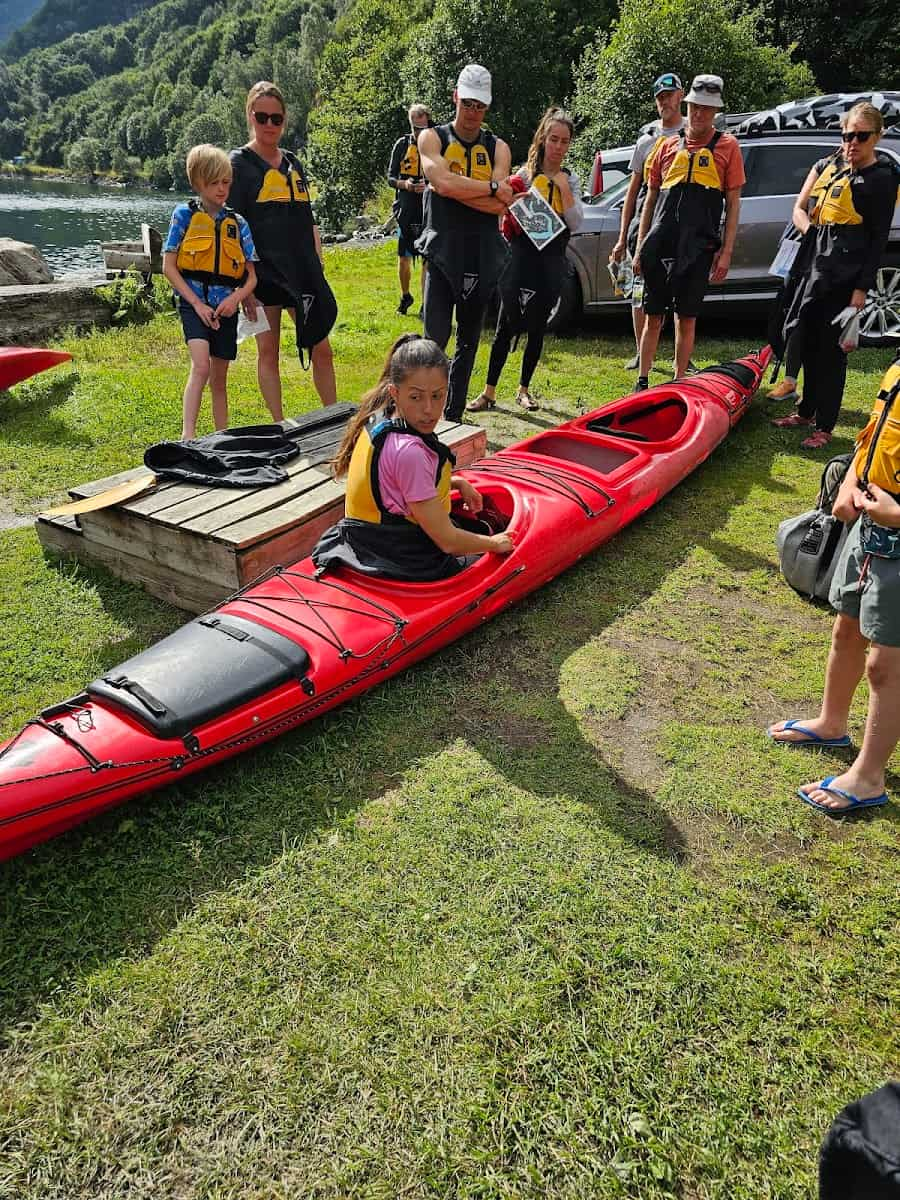
Guided expertise. I joined a 3-hour guided tour with Geiranger Kayak, which cost 750 NOK (~$71) including all equipment and safety gear. Our guide, Lars, shared fascinating stories about the fjord’s formation and pointed out details I would have missed on my own, like the remains of old farm paths zigzagging up the cliffs.
Tour Options:
| Tour Type | Duration | Price (NOK) | Price (USD) | Difficulty |
|---|---|---|---|---|
| Intro Tour | 2 hours | 550 | ~$52 | Beginner |
| Classic Tour | 3 hours | 750 | ~$71 | Beginner-Intermediate |
| Extended Tour | 5 hours | 1,100 | ~$104 | Intermediate |
| Private Guide | Custom | From 1,500 | ~$142 | Any level |
Wildlife surprise. During our peaceful paddle, we spotted several seabirds diving for fish, and our guide pointed out a sea eagle’s nest high on the cliffs. The quiet approach allows for better wildlife viewing than motorized vessels.
Practical advice. No previous experience was required for the tour I took, but basic fitness is helpful. The company provided waterproof containers for phones and cameras, but I recommend bringing a waterproof case for extra protection. Wearing layers is essential – I was grateful for my quick-dry clothes as paddling generated heat despite the cool fjord air.
What to Bring:
- Quick-dry clothing (avoid cotton)
- Change of clothes (just in case)
- Sunscreen and sunglasses
- Water bottle
- Snacks
- Camera in waterproof case
- Hat with secure strap
8. Trollstigen Road Trip
Engineering marvel. Driving the famous Trollstigen (Troll’s Path) was one of the most exhilarating road experiences I’ve ever had. This masterpiece of engineering features 11 hairpin turns that zigzag up a steep mountainside, offering increasingly spectacular views with each twist in the road.
Viewpoint wonder. The modern visitor center and viewing platform at the top of Trollstigen provided breathtaking panoramas of the road I’d just conquered and the Stigfossen waterfall that plunges 320 meters alongside it. The glass-floored lookout point gave me a thrilling sensation of floating above the valley.
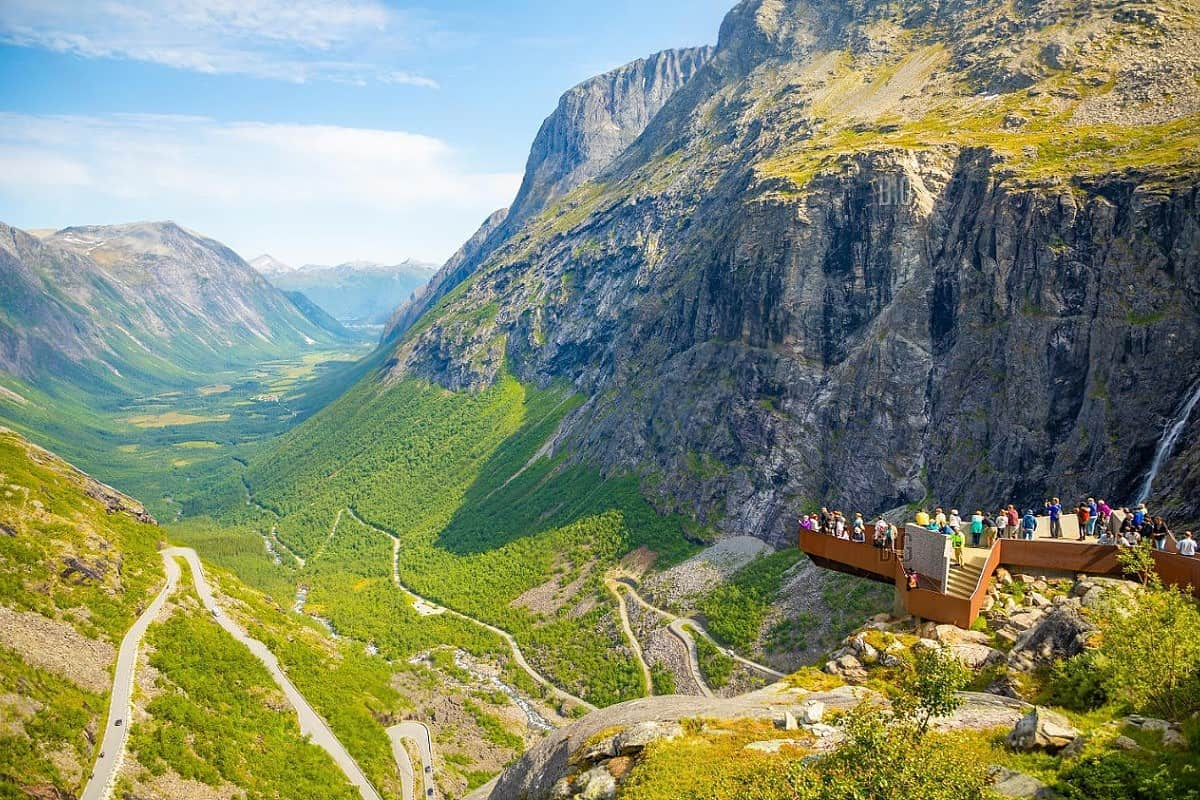
Natural drama. The landscape surrounding Trollstigen is quintessentially Norwegian – rugged mountains, cascading waterfalls, and lush valleys. I was fortunate to visit on a clear day, but even with partial clouds, the scenery was dramatically beautiful as mist swirled around the mountain peaks.
Trollstigen Road Facts:
| Feature | Detail |
|---|---|
| Length | 106 km (full route) |
| Hairpin Turns | 11 |
| Maximum Gradient | 9% |
| Highest Elevation | 858 meters |
| Construction | 1916-1936 |
| Season | Late May to October |
Driving tips. The road requires careful driving, especially when passing larger vehicles on the narrow sections. I found early morning (before 10 AM) or evening (after 5 PM) offered the most enjoyable experience with less traffic. The road is typically open from late May to October, depending on snow conditions.
Full-day adventure. I combined Trollstigen with the full National Tourist Route from Geiranger to Åndalsnes, which took about 3-4 hours of driving time plus stops. The route includes a ferry crossing at Eidsdal-Linge, which runs every 20 minutes in summer (140 NOK/~$13 for a standard car).
Trollstigen Route Highlights:
- Ørnesvingen (Eagle Road) viewpoint
- Gudbrandsjuvet gorge
- Trollstigen visitor center
- Stigfossen waterfall view
- Trollveggen (Troll Wall) – Europe’s tallest vertical rock face
- Romsdalsfjord views near Åndalsnes
Free Things to Do in Geiranger
1. Waterfall Trail Walk (327 Steps)
Local favorite. The Waterfall Trail (Fosseråsa) quickly became my go-to morning activity during my stay. This well-maintained path follows the course of a cascading stream through the heart of the village, offering beautiful views and a pleasant workout.
Historical connection. I learned that this trail was originally used by local women to collect water from the stream for household use. Informative signs along the path tell the story of how water shaped daily life in old Geiranger, adding cultural context to the natural beauty.
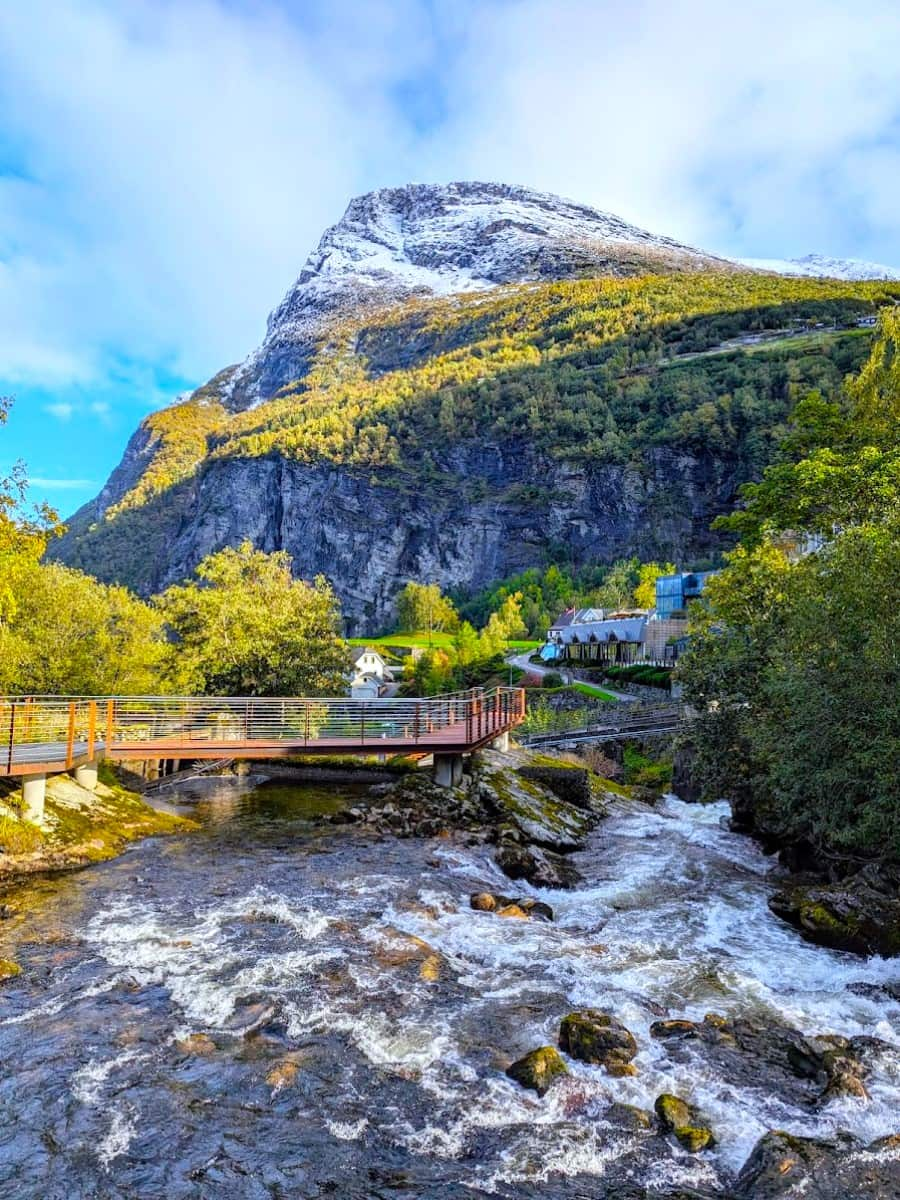
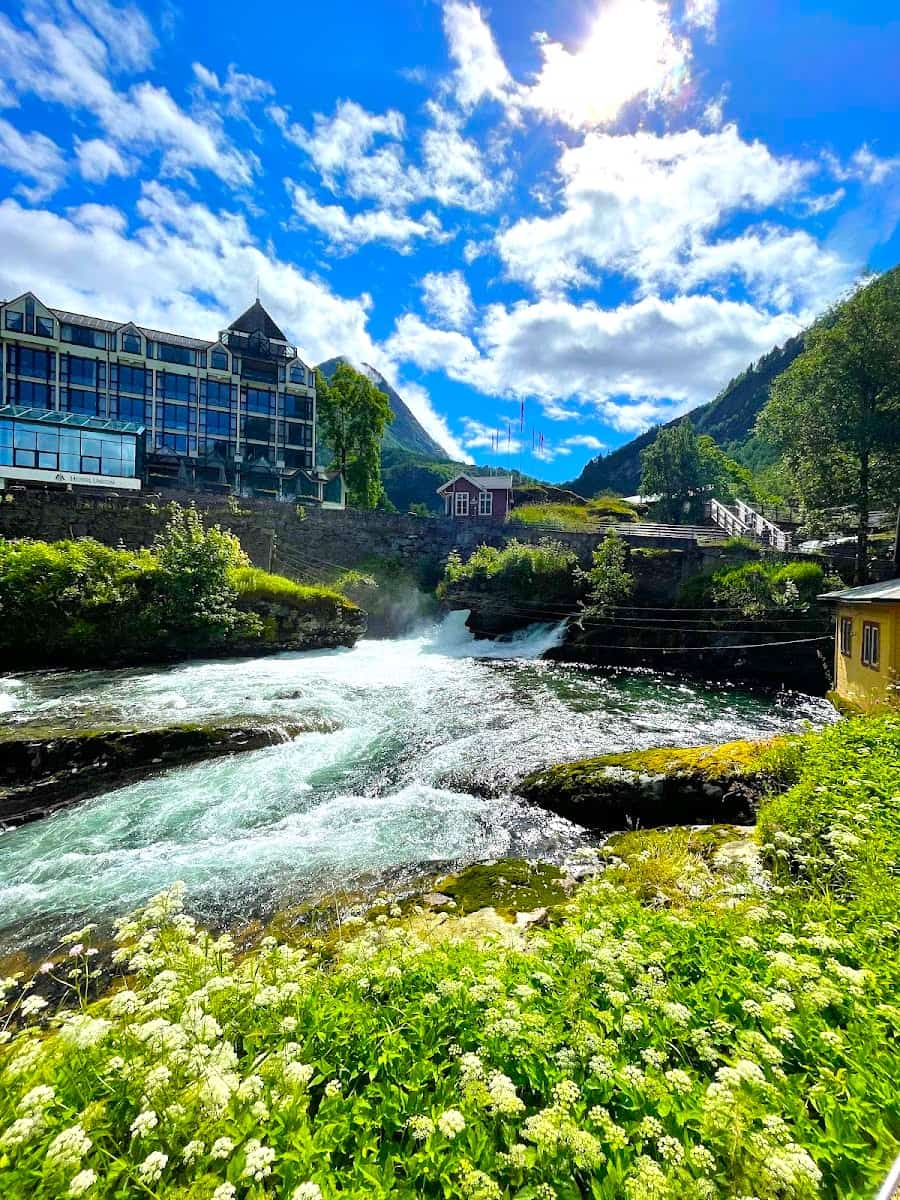
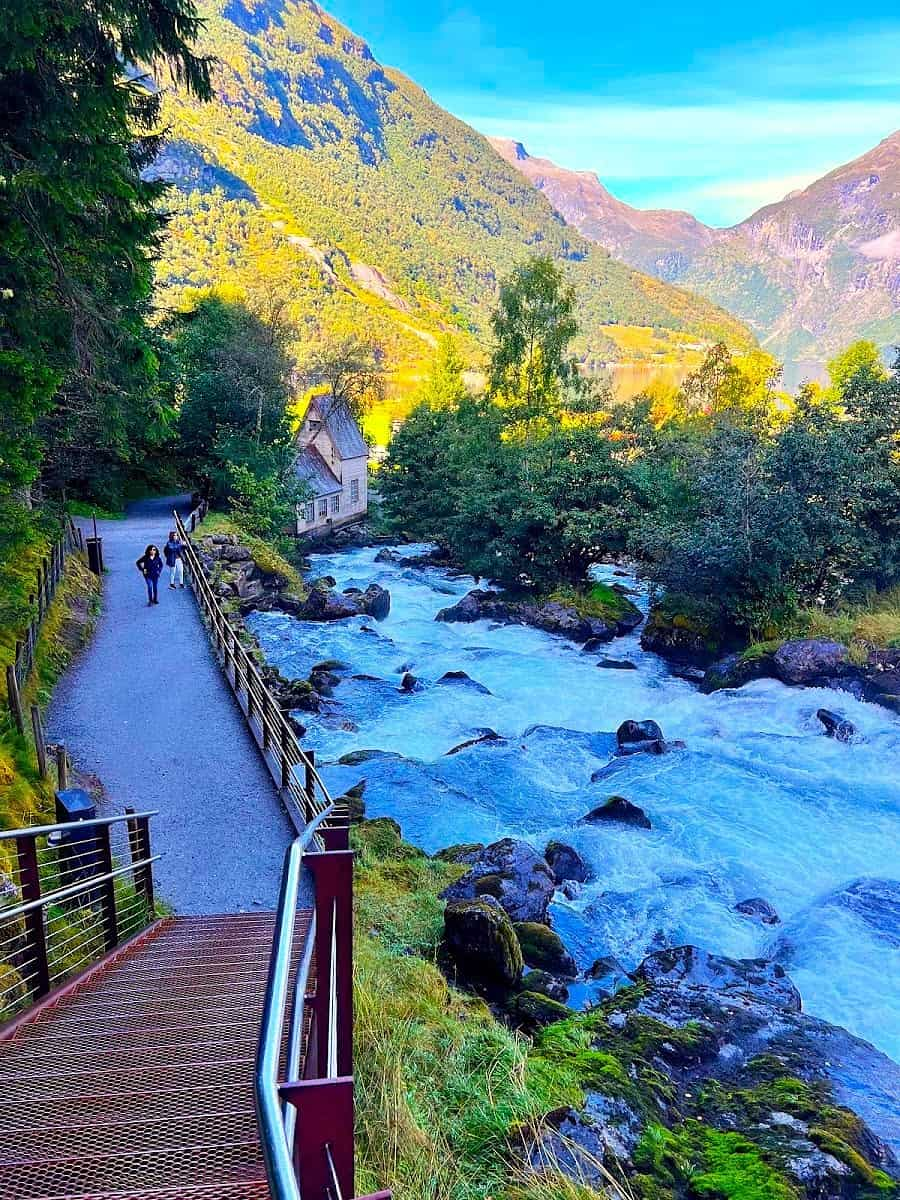
Step by step. The trail features exactly 327 steps (yes, I counted!), but they’re broken up into manageable sections with benches at regular intervals. The full route took me about 45 minutes one-way, climbing from the fjord level up to the Geiranger Skywalk viewpoint.
Waterfall Trail Sections:
| Section | Features | Difficulty |
|---|---|---|
| Lower (fjord to church) | Gentle incline, village views | Easy |
| Middle (church to Hotel Union) | Steeper steps, main waterfall | Moderate |
| Upper (Hotel Union to viewpoint) | Forest path, smaller cascades | Moderate |
Practical tip. I recommend wearing sturdy shoes with good grip, as some sections can be slippery from water spray. The trail is well-lit until 11 PM in summer, making it a perfect after-dinner activity when the daytime crowds have dispersed.
What You’ll See Along the Waterfall Trail:
- Historic water mill
- Several small waterfalls
- Traditional Norwegian houses
- Wildflowers (summer months)
- Geiranger Church
- Children’s playground (near the top)
- Panoramic fjord viewpoint
2. Flydalsjuvet Viewpoint
Postcard perfect. Flydalsjuvet viewpoint delivered the classic Geiranger photo opportunity I had seen on countless postcards and travel websites. Located just 4 km from the village center, this natural rock formation offers an unobstructed view of the fjord, village, and cruise ships far below.
Two-level experience. I discovered that Flydalsjuvet actually has two viewing platforms – the upper one accessible directly from the parking area, and a lower platform reached via a short but steep path. The lower viewpoint features the famous protruding rock where brave visitors can pose for dramatic photos.
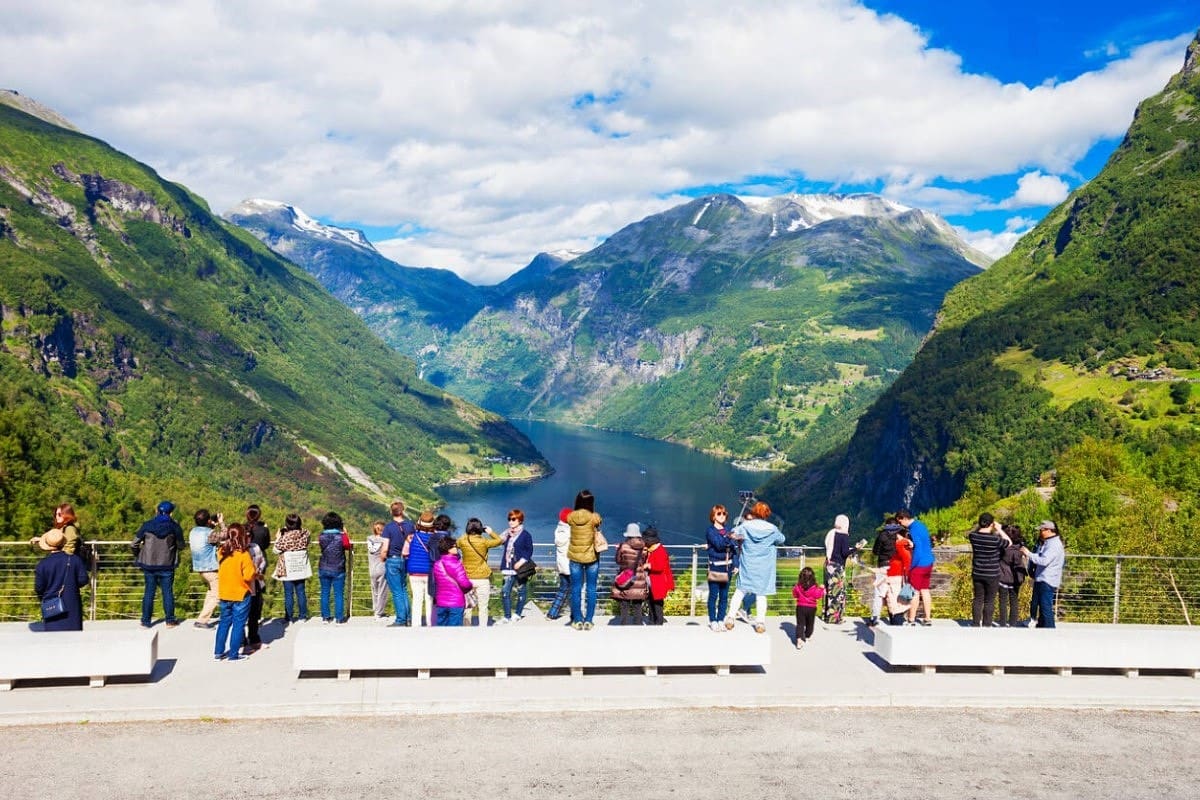
Photography paradise. This spot is particularly magical in the soft light of early morning or late afternoon when the fjord takes on a mystical quality. I visited around 7 PM and had the place almost entirely to myself, a stark contrast to the midday crowds.
Best Times to Visit Flydalsjuvet:
| Time | Advantages | Considerations |
|---|---|---|
| Early Morning (6-8 AM) | Soft light, few people | Potential morning mist |
| Midday (11 AM-3 PM) | Brightest views, cruise ships visible | Crowded, harsh light for photos |
| Evening (6-9 PM) | Warm light, fewer people | Shadows on parts of the fjord |
Historical significance. A small plaque informed me that the viewpoint’s name comes from “flya” (flat mountain area) and “juv” (gorge). Kaiser Wilhelm II of Germany made this spot famous by visiting annually before World War I, establishing Geiranger as a tourist destination.
Practical details. Access to Flydalsjuvet is completely free, with a small parking area that can accommodate about 15 cars. No facilities are available at the site, so I brought my own water and snacks. The viewpoint is accessible year-round, though winter visits require appropriate footwear due to potential ice.
Photography Tips for Flydalsjuvet:
- Wide-angle lens for capturing the entire fjord bend
- Polarizing filter to reduce glare from the water
- Tripod for low-light shots and long exposures
- Patient waiting for ships to enter the frame
- Careful positioning to include both mountains and water
3. Ørnesvingen (Eagle’s Road) Viewpoint
Engineering wonder. Ørnesvingen, or Eagle’s Road, impressed me with both its remarkable engineering and breathtaking views. This series of 11 hairpin turns climbs steeply from Geiranger village up the mountainside, with a purpose-built viewing platform about halfway up.
Historical context. Information boards at the viewpoint explained that Eagle’s Road was completed in 1955, finally connecting Geiranger to Eidsdal year-round. Before this road, the village was often isolated during winter months – a fascinating glimpse into how recent modern connectivity is in this remote region.
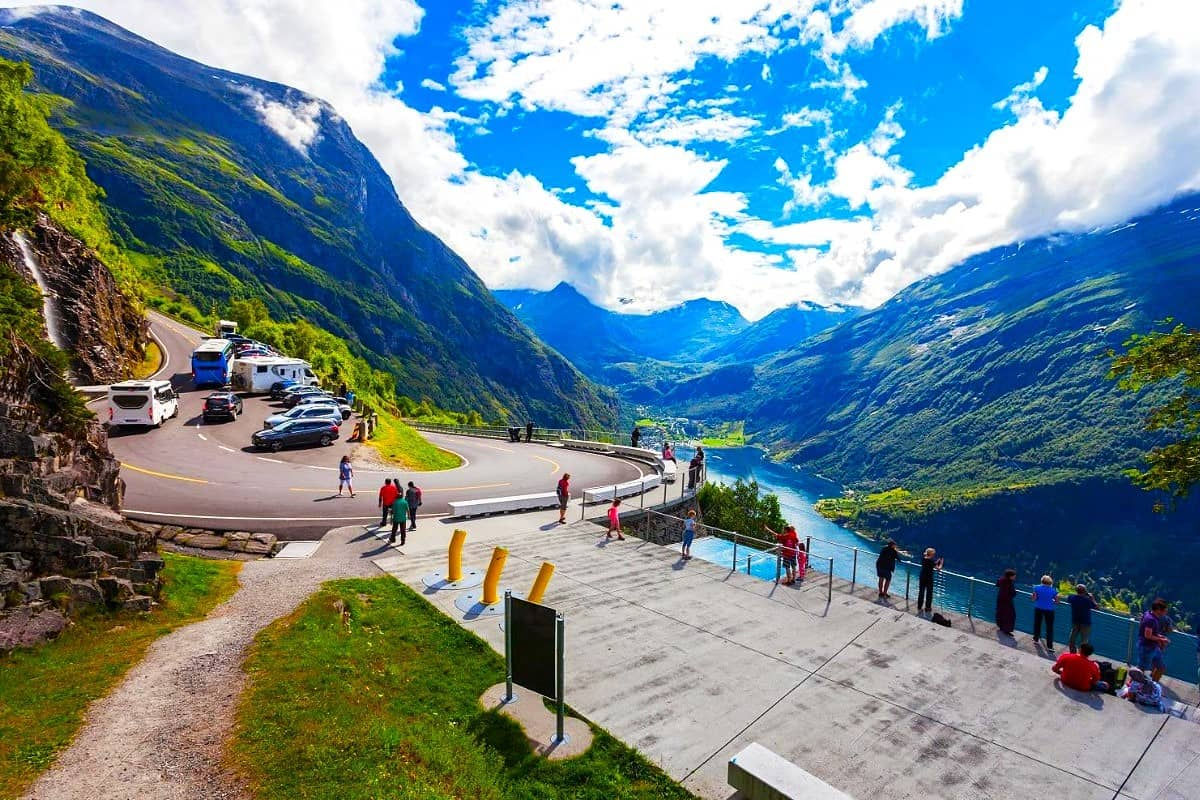
Eagle’s Road Facts:
| Feature | Detail |
|---|---|
| Elevation Gain | 620 meters |
| Number of Hairpin Turns | 11 |
| Construction Completed | 1955 |
| Distance from Geiranger | 7 km to viewpoint |
| Viewing Platform Built | 2006 |
Facilities available. Unlike some other viewpoints, Ørnesvingen offers clean public toilets, several picnic tables, and information panels in multiple languages. I appreciated these amenities during my visit, making it easy to spend time enjoying the view without rushing.
Access options. While most visitors drive to Ørnesvingen, I chose to hike up from the village, which took about 1.5 hours on a clear path that occasionally cuts across the hairpin road turns. The hike offered additional perspectives and photo opportunities that drivers miss, though it is quite steep in sections.
Ways to Experience Ørnesvingen:
- Drive and park at the designated viewpoint
- Cycle up (for experienced cyclists only)
- Join a guided bus tour from Geiranger
- Continue driving to connect with Trollstigen route
⭐ Best Activities
- Geiranger Excursion: Mount Dalsnibba and Eagle's Bend – Visit the spectacular viewpoint and the famous Eagle’s Bend road on this guided excursion in Geiranger.
4. Geiranger Village
Charming simplicity. Despite its global fame, Geiranger village remains refreshingly small and walkable. I spent a delightful afternoon exploring its compact center, discovering that beyond the souvenir shops lies an authentic Norwegian community with interesting architecture and friendly locals.
Waterfront magic. The harbor area was my favorite spot for people-watching, with its mix of arriving tourists, local fishermen, and boat operators. The contrast between massive ships and tiny local vessels created a fascinating juxtaposition, especially beautiful in the evening light.
Local flavors. During my village stroll, I discovered several small cafés serving traditional Norwegian waffles with sour cream and jam. At Brasserie Posten, I tried brunost (brown cheese) ice cream – an unusual but delicious local specialty for 65 NOK (~$6) that perfectly complemented my afternoon walk.
Highlights:
| Attraction | Description | Location |
|---|---|---|
| Geiranger Sjokolade | Artisanal chocolate shop with fjord-inspired flavors | Near the harbor |
| Geiranger Brewery | Local craft beer tasting room | Main street |
| Historical Photo Exhibition | Outdoor display of historical Geiranger photos | Harbor promenade |
| Local Craft Market | Seasonal stalls selling handmade items | Village square |
| Brasserie Posten | Historic post office converted to café | Central village |
Seasonal differences. I visited in June when the village was lively but not overcrowded. A local shopkeeper told me that July and August bring much larger crowds, while May and September offer a more peaceful experience with most facilities still open.
Shopping tip. While souvenir prices in Geiranger are generally high, I found the quality of locally-made items to be excellent. The wool products and handcrafted trolls make authentic mementos of a visit, though they’re significantly more expensive than mass-produced alternatives.
Best Times for Village Exploration:
- Early morning (before cruise ship arrivals)
- Lunchtime (when most tour groups are at restaurants)
- Evening (after day-trippers have departed)
- Rainy days (fewer people outdoors)
- Shoulder season (May and September)
5. Visit Geiranger Church
Spiritual simplicity. Geiranger’s octagonal wooden church charmed me with its understated beauty and peaceful atmosphere. Built in 1842, this white-painted structure sits on a small hill overlooking the village, offering both spiritual solace and lovely views of the surrounding landscape.
Architectural interest. The octagonal design is unusual for Norwegian churches, making it architecturally significant despite its modest size. Inside, I found simple wooden pews, a beautiful altarpiece, and a small organ – all bathed in light from large windows that frame views of the mountains.
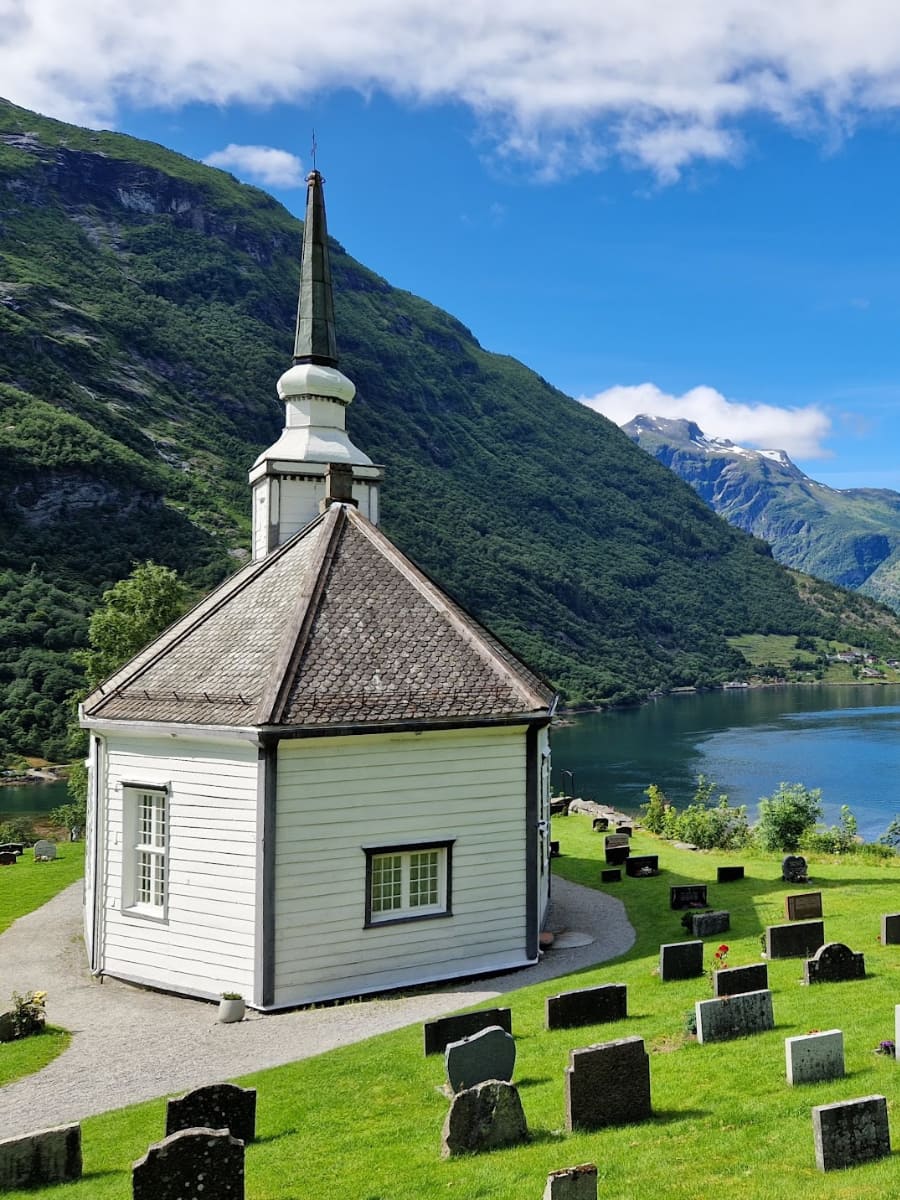
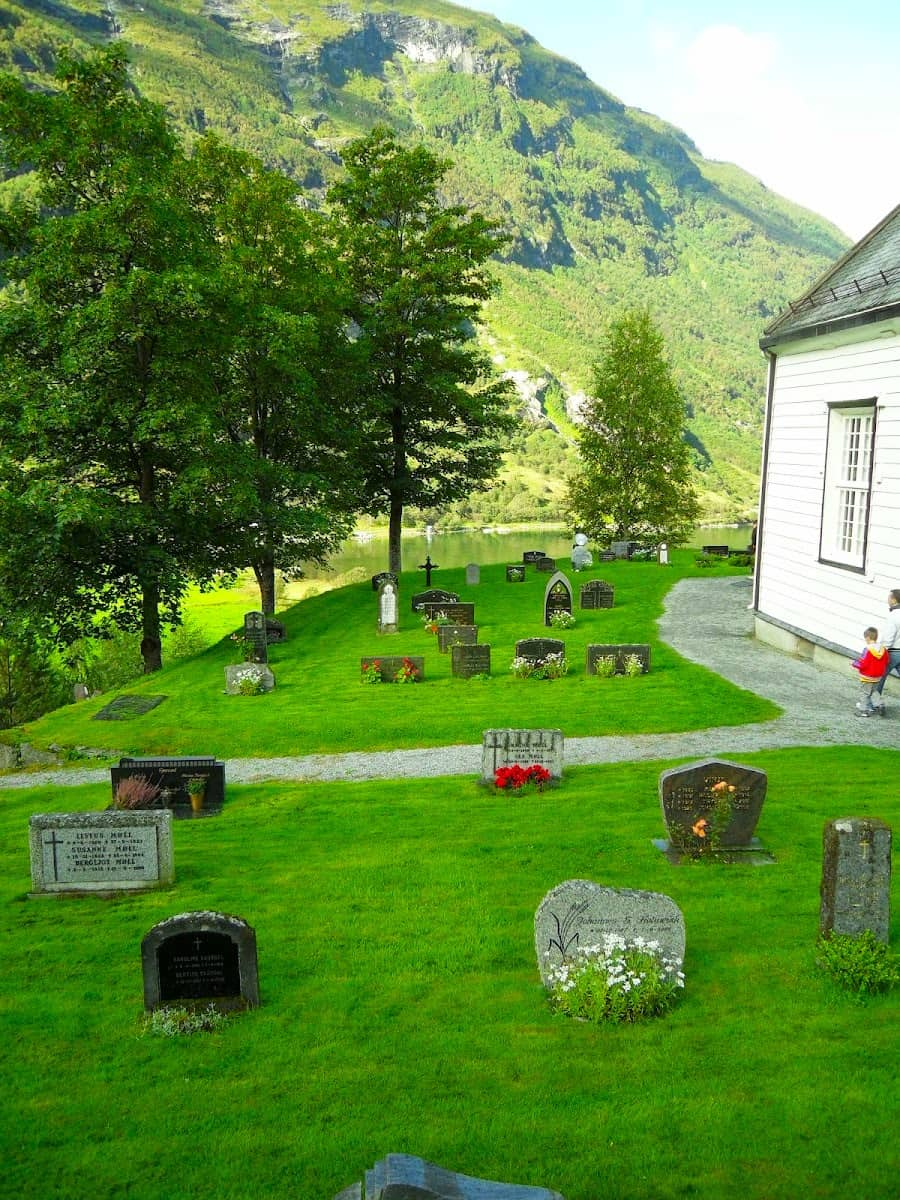
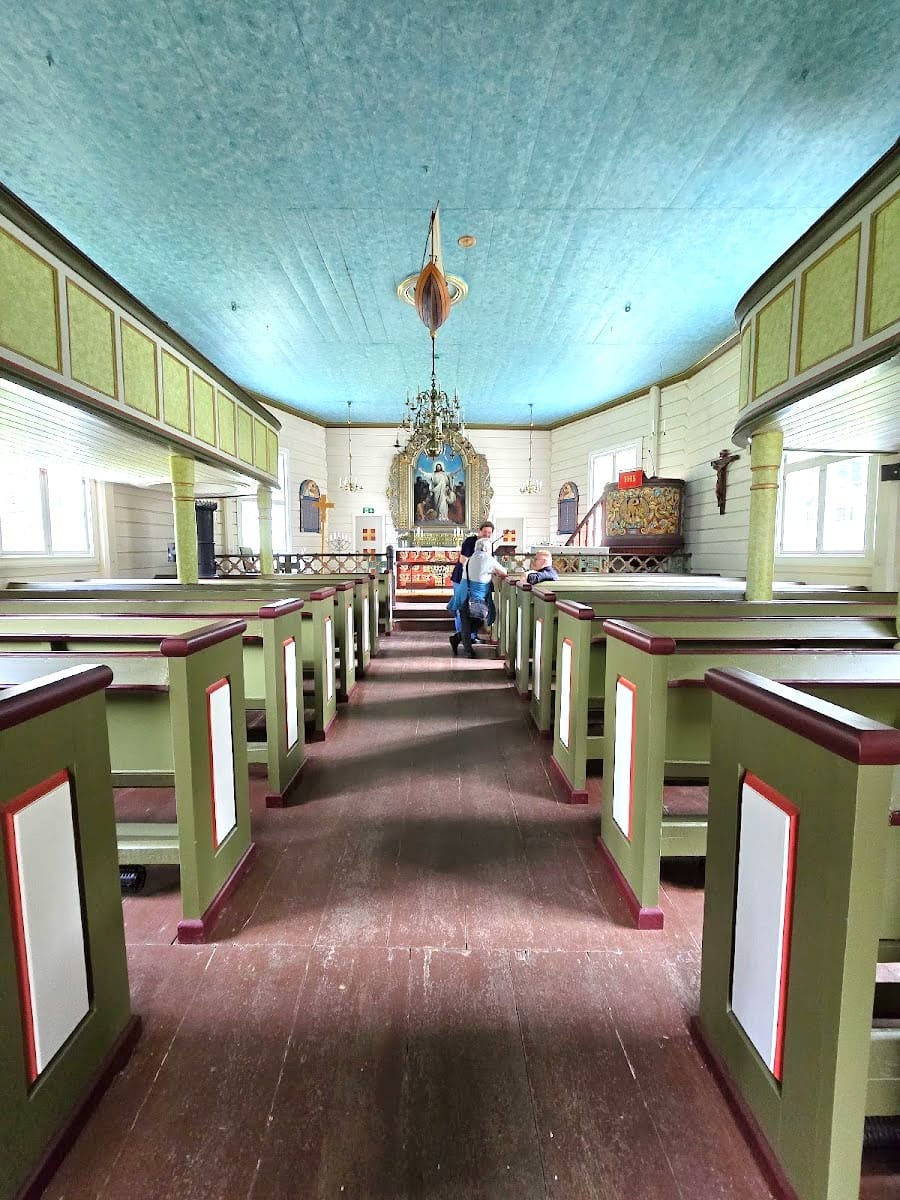
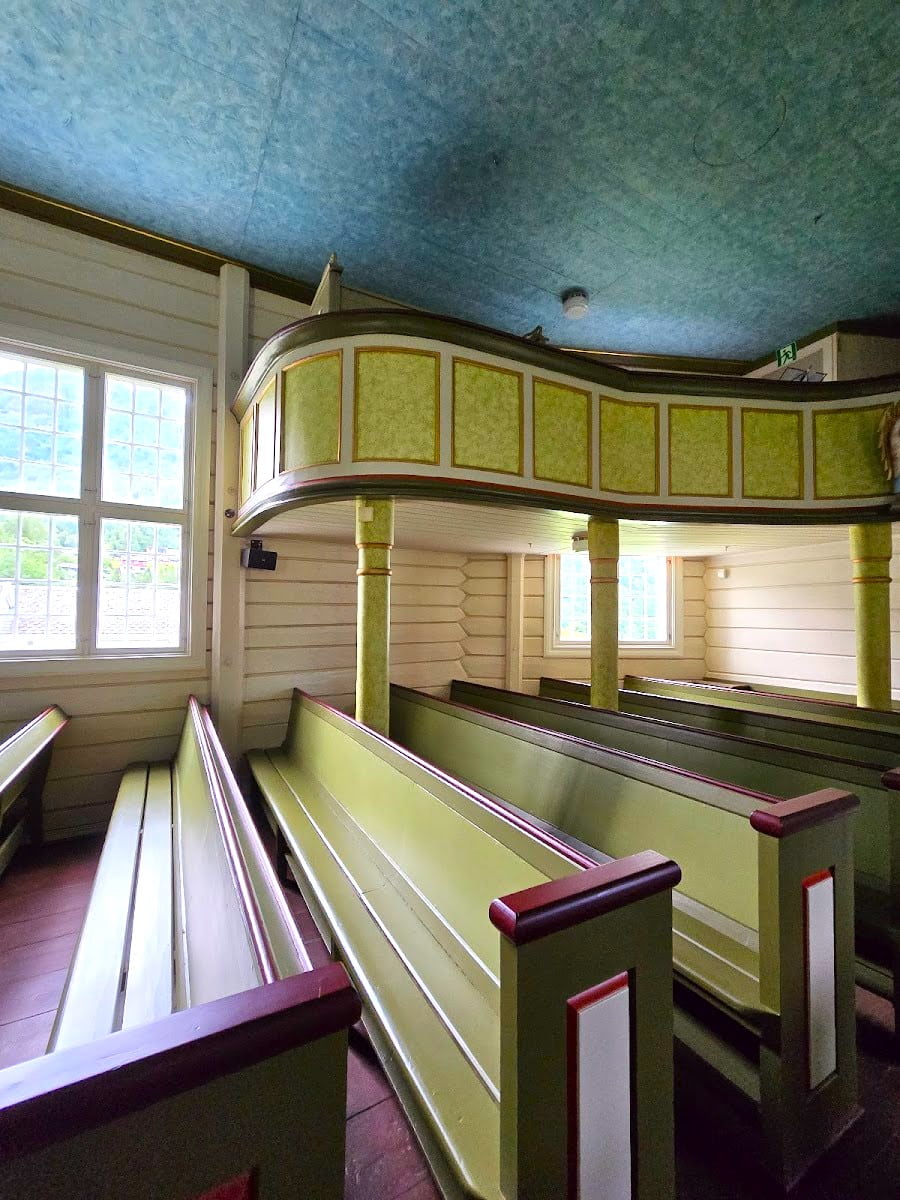
Historical connection. A small exhibition in the entrance explained how the church served as the community’s anchor through challenging times, including periods when Geiranger was completely isolated by winter weather or avalanches. The adjacent cemetery contains graves dating back generations, telling the story of this resilient community.
Geiranger Church Details:
| Feature | Information |
|---|---|
| Built | 1842 |
| Architectural Style | Octagonal wooden church |
| Seating Capacity | Approximately 120 |
| Summer Services | Sundays at 11:00 AM |
| Concerts | Occasional evening performances (summer) |
Visitor etiquette. The church welcomes visitors outside of service times, asking only for respectful behavior and modest donations in the collection box. I spent about 30 minutes exploring the interior and grounds, appreciating the peaceful contrast to the bustling tourist areas nearby.
Musical moments. I was fortunate to visit when the organist was practicing for Sunday service, filling the space with beautiful music. A notice board indicated that summer evening concerts are occasionally held, featuring local musicians and traditional Norwegian compositions.
What to Notice at Geiranger Church:
- Handcrafted wooden pulpit
- Traditional Norwegian rose painting details
- Historic baptismal font
- Memorial plaques to local families
- Views of the fjord from the cemetery
- Original church bell (still in use)
- Architectural details of the octagonal structure
Things to Do in Geiranger with Kids
1. Playground at the End of Waterfall Trail
Adventure zone. The playground near the top of the Waterfall Trail quickly became my children’s favorite spot in Geiranger. After the satisfaction of climbing the 327 steps, they were rewarded with a well-designed play area that kept them entertained for hours while offering parents spectacular fjord views.
Unique equipment. Unlike standard playgrounds, this one features equipment inspired by local nature and culture – including a mini Viking ship, climbing structures resembling mountain formations, and slides built into the natural slope. My kids particularly loved the zipline that mimics flying over a fjord.
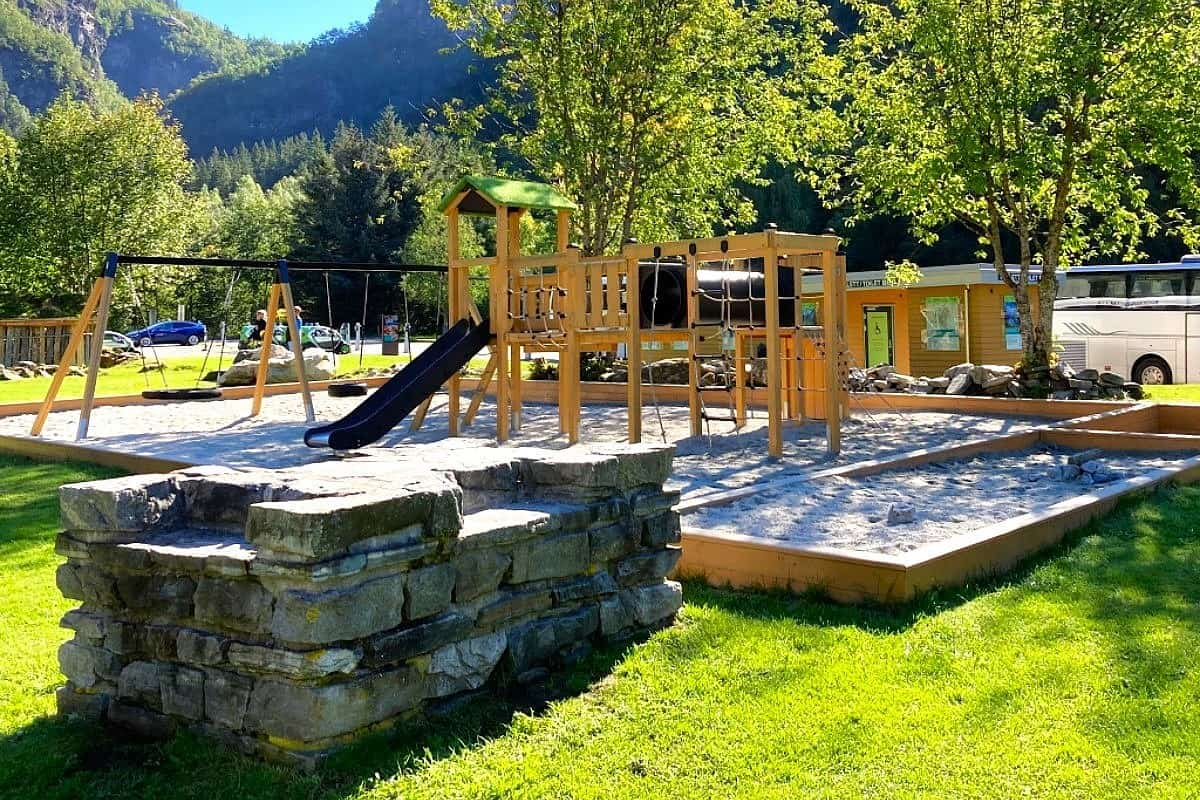
Natural integration. What impressed me most was how seamlessly the playground blends with its natural surroundings. Built using sustainable materials and nestled among trees, it encourages children to connect with nature while playing. The sound of the nearby waterfall adds a soothing soundtrack to playtime.
Playground Facilities:
| Feature | Age Suitability | Notes |
|---|---|---|
| Toddler Area | 1-4 years | Soft surfaces, small slides |
| Adventure Zone | 5-12 years | Climbing structures, zipline |
| Picnic Tables | All ages | Shaded seating for parents |
| Water Play Feature | All ages | Safe access to shallow stream |
| Restrooms | All | Clean facilities nearby |
Local interaction. We met several Norwegian families at the playground, giving both parents and children a chance to connect with locals. My daughter quickly joined a game with Norwegian children despite the language barrier – play truly is a universal language!
Tips for Visiting with Kids:
- Bring a small towel (water play can get messy)
- Pack snacks and drinks (no food vendors nearby)
- Allow at least 1-2 hours for play time
- Visit in morning for fewer crowds
- Wear sunscreen (limited shade in some areas)
2. Farm Visit and Animal Feeding at Westerås Farm
Rural charm. Westerås Farm offered my family a delightful break from typical tourist activities in Geiranger. Located on a hillside above the village, this working farm welcomes visitors to experience traditional Norwegian farm life and interact with a variety of friendly animals.
Animal encounters. My children were thrilled to hand-feed the resident goats, sheep, and rabbits. The farm staff provided appropriate food and clear instructions on how to approach each animal safely. The highlight for my son was meeting the farm’s llamas, which he hadn’t expected to find in Norway!
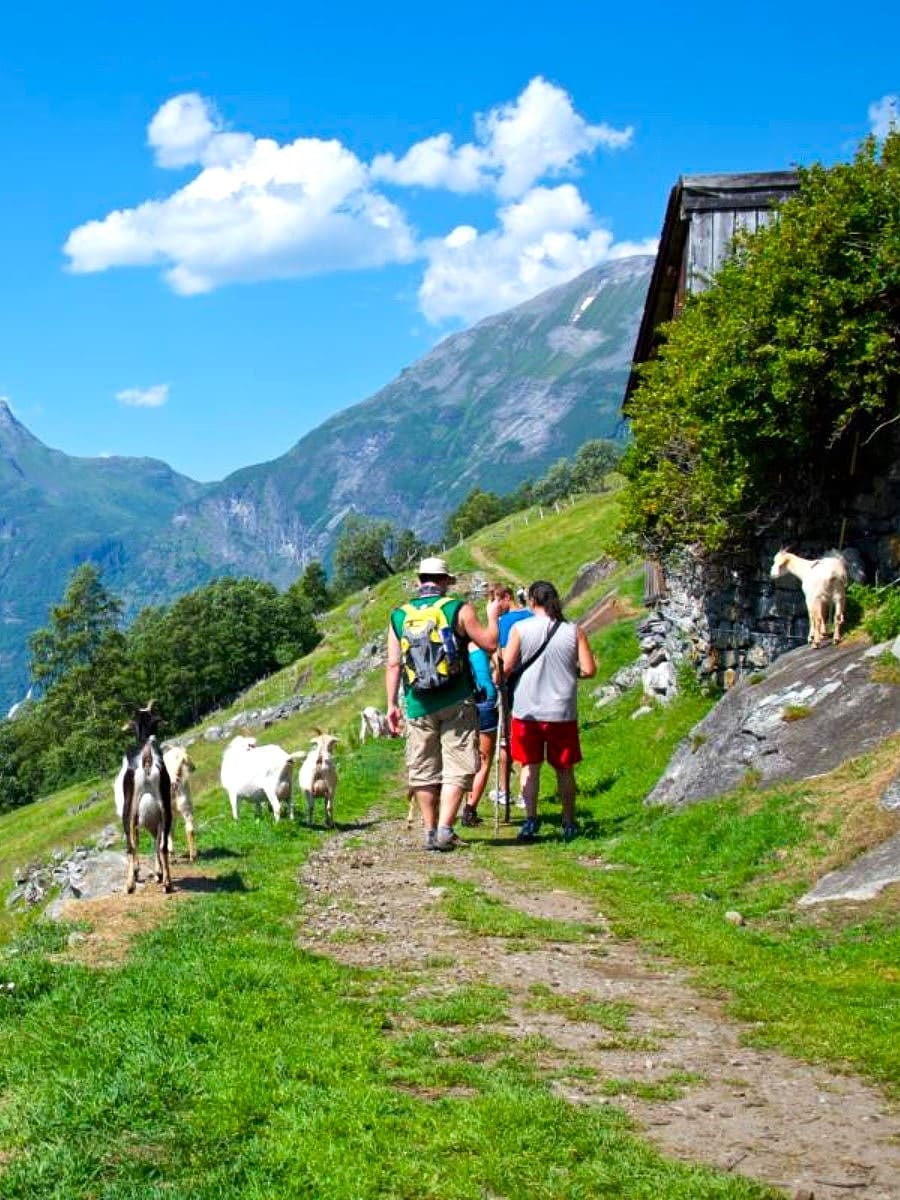
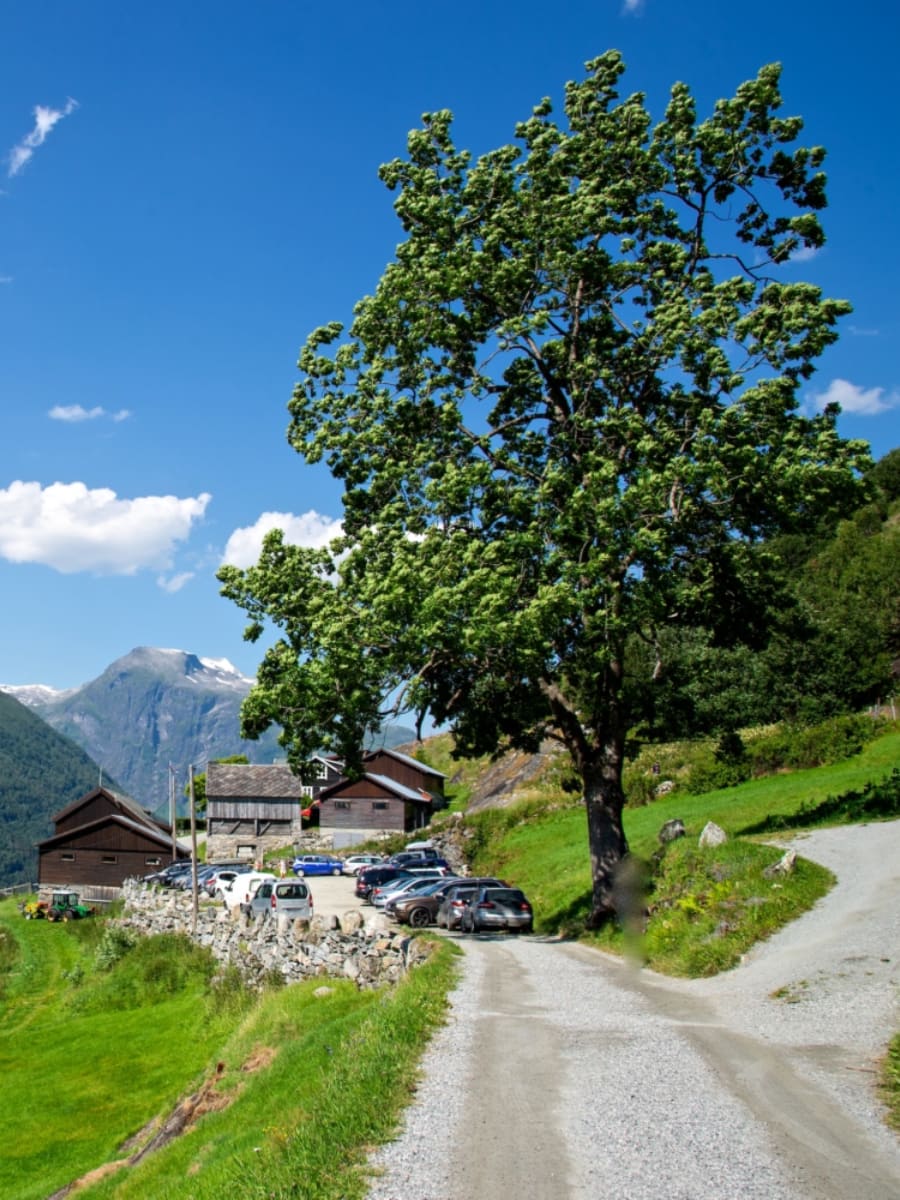
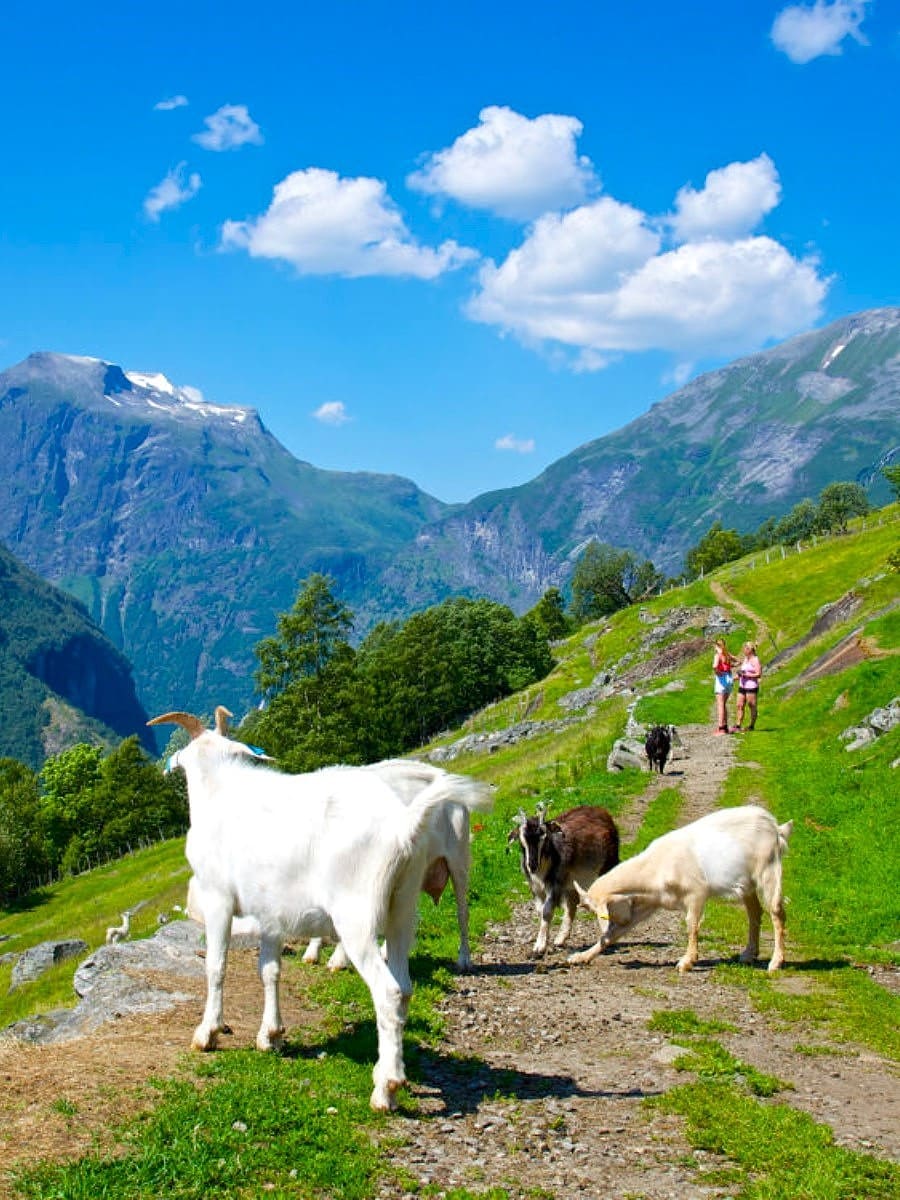
Educational value. Beyond simple animal petting, Westerås offers insights into sustainable farming practices and the challenges of agriculture in Norway’s mountainous terrain. My kids learned how goat milk becomes traditional brown cheese and why Norwegian farm animals spend summers in mountain pastures.
Animals at Westerås Farm:
| Animal | Interaction Possible | Best Time to Visit |
|---|---|---|
| Goats | Feeding, petting | Morning feeding (9 AM) |
| Sheep | Gentle petting | Afternoon (2-4 PM) |
| Rabbits | Supervised holding | Anytime during open hours |
| Llamas | Viewing, occasional petting | Morning hours |
| Farm cats | Varies (they’re cats!) | Unpredictable |
| Chickens | Egg collection (seasonal) | Early morning |
Taste of tradition. The farm café served homemade waffles with cream and jam made from berries grown on the property. At 85 NOK (~$8) per serving, they were both delicious and reasonably priced compared to village restaurants. The outdoor seating area offered spectacular fjord views while we enjoyed our treat.
Access options. We drove to Westerås (about 5 minutes from Geiranger center), but many families hike the marked trail that takes approximately 30-40 minutes each way.
Family Activities at Westerås Farm:
- Animal feeding (free with farm visit)
- Traditional farm buildings exploration
- Short nature trails suitable for children
- Seasonal activities (berry picking in summer)
- Farm café with kid-friendly menu
- Tractor rides (weekends in peak season)
Seasonal Activities in Geiranger
1. Christmas in Geiranger
Winter wonderland. Experiencing Geiranger during Christmas season showed me a completely different side of this famous destination. The village transforms into a peaceful snow-covered haven, with dramatically fewer tourists than summer months and a magical atmosphere that feels authentically Norwegian.
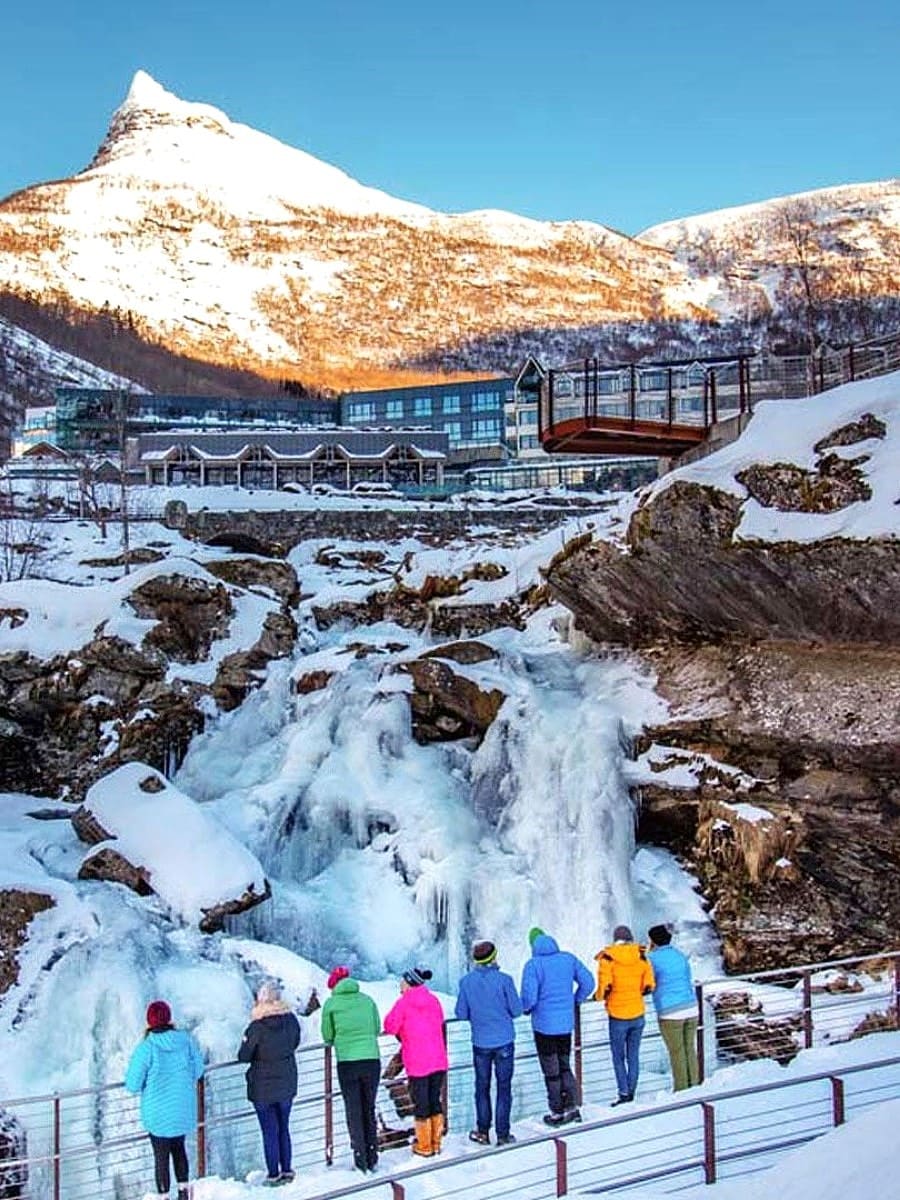
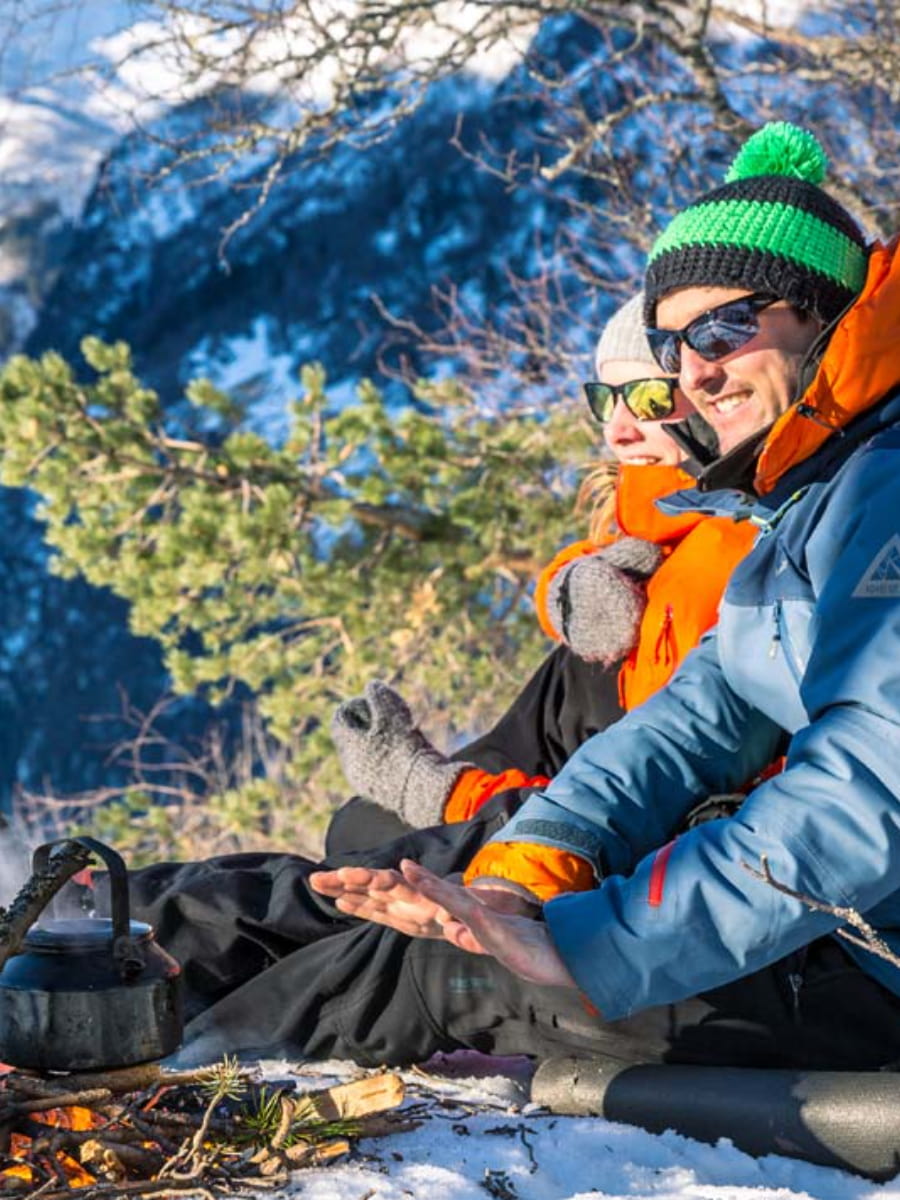
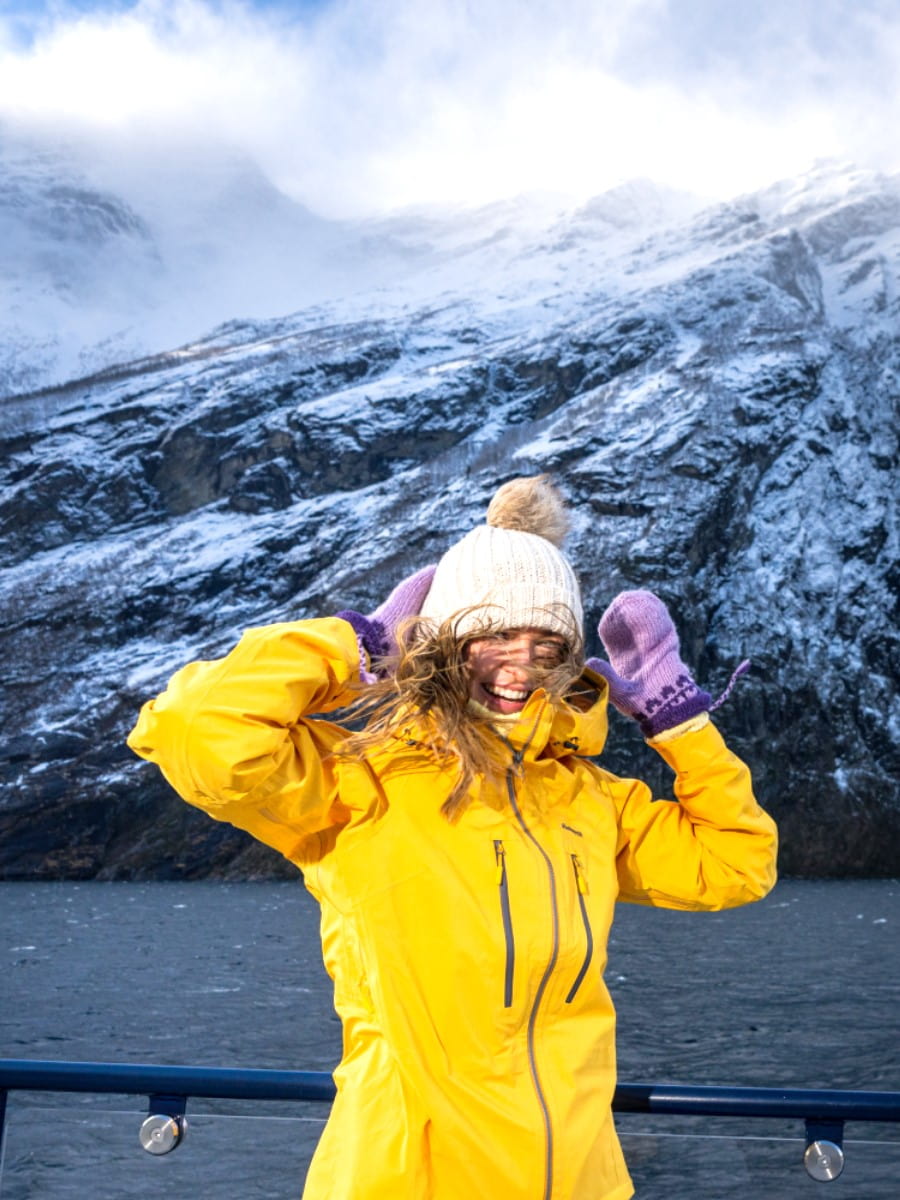
Festive traditions. The annual Christmas market (Julemarked) in Geiranger takes place the first weekend of December, featuring local crafts, traditional foods, and performances of Norwegian Christmas songs. I purchased beautiful handmade ornaments and sampled gløgg (mulled wine) while chatting with local artisans.
Cozy atmosphere. Hotel Union hosts a traditional Norwegian Christmas buffet (Julebord) throughout December, where I indulged in specialties like ribbe (pork ribs), pinnekjøtt (dried lamb ribs), and multitudes of Christmas cookies. The experience cost 595 NOK (~$56) per person and required advance booking.
Christmas Events in Geiranger:
| Event | Dates | Location | Cost |
|---|---|---|---|
| Christmas Market | First weekend of December | Village center | Free entry |
| Christmas Concert | December 20 | Geiranger Church | 150 NOK (~$14) |
| Traditional Julebord | December 1-23 | Hotel Union | 595 NOK (~$56) |
| New Year’s Celebration | December 31 | Waterfront | Free (fireworks) |
Winter activities. While many summer attractions are closed, winter offers unique experiences like snowshoeing on marked trails, cross-country skiing on prepared tracks, and even ice fishing on frozen mountain lakes. Equipment rental is available at Hotel Union for approximately 250 NOK (~$24) per day.
Winter Packing Essentials for Geiranger:
- Thermal base layers
- Waterproof boots with good grip
- Insulated jacket and pants
- Hat, gloves, and scarf
- Headlamp (limited daylight hours)
- Thermos for hot drinks
- Crampons for icy conditions
- Camera with extra batteries (cold drains them quickly)
2. Summer Festivals and Events
Active celebrations. The Geiranger Half Marathon (July 15) attracts runners from across Norway and beyond. While I didn’t participate in the race itself, the festive atmosphere and route along the dramatic Eagle’s Road made for excellent spectating and photography opportunities.
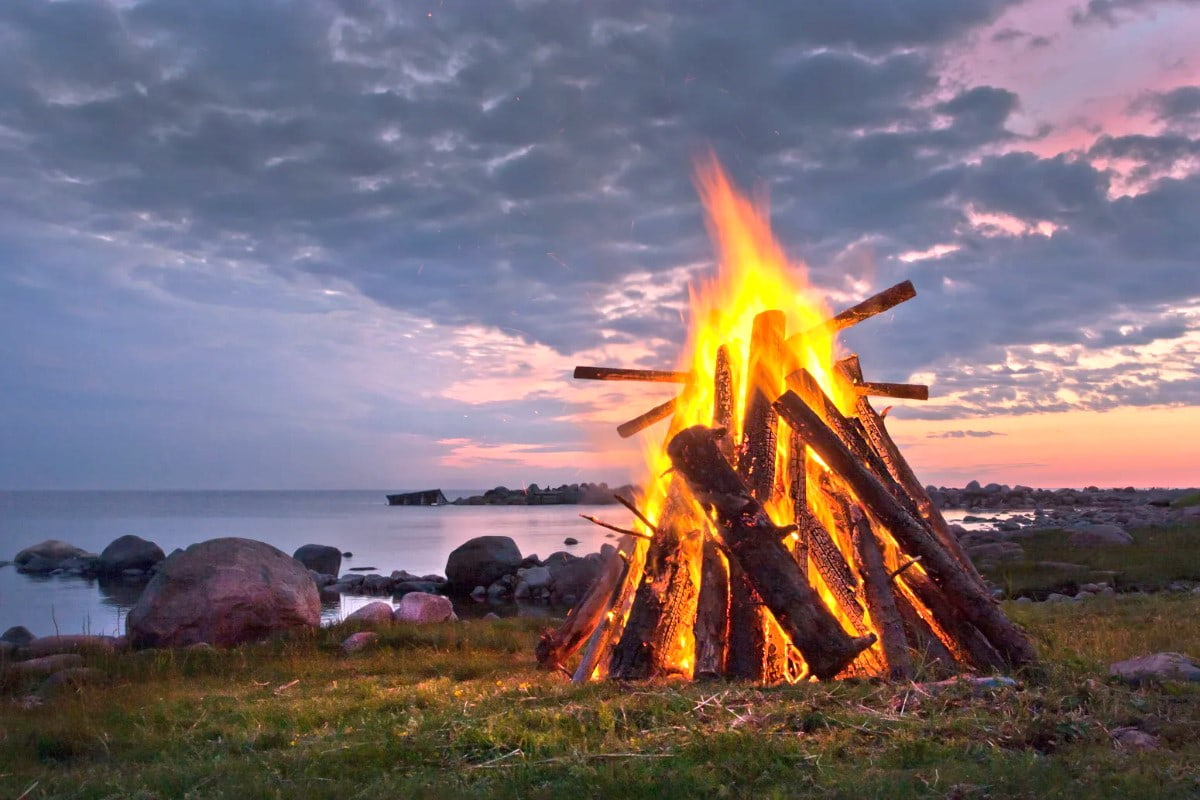
Summer Events Calendar:
| Event | Date | Description | Entry Fee |
|---|---|---|---|
| Midsummer Celebration | June 23 | Bonfire, traditional dancing | Free |
| Geiranger Half Marathon | July 15 | Race along Eagle’s Road | 750 NOK to participate |
| Geiranger Music Festival | July 20-23 | Various concerts and performances | From 200 NOK per concert |
| Local Food Festival | August 5-6 | Tastings of regional specialties | Free entry, pay for tastings |
| Fjord Rowing Competition | August 19 | Traditional wooden boat races | Free to watch |
Local flavors. The Geiranger Food Festival (August 5-6) was a culinary highlight, offering tastings of regional specialties like smoked salmon, brown cheese, cloudberry desserts, and local craft beers. Cooking demonstrations by local chefs taught traditional techniques using ingredients from nearby farms and fjords.
Practical tip. I found accommodation prices peak during these festival periods, so booking at least 6 months in advance is essential. Many events offer online ticket purchases, which I recommend securing early as popular performances sell out quickly.
Festival Attendance Tips:
- Book accommodation well in advance
- Purchase tickets online when possible
- Bring cash for food vendors
- Pack layers for outdoor events
- Check event websites for schedule changes
- Arrive early for best viewing spots
- Consider nearby villages for accommodation if Geiranger is full
3. Spring Blooms in Royal Parks
Awakening landscape. Visiting Geiranger in late May revealed the magical transformation of winter into spring. The surrounding hillsides burst with vibrant wildflowers and fresh greenery, creating a colorful contrast against the still-snow-capped mountain peaks.
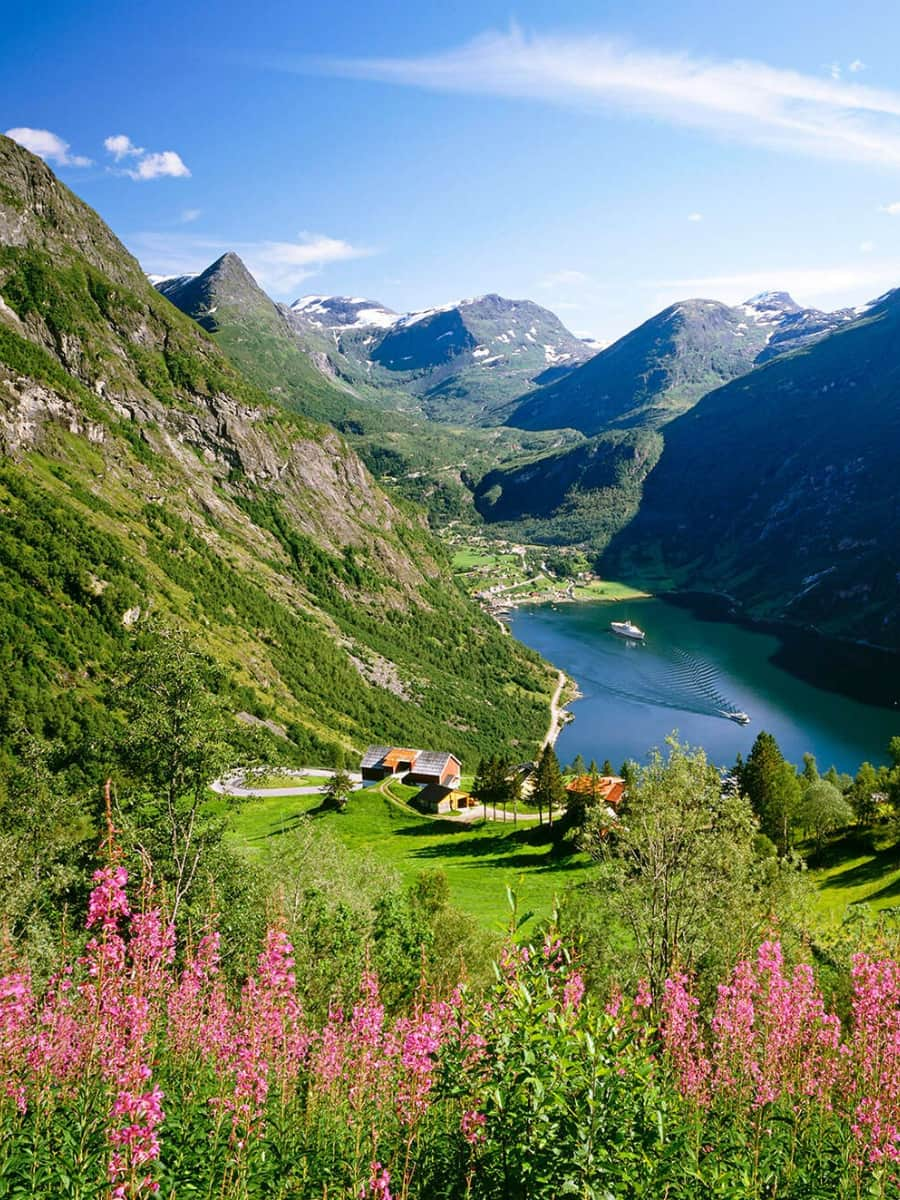
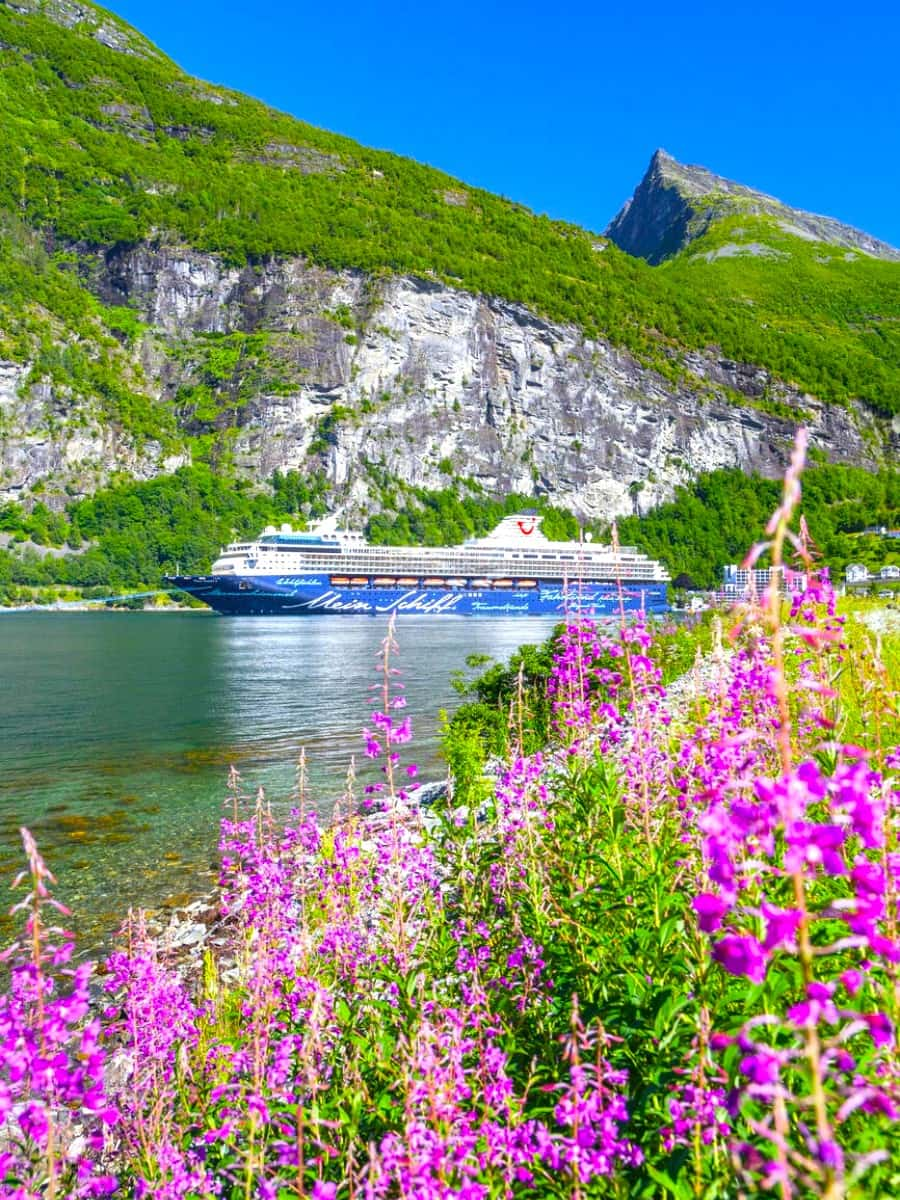
Spring Wildflowers in Geiranger:
| Flower | Blooming Period | Where to Find |
|---|---|---|
| Purple Saxifrage | Early May | Rocky areas near fjord |
| Mountain Avens | Mid-May to June | Higher elevation trails |
| Arctic Bell-heather | Late May | Forested areas |
| Globeflower | May-June | Meadows and stream edges |
| Alpine Forget-me-not | June | Mountain trails |
Weather variability. Spring weather in Geiranger can change rapidly, with my experience ranging from warm sunshine to brief snow flurries within a single day. Layered clothing proved essential, as did waterproof hiking boots for navigating occasionally muddy trails.
Opening season. It’s worth noting that some attractions begin limited operations in May before full summer schedules. The fjord cruise was running on a reduced timetable (2 departures daily instead of hourly), and several restaurants were open only on weekends. However, this transitional period offered a more authentic glimpse of local life.
Spring Activities in Geiranger:
- Waterfall photography at peak flow
- Wildflower identification walks
- Bird watching (spring migration period)
- Less crowded hiking trails
- First fjord cruises of the season
- Watching snow retreat up mountainsides
- Seasonal menu items featuring spring ingredients
4. Autumn Foliage Walks
Color explosion. My September visit to Geiranger coincided with the peak of autumn colors, transforming the landscape into a spectacular palette of reds, oranges, and golds. The contrast between vibrant foliage, dark green pines, and the deep blue fjord created postcard-perfect scenes at every turn.
Tranquil atmosphere. With summer crowds gone and ships reduced to just occasional visits, autumn in Geiranger offers a peaceful experience closer to how locals enjoy their stunning surroundings. Trails that were busy in August became serene paths through rustling leaves and quiet forests.
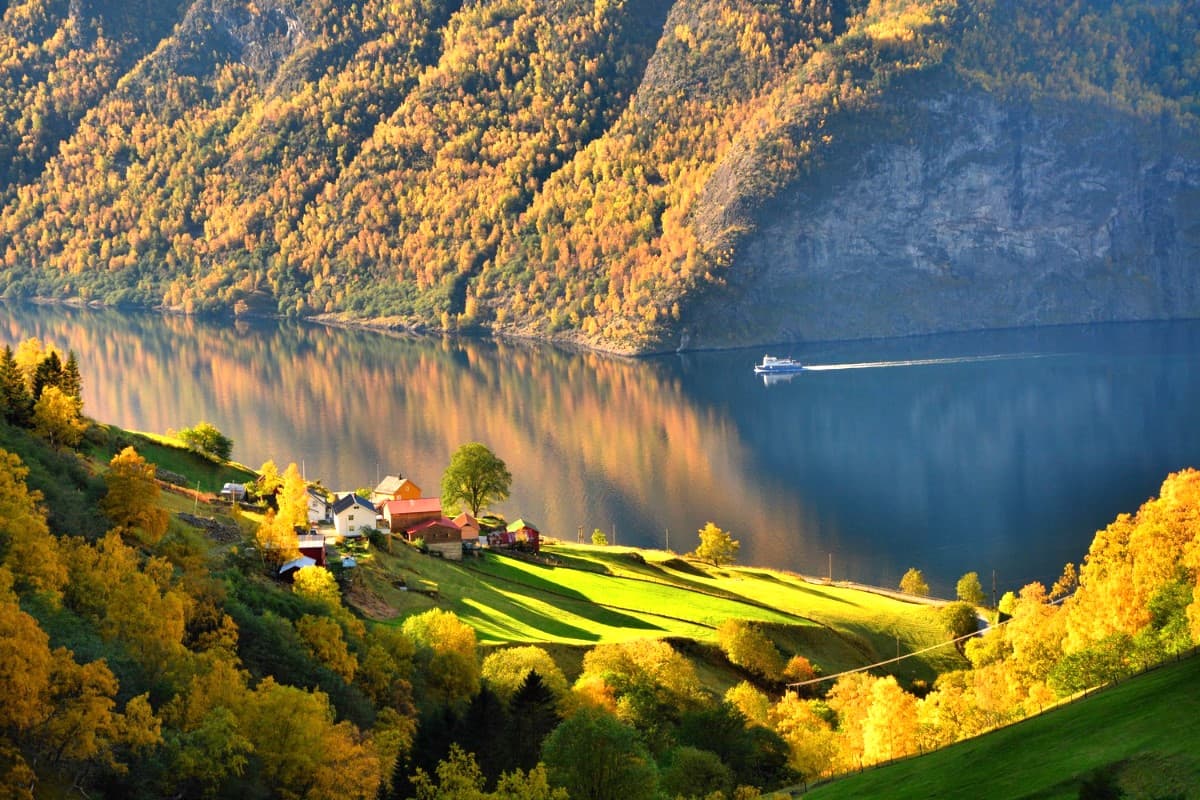
Photography heaven. The combination of autumn colors, dramatic lighting, and clearer air made this season ideal for photography. Morning mist rising from the fjord created ethereal scenes, while the lower angle of the sun brought out textures in the landscape that summer’s harsh light often flattens.
Best Autumn Hiking Trails:
| Trail | Distance | Difficulty | Fall Foliage Rating |
|---|---|---|---|
| Storsæterfossen Loop | 5 km | Moderate | ★★★★★ (Exceptional) |
| Vesterås Farm Paths | 3-7 km | Easy to Moderate | ★★★★☆ (Excellent) |
| Waterfall Trail | 2 km | Easy | ★★★☆☆ (Good) |
| Skageflå Farm | 5.5 km | Challenging | ★★★★★ (Exceptional) |
| Homlongsætra | 8 km | Moderate | ★★★★☆ (Excellent) |
Seasonal treats. Local cafés featured autumn specialties during my visit, including apple cake made with fruit from nearby orchards and warming mushroom soup using foraged fungi. At Brasserie Posten, I enjoyed their seasonal “Taste of Autumn” menu for 395 NOK (~$37), featuring local game and root vegetables.
Practical considerations. While most attractions remain open through September, many begin reduced hours or seasonal closure in October. I found this transitional period offered good value, with accommodation prices dropping by 30-40% from summer peaks while weather remained generally favorable.
Autumn Photography Tips for Geiranger:
- Early morning for mist over the fjord
- Polarizing filter to enhance leaf colors
- Include the fjord in compositions for color contrast
- Overcast days for even lighting in forests
- Capture falling leaves with slow shutter speeds
- Look for reflections in calm water
- Frame waterfalls with colorful foliage
Day Trips from Geiranger
1. Hellesylt Village
Charming contrast. The village offered me a delightful counterpoint to Geiranger – equally scenic but significantly less touristed. This small village sits at the head of Sunnylvsfjord, just a 50-minute ferry ride or 1-hour drive from Geiranger, making it perfect for a half-day excursion.
Waterfall centerpiece. The most striking feature is its dramatic waterfall that cuts right through the center of the village. Unlike Geiranger’s distant cascades, this powerful waterfall is integrated into the community, with bridges crossing directly over it and buildings perched alongside – creating unique photo opportunities.
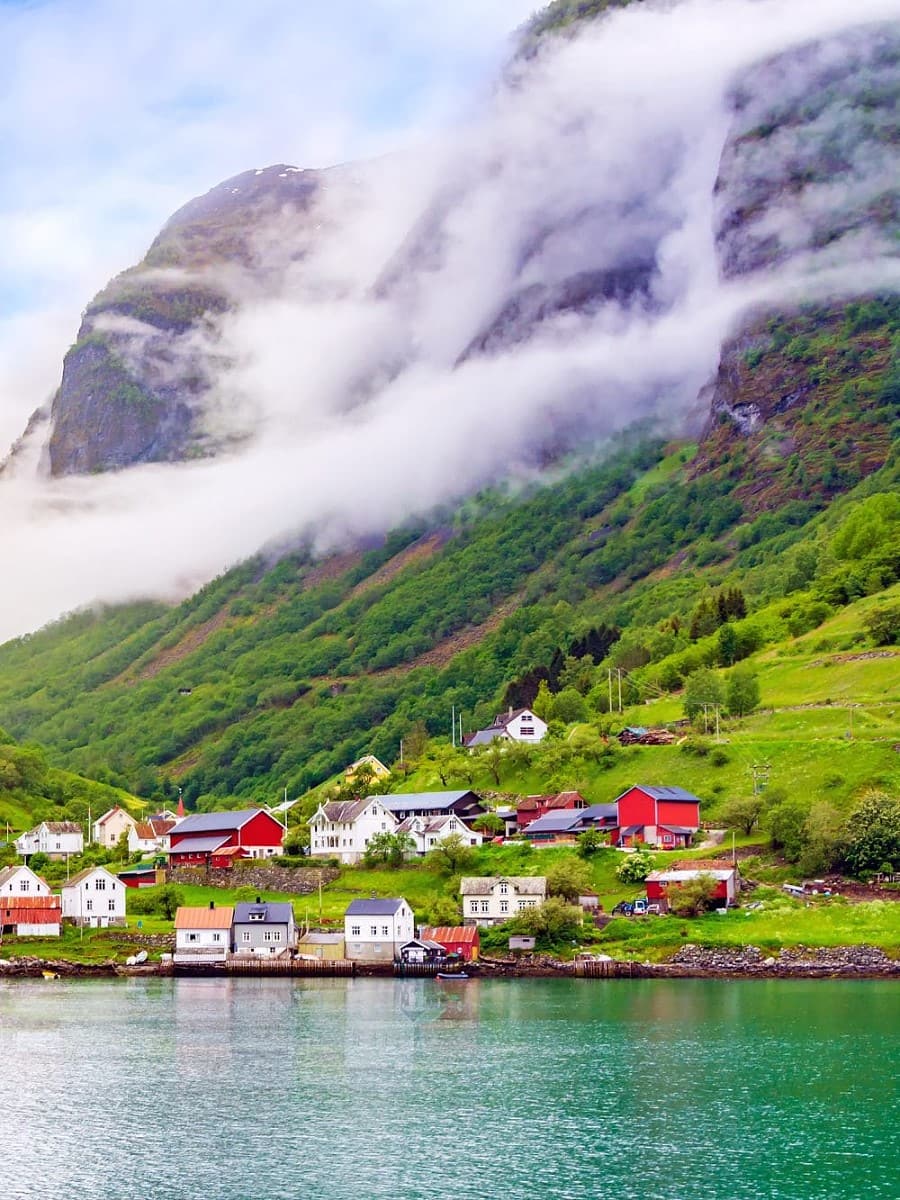
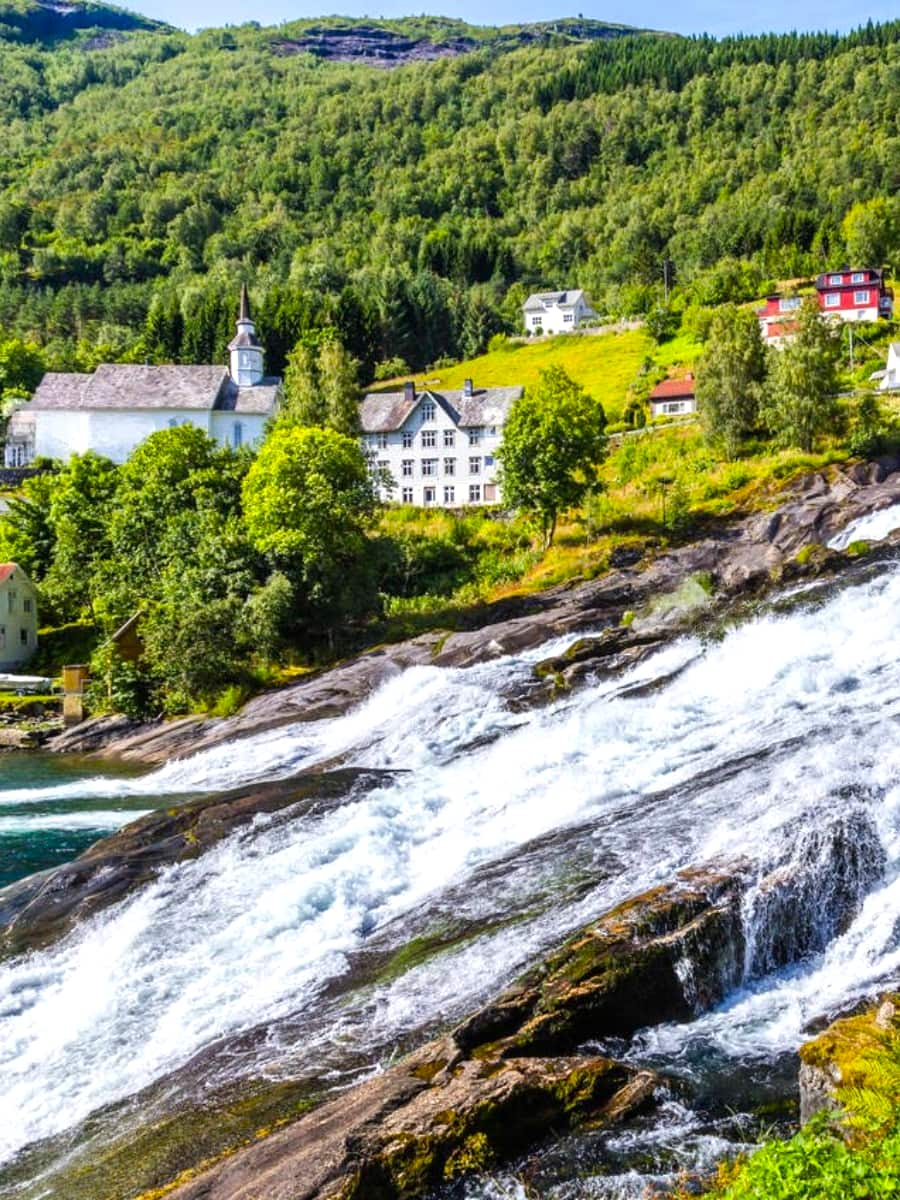
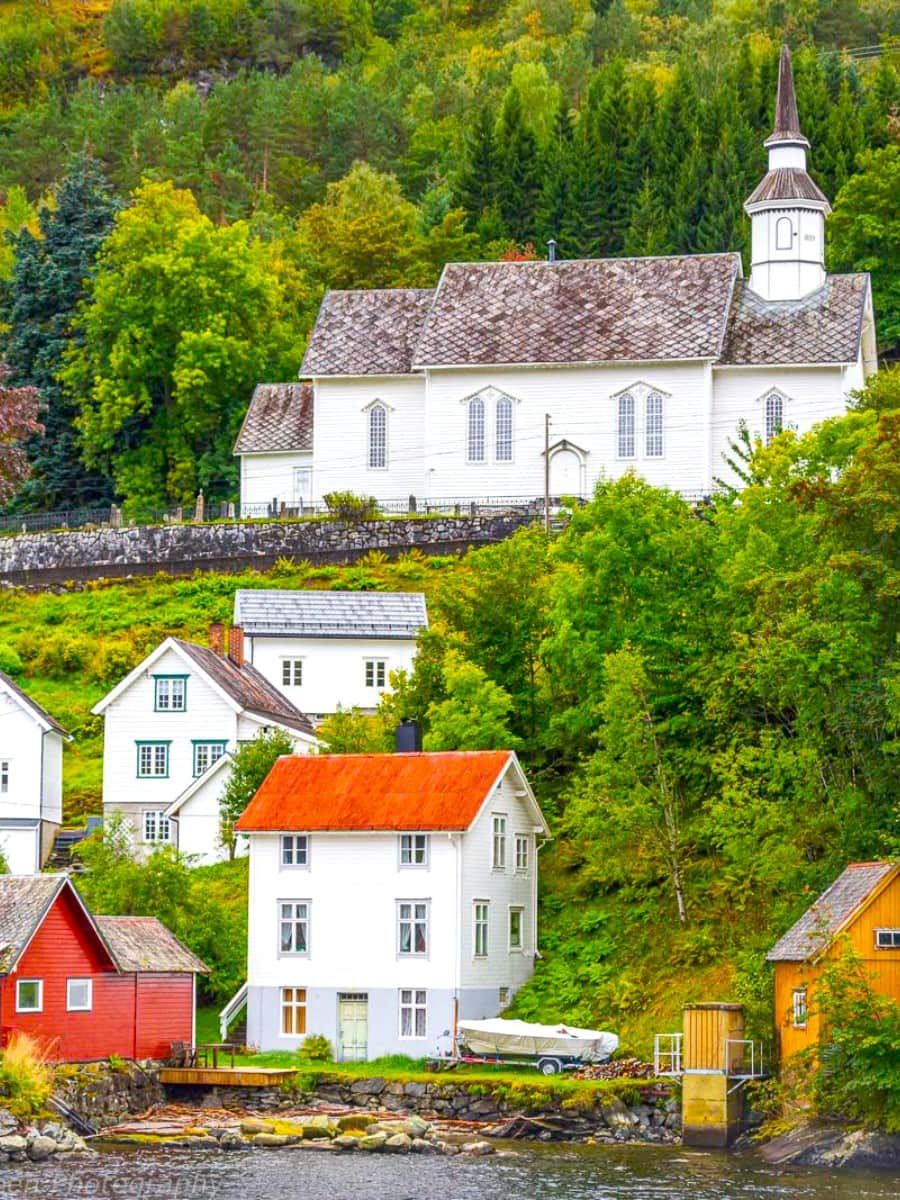
Literary connection. I was fascinated to learn that the village inspired scenes in Henrik Ibsen’s famous play “Brand.” Information boards near the waterfall explain how the dramatic landscape influenced the playwright’s vision, adding cultural depth to the natural beauty.
Hellesylt Transportation Options:
| Method | Duration | Cost | Schedule |
|---|---|---|---|
| Ferry | 50 minutes | 370 NOK (~$35) per adult | 3-5 daily (summer) |
| Driving | 1 hour | Fuel + 140 NOK ferry | Any time |
| Bus | 1.5 hours | 210 NOK (~$20) | 2 daily departures |
| Guided Tour | 5-6 hours | From 850 NOK (~$80) | Daily in summer |
Highlights:
- Central waterfall with multiple viewing platforms
- Historic wooden church (1863)
- Peer Gynt Gallery of local crafts
- Short hiking trails with fjord views
- Traditional Norwegian architecture
- Less crowded shopping for authentic souvenirs
- Starting point for longer Norangsdalen Valley drives
- Ferry terminal with connections to Geiranger
⭐ Best Activities
- Experience Beginner-Friendly Fjord Kayaking – Try kayaking in the beautiful fjords with this beginner-friendly tour, perfect for those new to the activity.
2. Nearby Fjords
Beyond Geirangerfjord. While Geirangerfjord deservedly claims the spotlight, I discovered that exploring nearby fjords offered equally stunning scenery with significantly fewer tourists. A day trip to these lesser-known waterways provided a more peaceful experience of Norway’s dramatic landscapes.
Hjørundfjord magic. Just an hour’s drive from Geiranger, Hjørundfjord quickly became my favorite discovery. This 35-kilometer-long fjord is surrounded by the jagged Sunnmøre Alps, creating a wilder, more untamed atmosphere than the more famous fjords. The small village of Sæbø made an excellent base for exploration.
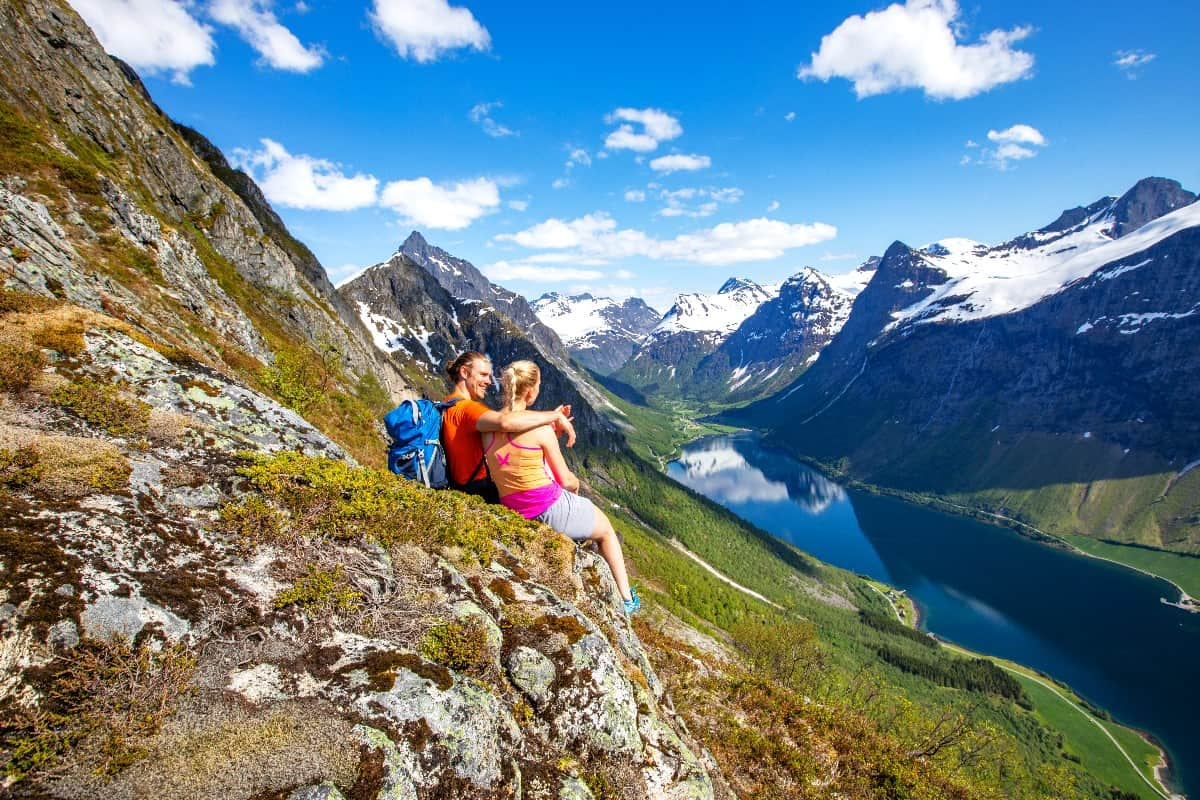
Authentic encounters. In the tiny settlements along Hjørundfjord, I experienced Norwegian fjord life without the tourist infrastructure. At a small café in Trandal (accessible only by boat), I chatted with locals who shared stories about winter isolation and summer farming traditions that continue today.
Nearby Fjords Comparison:
| Fjord | Distance from Geiranger | Highlights | Crowd Level |
|---|---|---|---|
| Hjørundfjord | 1 hour | Jagged mountains, authentic villages | Very low |
| Nordalsfjord | 45 minutes | Floating salmon farms, kayaking | Low |
| Tafjord | 1.5 hours | Power plant museum, dramatic road | Very low |
| Storfjord | 30 minutes | Broader waterway, island views | Moderate |
| Synnylvsfjord | 50 minutes | Hellesylt waterfall, valley views | Moderate |
Activity options. Each fjord offers different experiences – I particularly enjoyed kayaking on the calm waters of Nordalsfjord (rental: 450 NOK/~$43 for 3 hours) and hiking to panoramic viewpoints above Tafjord on well-marked but uncrowded trails.
Practical advice. Having your own vehicle is essential for exploring these areas effectively, as public transportation is limited. I found that packing a picnic lunch allowed for maximum flexibility, though each fjord has at least one small café or grocery store for basic provisions.
Best Viewpoints of Nearby Fjords:
- Ørnevegen viewpoint (Hjørundfjord)
- Ljøen overlook (Synnylvsfjord)
- Tafjord road hairpin turns
- Stranda ski resort summer lift (Storfjord)
- Liabygda ferry crossing (Nordalsfjord)
- Overåseter mountain farm (Hjørundfjord)
- Villa Norangdal historic hotel (Norangdal Valley)
⭐ Best Activities
- Geiranger Shore Excursions: Geiranger Highlights – Discover the best of Geiranger on this shore excursion that showcases the area’s most impressive viewpoints and natural attractions.
FAQ
What makes the village of Geiranger so special?
Geiranger is a charming small village with less than 300 inhabitants, nestled between tall mountains at the head of the UNESCO-protected Geirangerfjord. Despite its small size, it welcomes thousands of tourists daily during summer months, making it the second biggest cruise port in Norway after Bergen.
How long does a fjord cruise in Geirangerfjord take?
There are different cruise options ranging from 60-minute tours that show you the main sights and waterfalls to 90-minute tours that cover the entire 16 km length of the fjord. The ferry journey between Geiranger and Hellesylt takes approximately 1 hour and 5 minutes, allowing you to experience all the highlights of the UNESCO World Heritage-listed fjord.
What will I see during a Norwegian fjords cruise?
During your cruise, you’ll witness dramatic cliffs, deep blue waters, and cascading waterfalls including the famous Seven Sisters and The Suitor waterfalls. You’ll also spot abandoned mountain farms clinging to steep mountainsides that have remained largely untouched in modern times and are only accessible by boat or foot.
